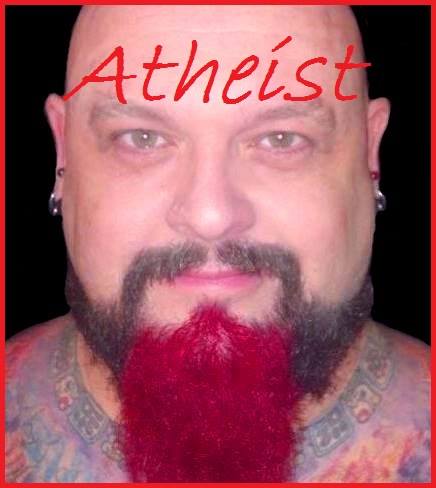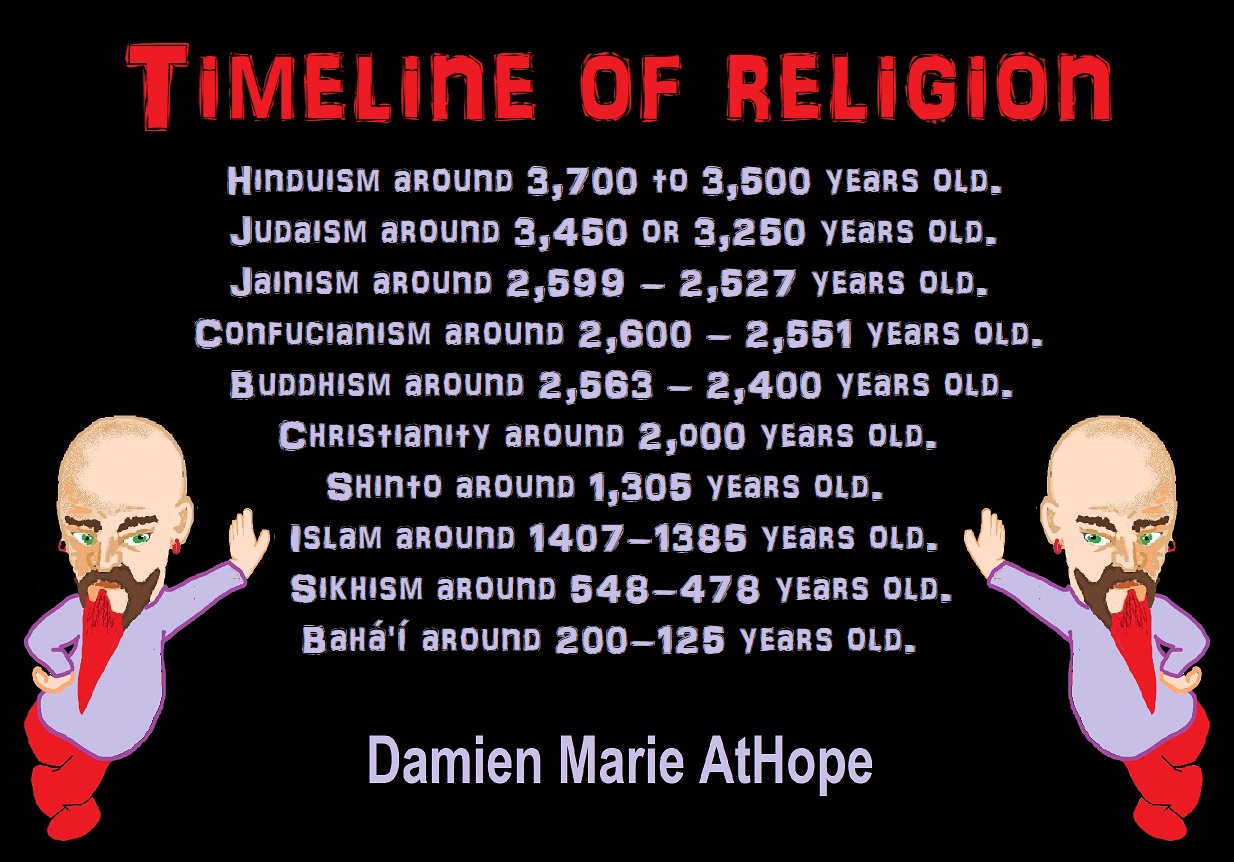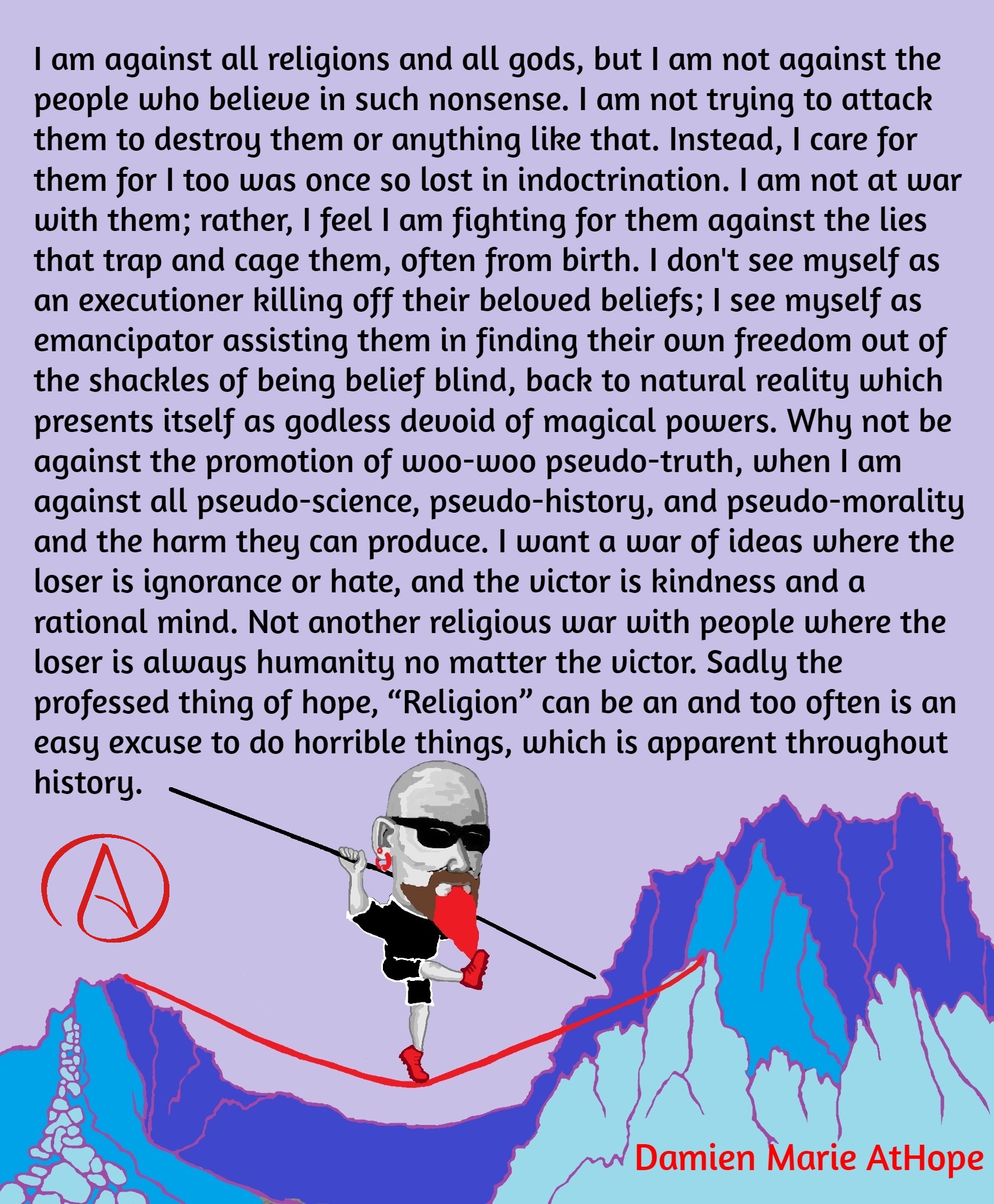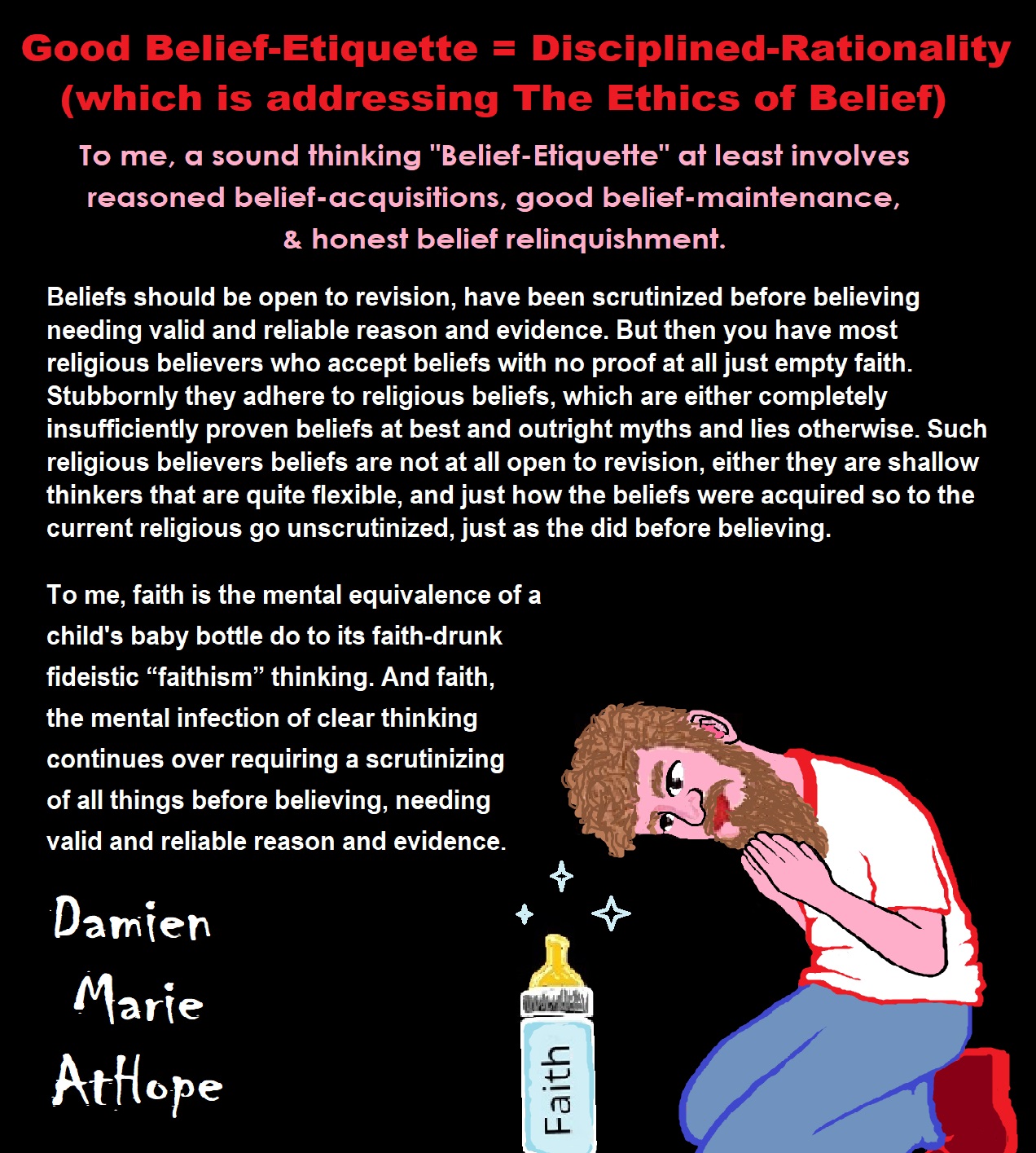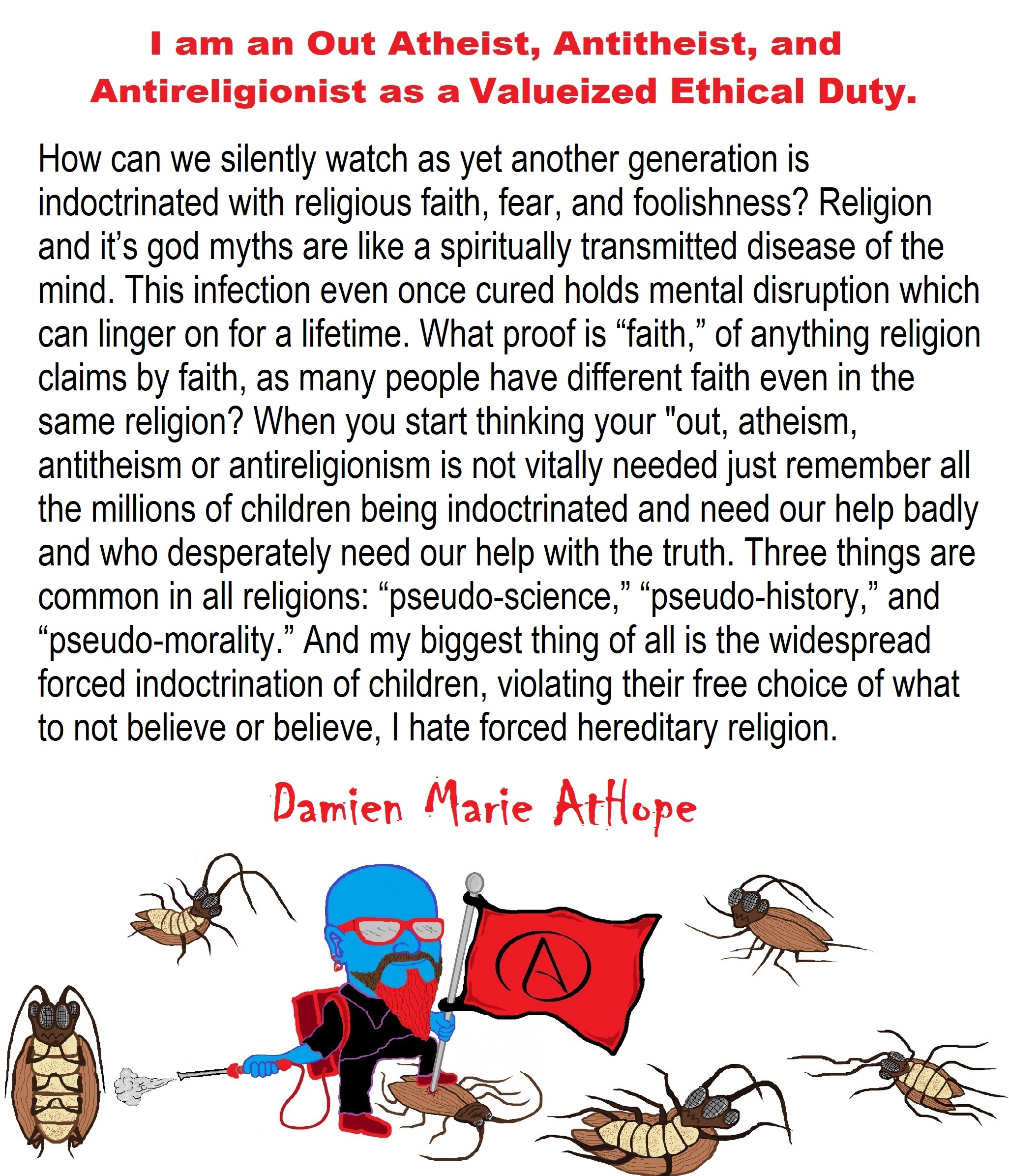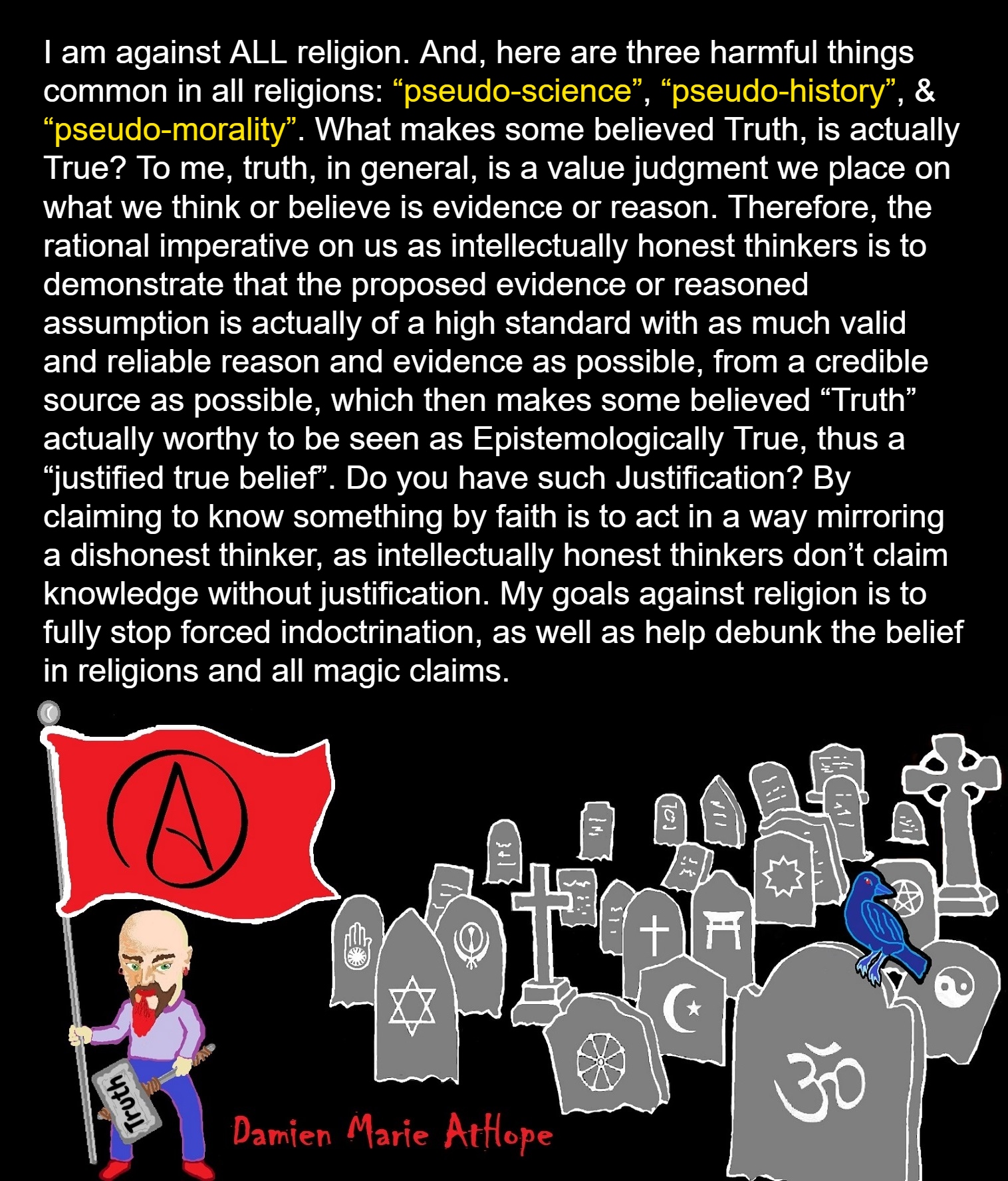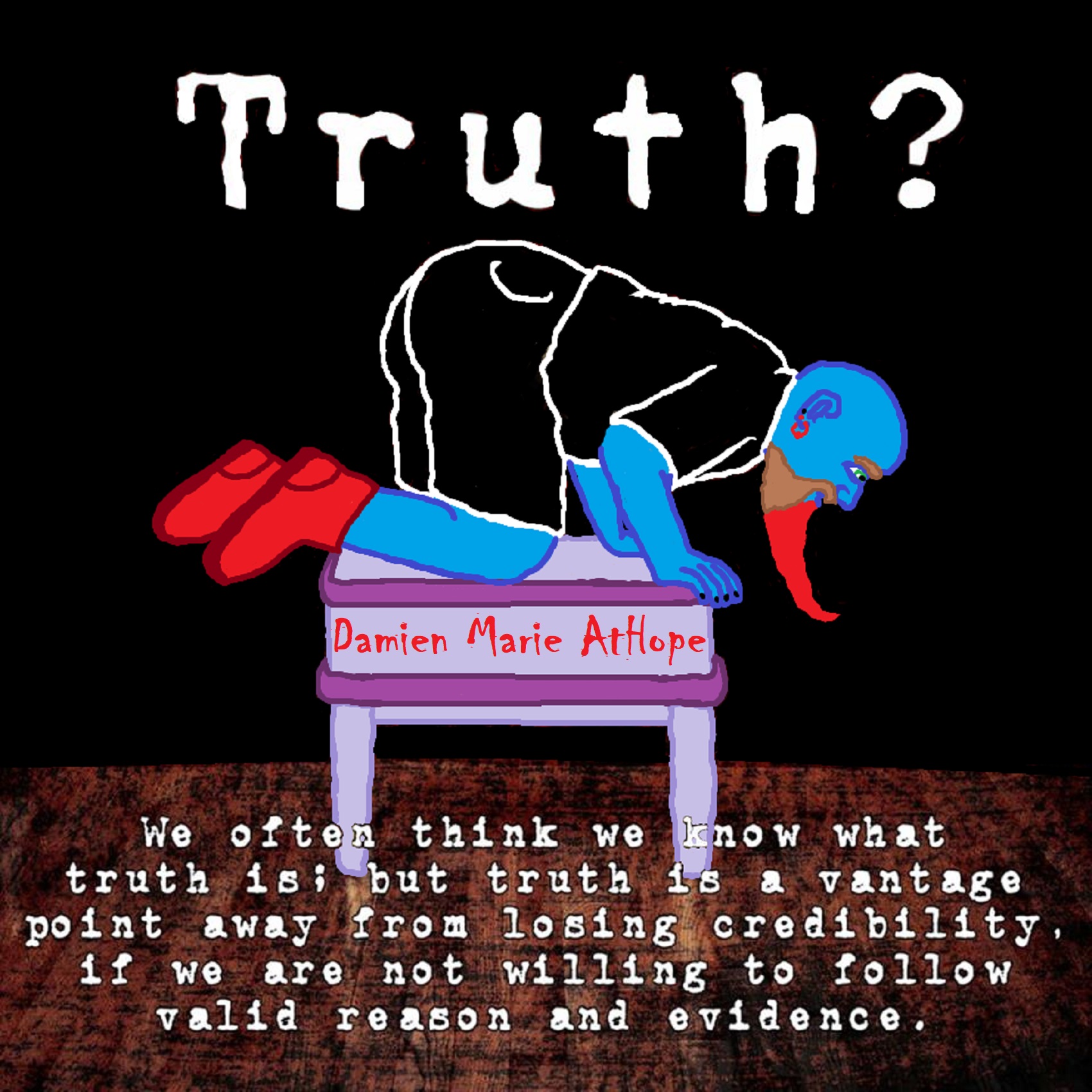
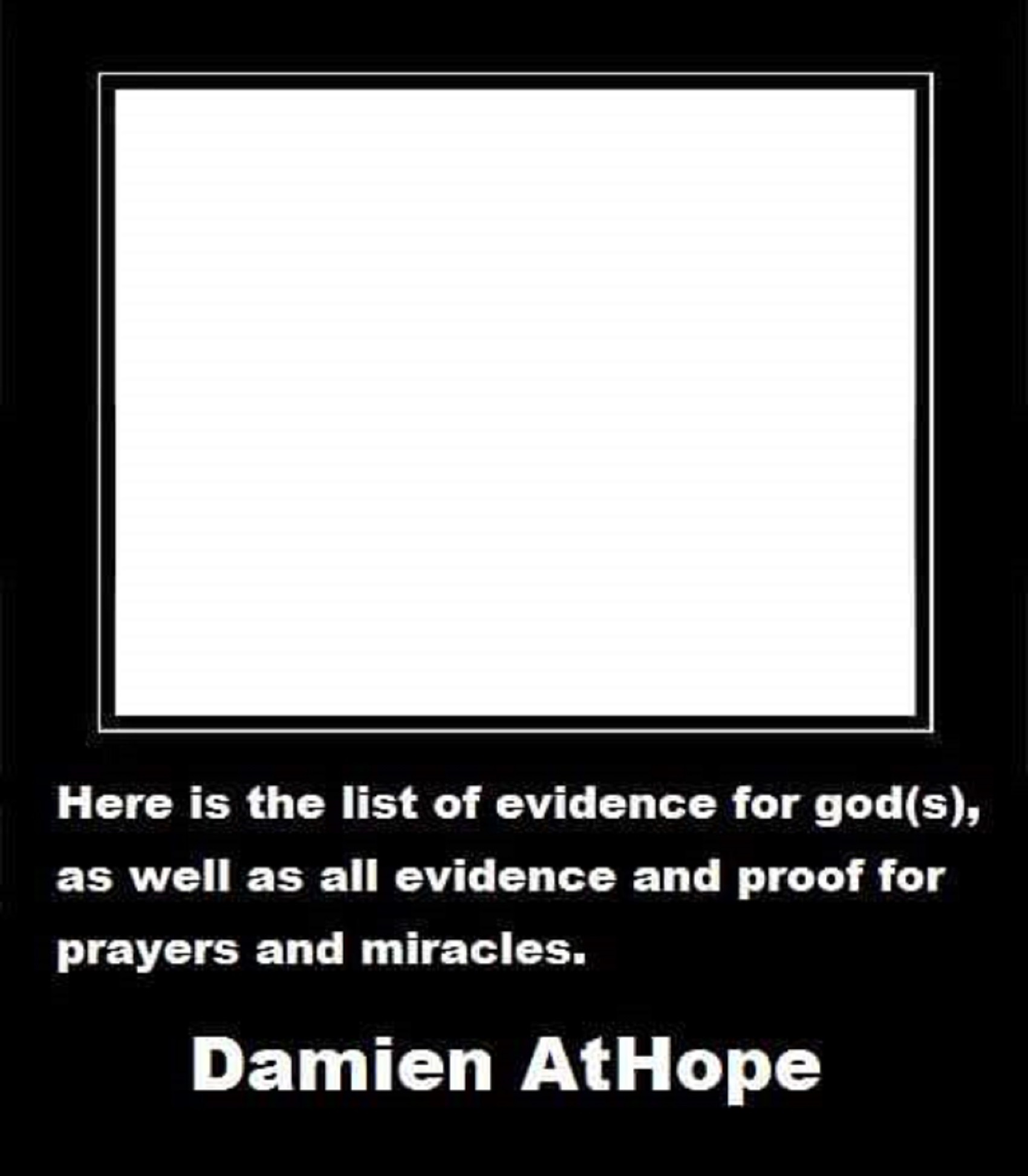

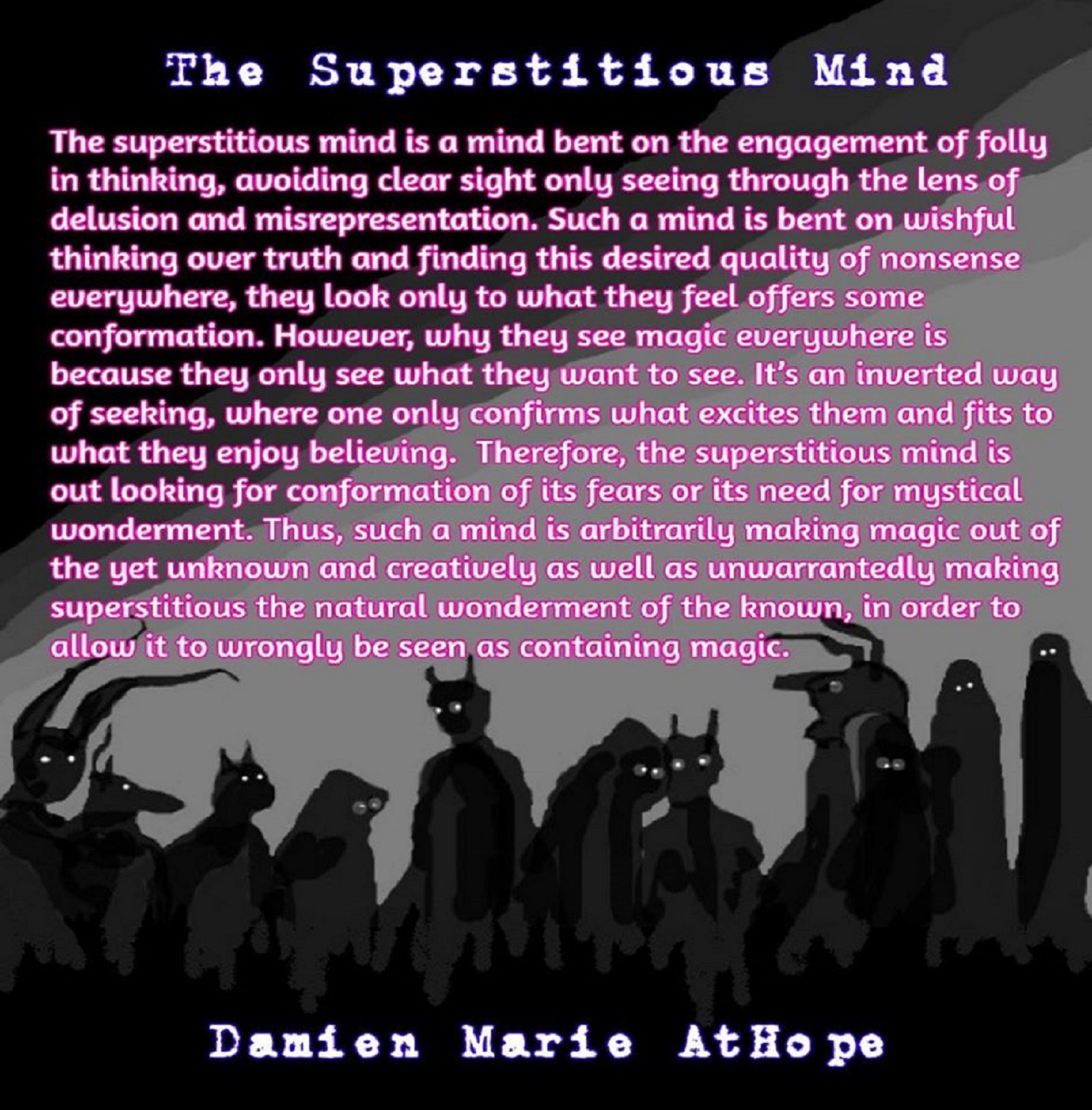
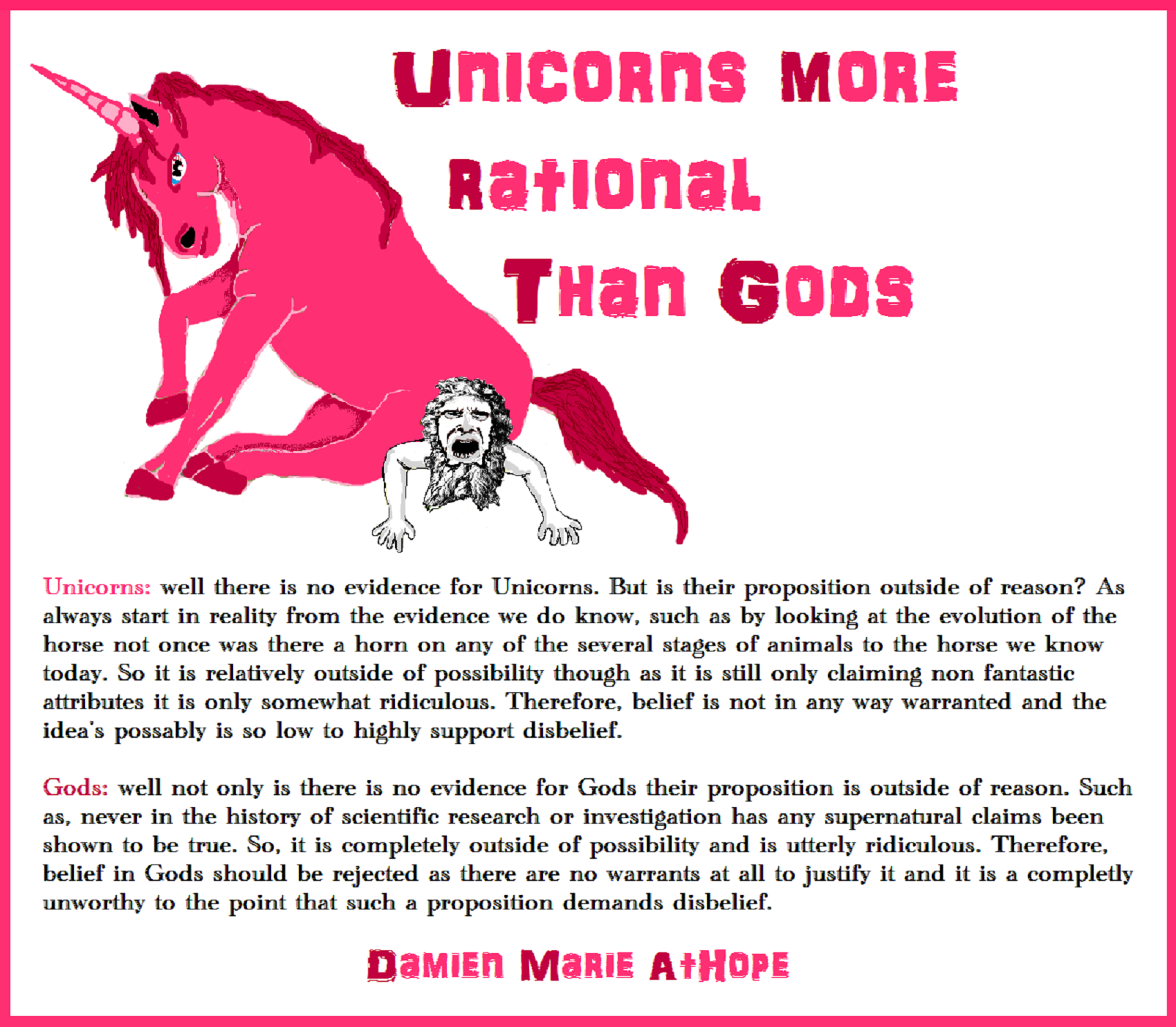
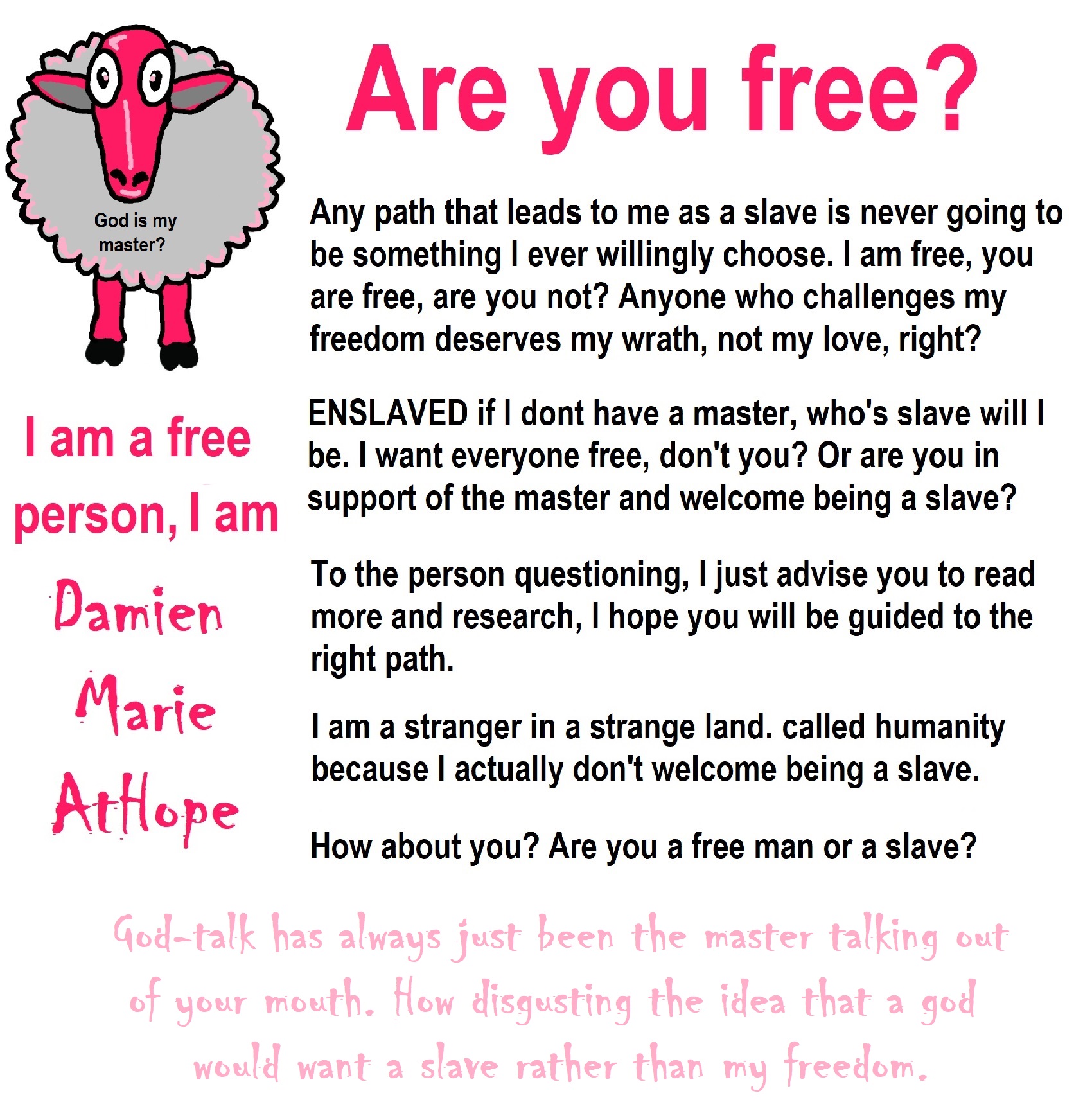

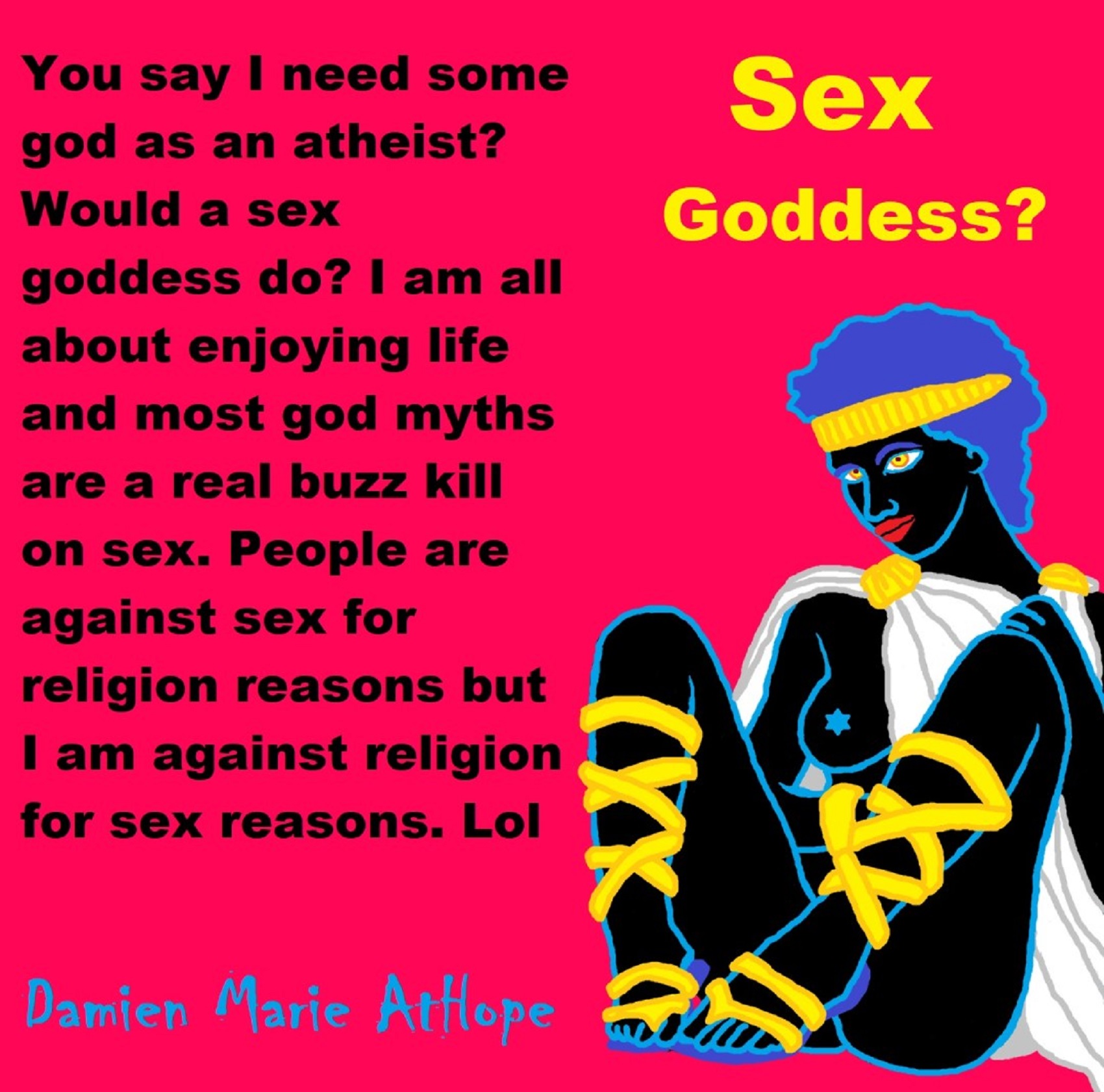
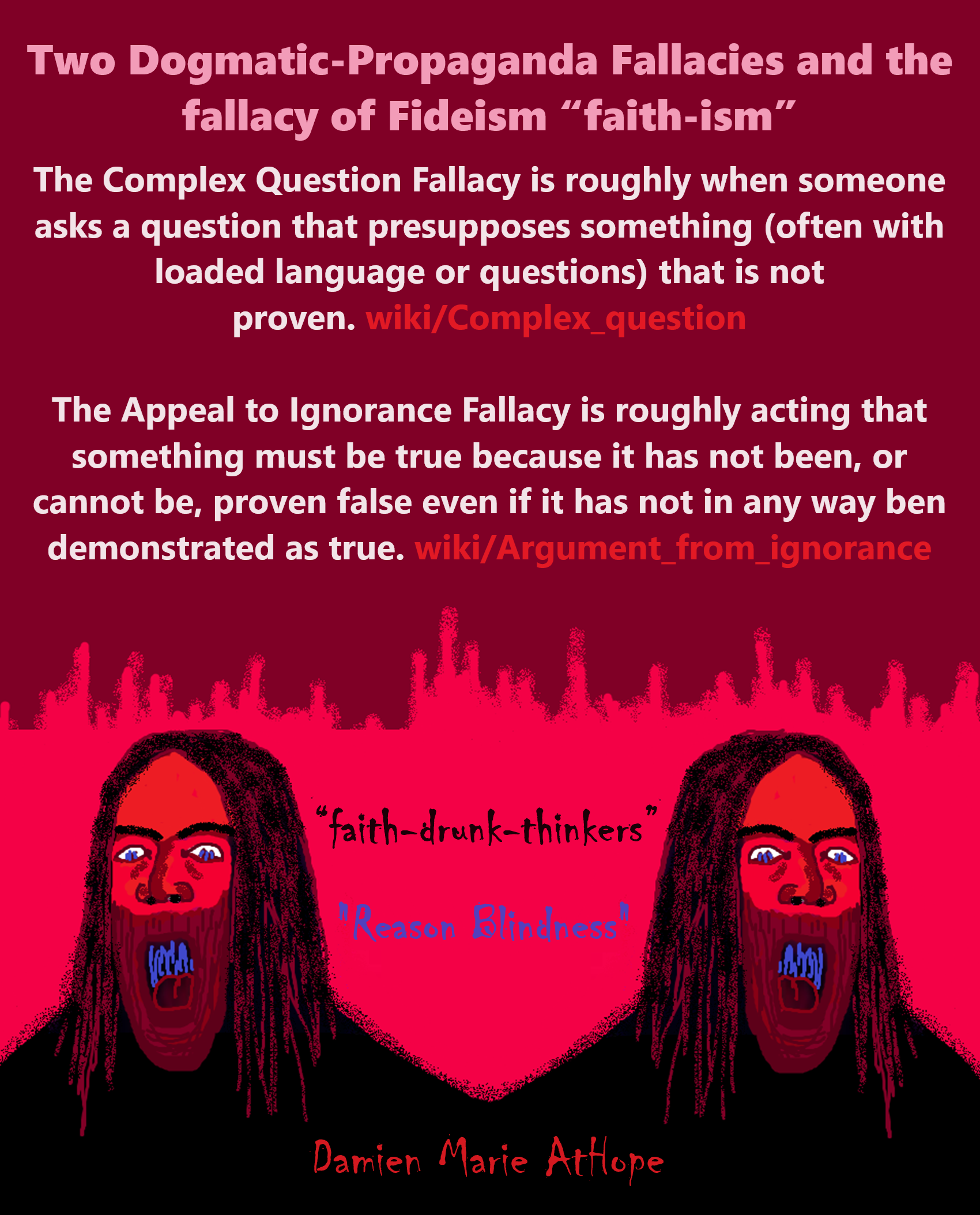
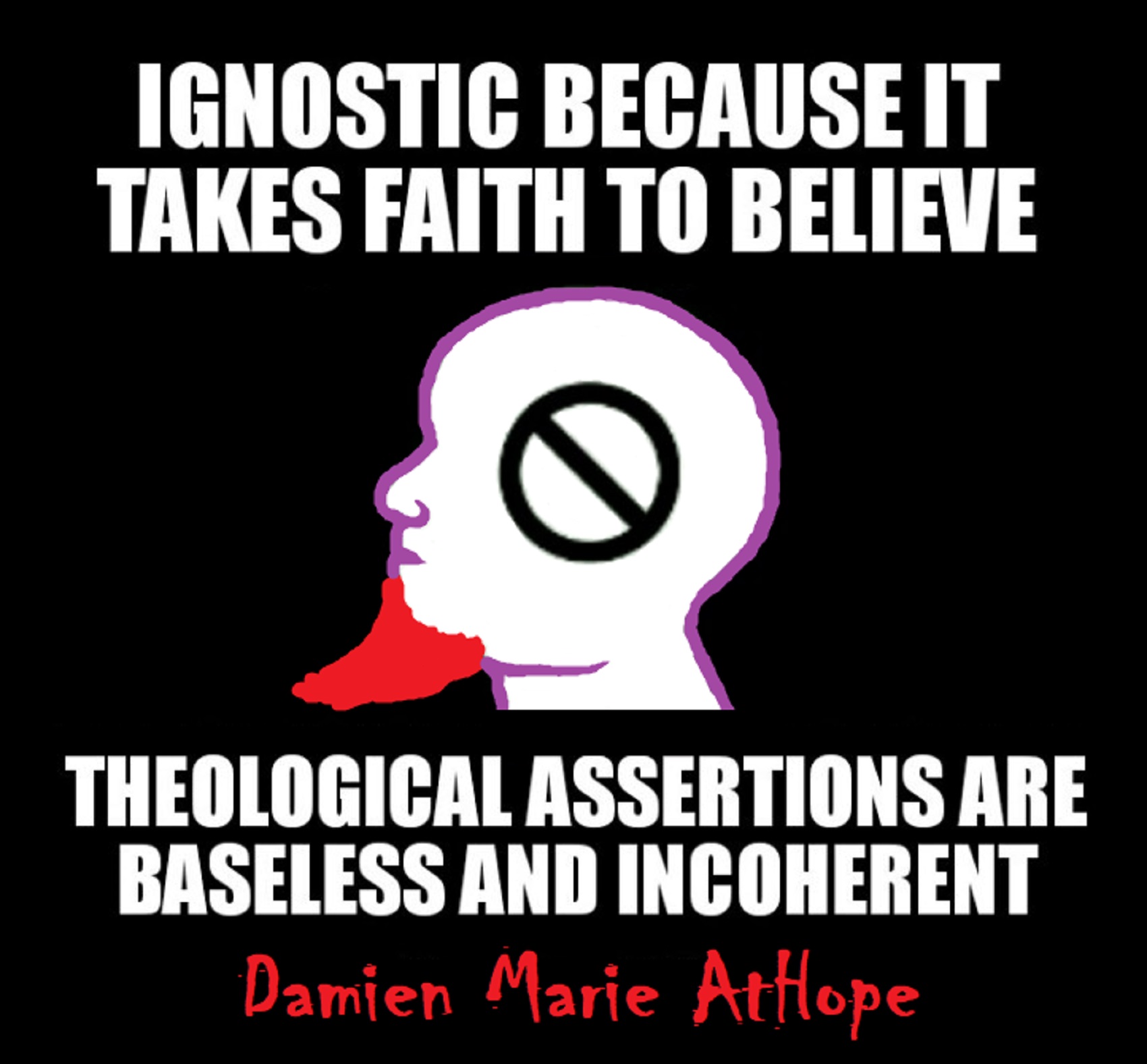

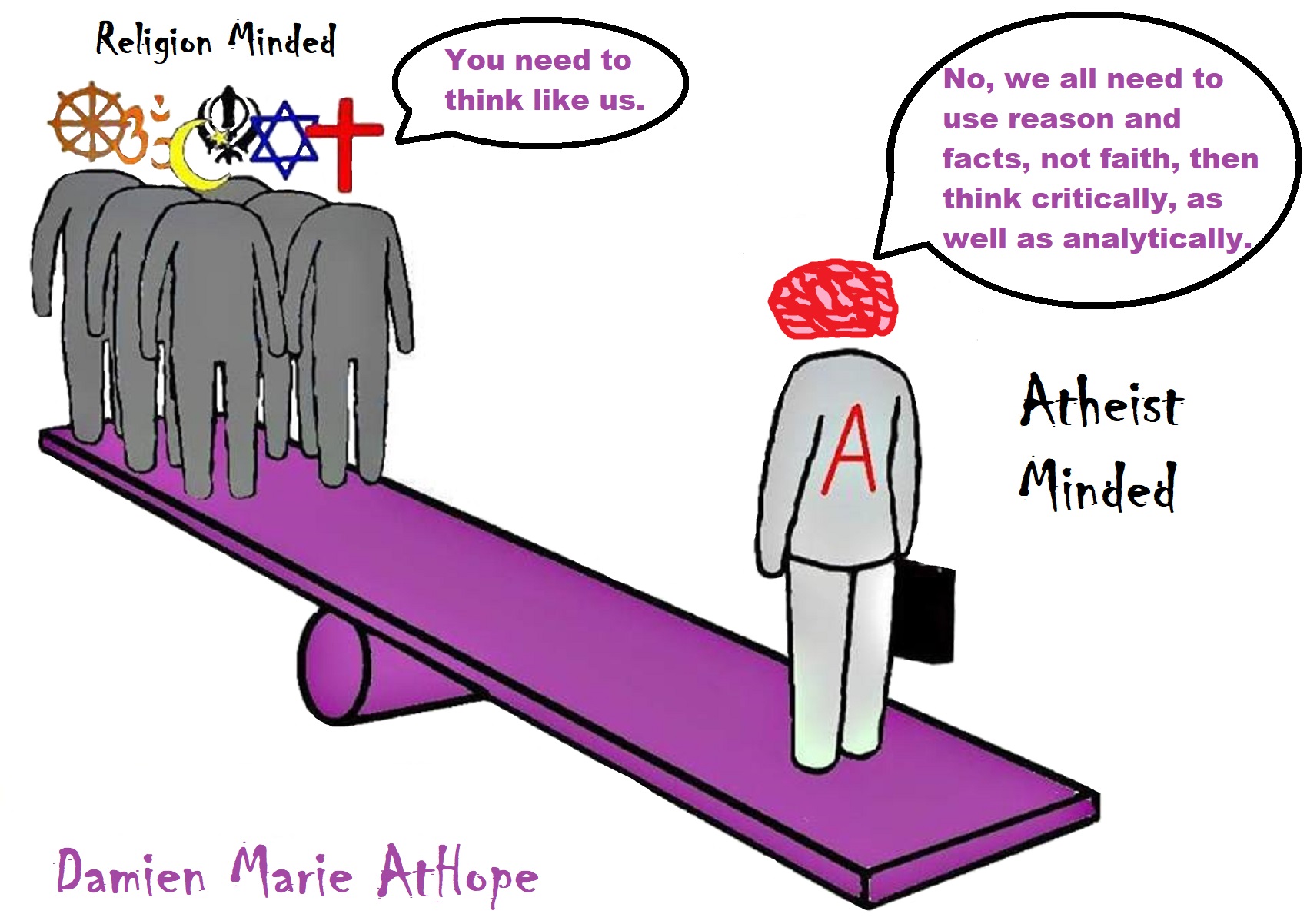
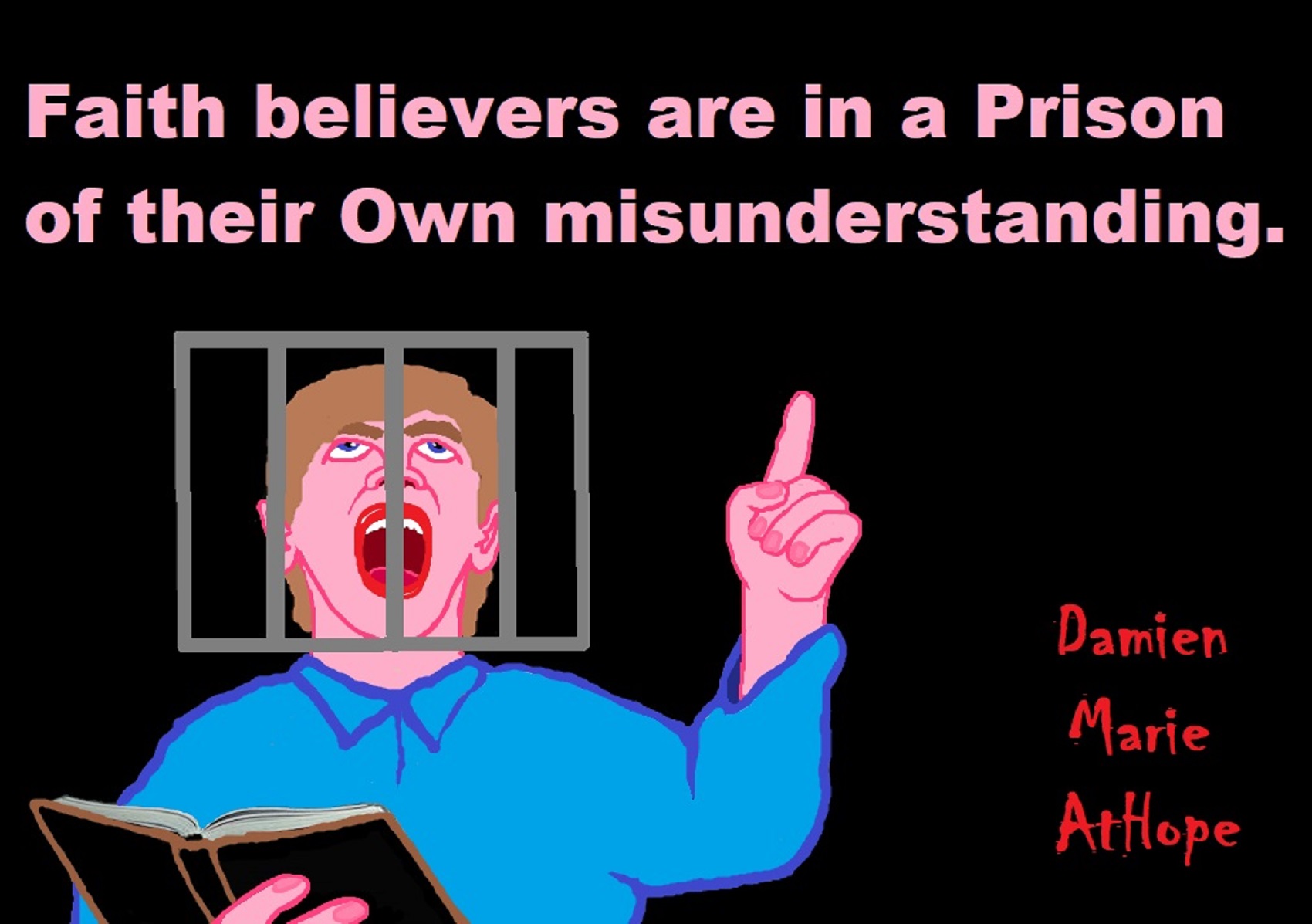
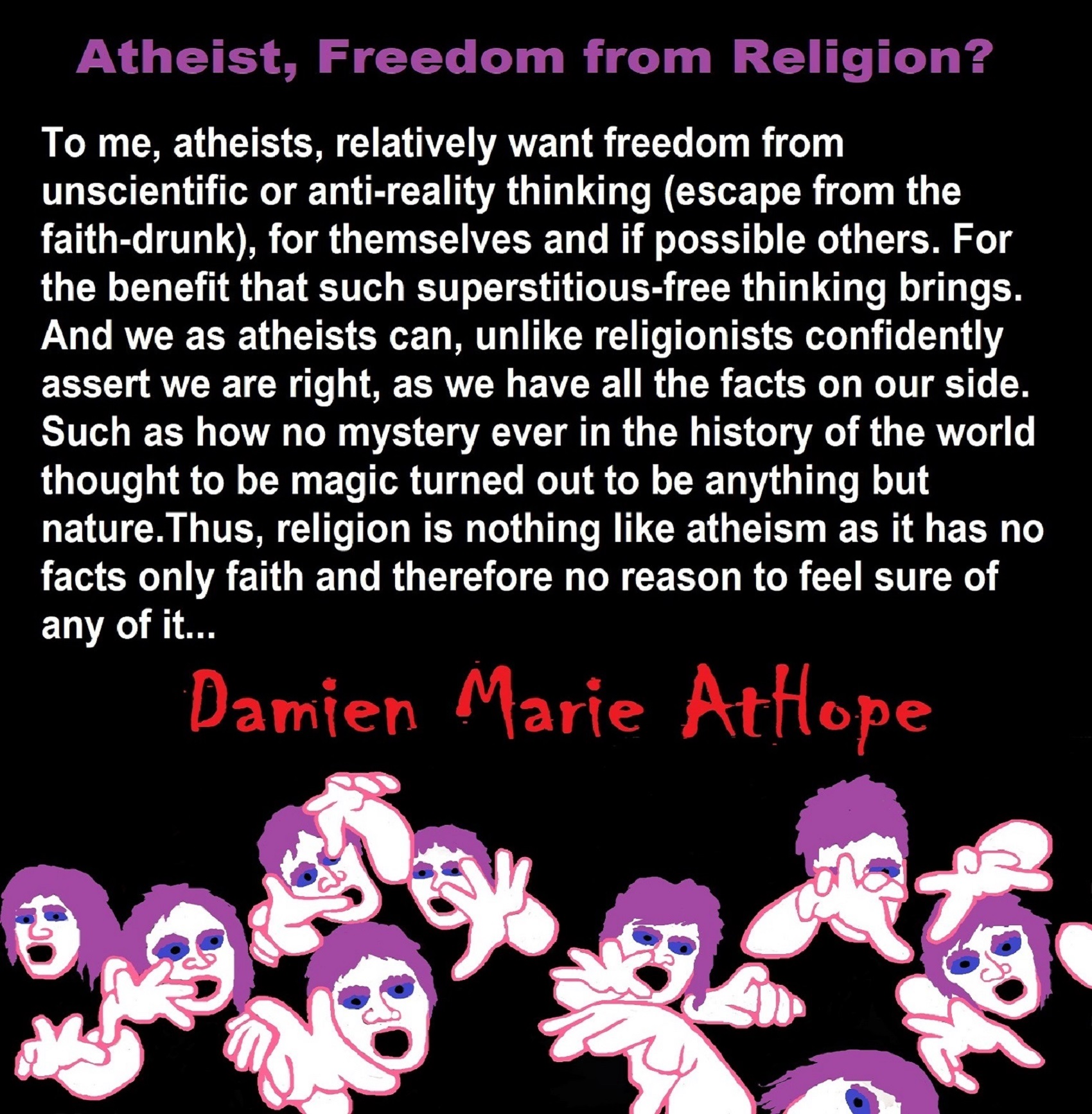
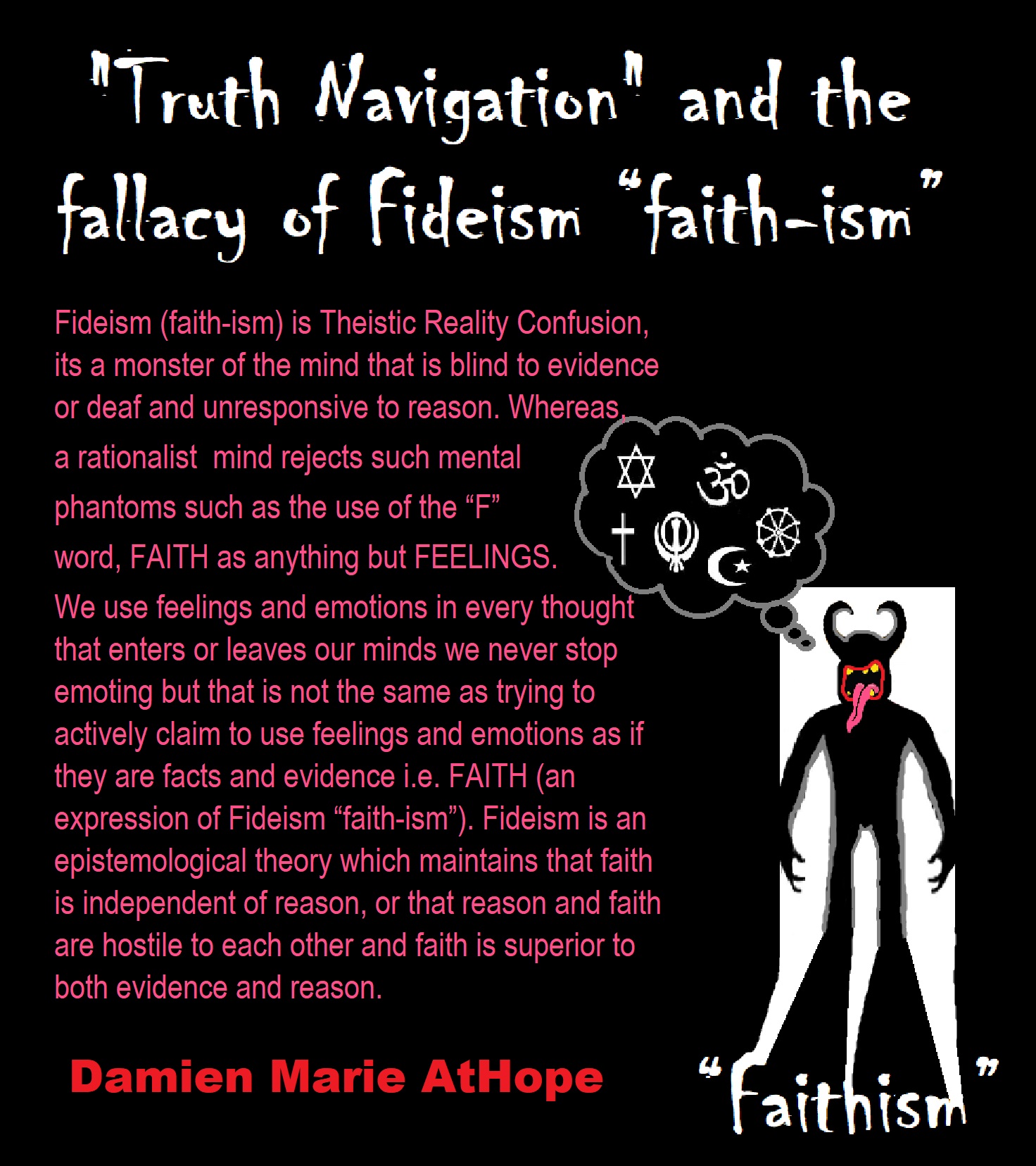
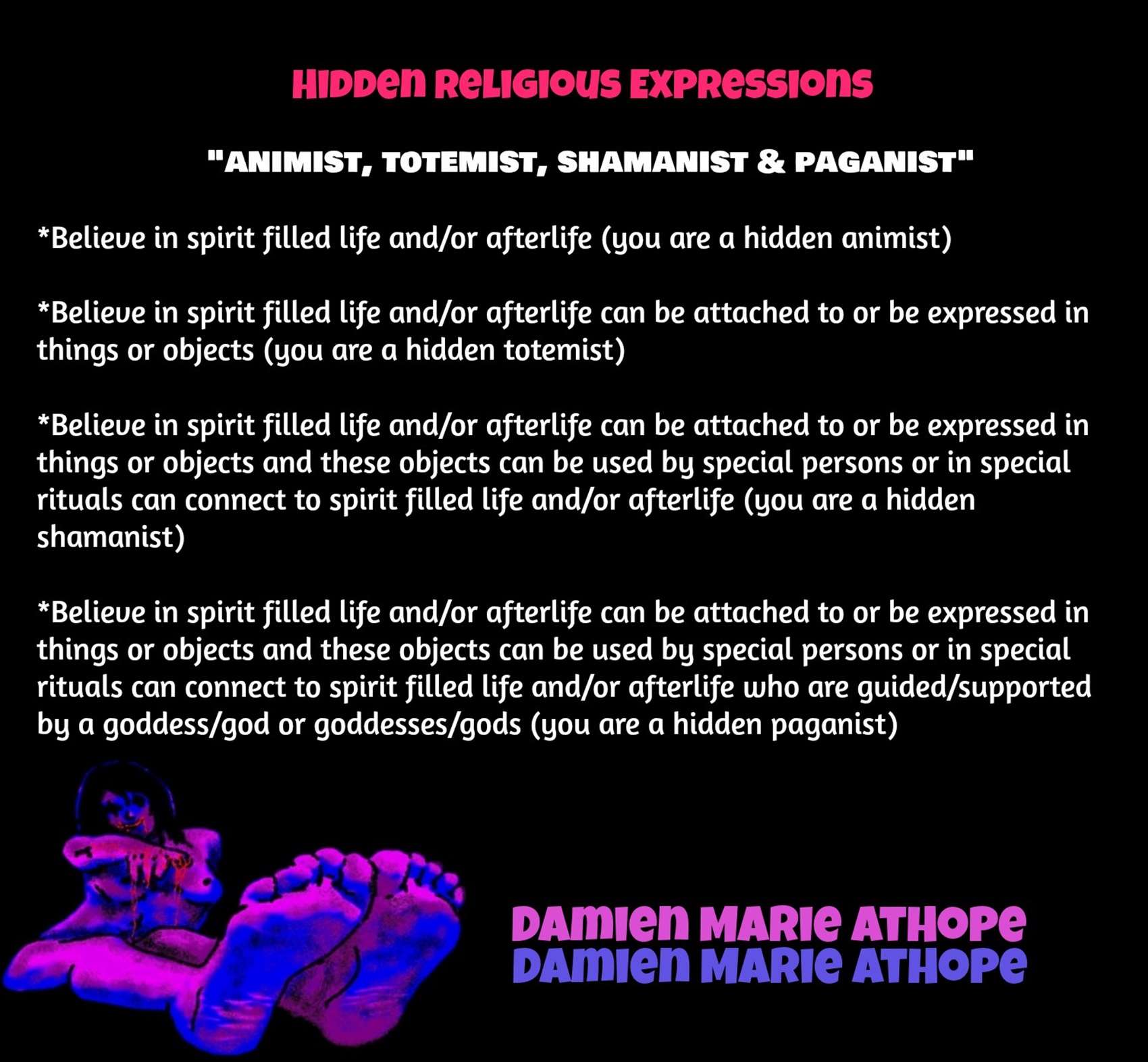
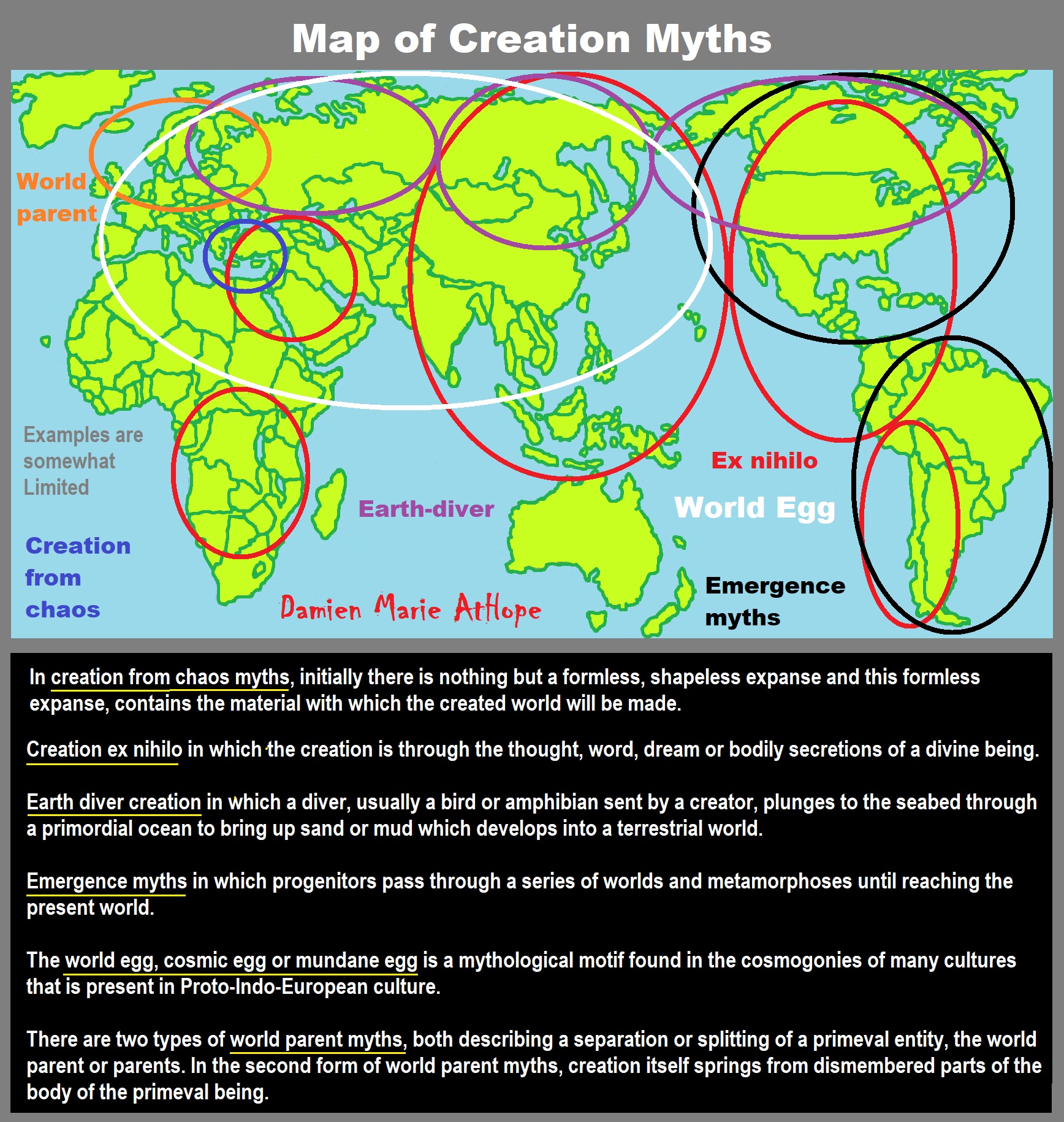
Creation myths: From chaos, Ex nihilo, Earth-diver, Emergence, World egg, and World parent
“A creation myth (or cosmogonic myth) is a symbolic narrative of how the world began and how people first came to inhabit it. While in popular usage the term myth often refers to false or fanciful stories, members of cultures often ascribe varying degrees of truth to their creation myths. In the society in which it is told, a creation myth is usually regarded as conveying profound truths – metaphorically, symbolically, historically, or literally. They are commonly, although not always, considered cosmogonical myths – that is, they describe the ordering of the cosmos from a state of chaos or amorphousness.” ref
“Creation myths often share a number of features. They often are considered sacred accounts and can be found in nearly all known religious traditions. They are all stories with a plot and characters who are either deities, human-like figures, or animals, who often speak and transform easily. They are often set in a dim and nonspecific past that historian of religion Mircea Eliade termed in illo tempore (‘at that time’). Creation myths address questions deeply meaningful to the society that shares them, revealing their central worldview and the framework for the self-identity of the culture and individual in a universal context. Creation myths develop in oral traditions and therefore typically have multiple versions; found throughout human culture, they are the most common form of myth.” ref
Creation myth definitions from modern references:
- “A “symbolic narrative of the beginning of the world as understood in a particular tradition and community. Creation myths are of central importance for the valuation of the world, for the orientation of humans in the universe, and for the basic patterns of life and culture.”
- “Creation myths tell us how things began. All cultures have creation myths; they are our primary myths, the first stage in what might be called the psychic life of the species. As cultures, we identify ourselves through the collective dreams we call creation myths, or cosmogonies. … Creation myths explain in metaphorical terms our sense of who we are in the context of the world, and in so doing they reveal our real priorities, as well as our real prejudices. Our images of creation say a great deal about who we are.”
- A “philosophical and theological elaboration of the primal myth of creation within a religious community. The term myth here refers to the imaginative expression in narrative form of what is experienced or apprehended as basic reality … The term creation refers to the beginning of things, whether by the will and act of a transcendent being, by emanation from some ultimate source, or in any other way.” ref
Religion professor Mircea Eliade defined the word myth in terms of creation:
“Myth narrates a sacred history; it relates an event that took place in primordial Time, the fabled time of the “beginnings.” In other words, myth tells how, through the deeds of Supernatural Beings, a reality came into existence, be it the whole of reality, the Cosmos, or only a fragment of reality – an island, a species of plant, a particular kind of human behavior, an institution.” ref
“All creation myths are in one sense etiological because they attempt to explain how the world formed and where humanity came from. Myths attempt to explain the unknown and sometimes teach a lesson.” ref
“Some Ethnologists and anthropologists who study origin myths say that in the modern context theologians try to discern humanity’s meaning from revealed truths and scientists investigate cosmology with the tools of empiricism and rationality, but creation myths define human reality in very different terms. In the past, historians of religion and other students of myth thought of such stories as forms of primitive or early-stage science or religion and analyzed them in a literal or logical sense. Today, however, they are seen as symbolic narratives which must be understood in terms of their own cultural context. Charles Long writes: “The beings referred to in the myth – gods, animals, plants – are forms of power grasped existentially. The myths should not be understood as attempts to work out a rational explanation of deity.” ref
“While creation myths are not literal explications, they do serve to define an orientation of humanity in the world in terms of a birth story. They provide the basis of a worldview that reaffirms and guides how people relate to the natural world, to any assumed spiritual world, and to each other. A creation myth acts as a cornerstone for distinguishing primary reality from relative reality, the origin and nature of being from non-being. In this sense, cosmogonic myths serve as a philosophy of life – but one expressed and conveyed through symbol rather than through systematic reason. And in this sense, they go beyond etiological myths (which explain specific features in religious rites, natural phenomena, or cultural life). Creation myths also help to orient human beings in the world, giving them a sense of their place in the world and the regard that they must have for humans and nature.” ref
Historian David Christian has summarised issues common to multiple creation myths:
“Each beginning seems to presuppose an earlier beginning. … Instead of meeting a single starting point, we encounter an infinity of them, each of which poses the same problem. … There are no entirely satisfactory solutions to this dilemma. What we have to find is not a solution but some way of dealing with the mystery …. And we have to do so using words. The words we reach for, from God to gravity, are inadequate to the task. So we have to use language poetically or symbolically; and such language, whether used by a scientist, a poet, or a shaman, can easily be misunderstood.” ref
“Mythologists have applied various schemes to classify creation myths found throughout human cultures. Eliade and his colleague Charles Long developed a classification based on some common motifs that reappear in stories the world over. The classification identifies five basic types: Brahmā, the Hindu deva of creation, emerges from a lotus risen from the navel of Viṣņu, who lies with Lakshmi on the serpent Ananta Shesha.” ref
- “Creation ex nihilo in which the creation is through the thought, word, dream, or bodily secretions of a divine being.
- Earth diver creation in which a diver, usually a bird or amphibian sent by a creator, plunges to the seabed through a primordial ocean to bring up sand or mud which develops into a terrestrial world.
- Emergence myths in which progenitors pass through a series of worlds and metamorphoses until reaching the present world.
- Creation by the dismemberment of a primordial being.
- Creation by the splitting or ordering of a primordial unity such as the cracking of a cosmic egg or a bringing order from chaos.” ref
“Marta Weigle further developed and refined this typology to highlight nine themes, adding elements such as deus faber, a creation crafted by a deity, creation from the work of two creators working together or against each other, creation from sacrifice, and creation from division/conjugation, accretion/conjunction, or secretion.” ref
An alternative system based on six recurring narrative themes was designed by Raymond Van Over:
- “Primeval abyss, an infinite expanse of waters or space.
- Originator deity which is awakened or an eternal entity within the abyss.
- Originator deity poised above the abyss.
- Cosmic egg or embryo.
- Originator deity creating life through sound or word.
- Life generating from the corpse or dismembered parts of an originator deity.” ref
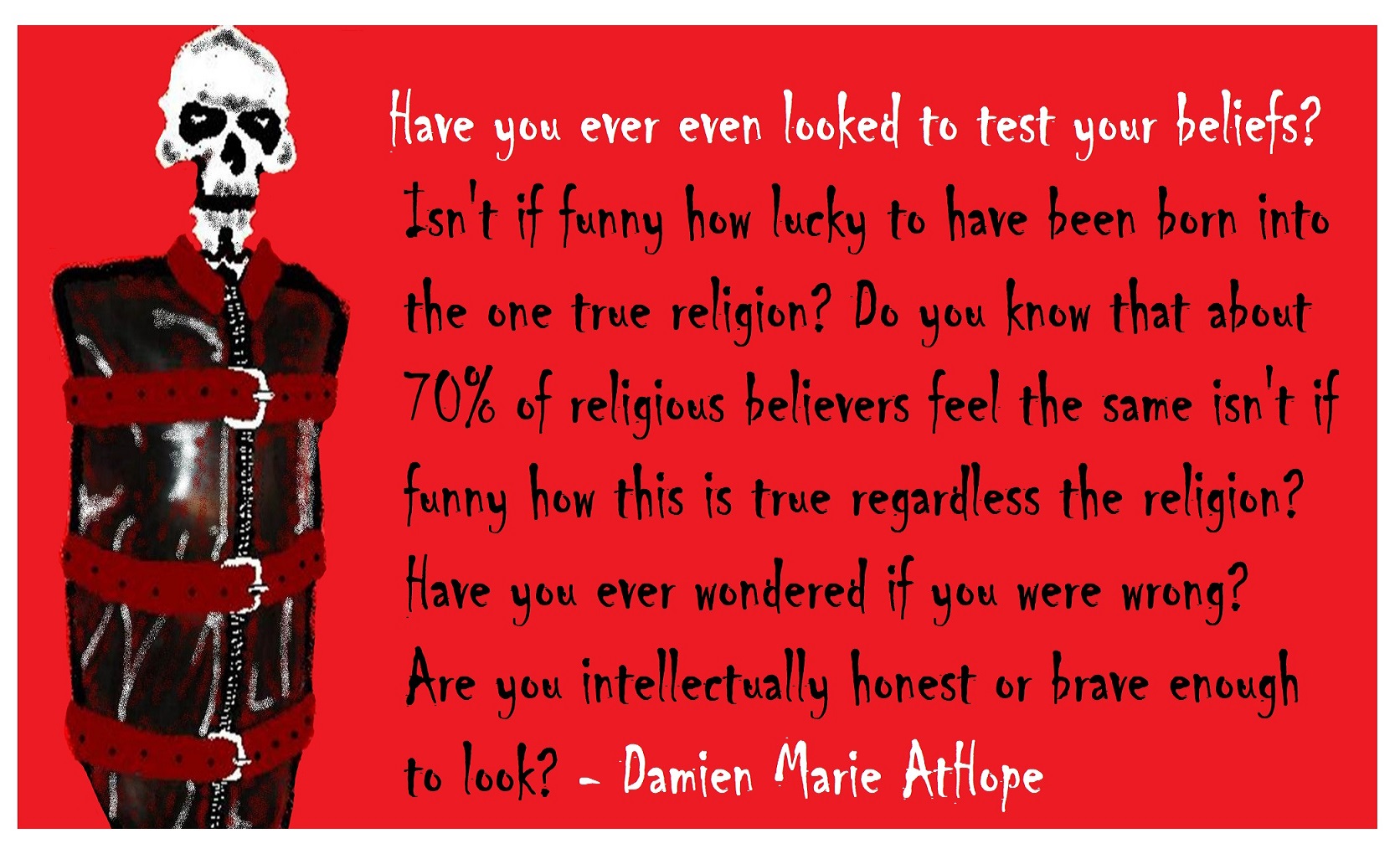
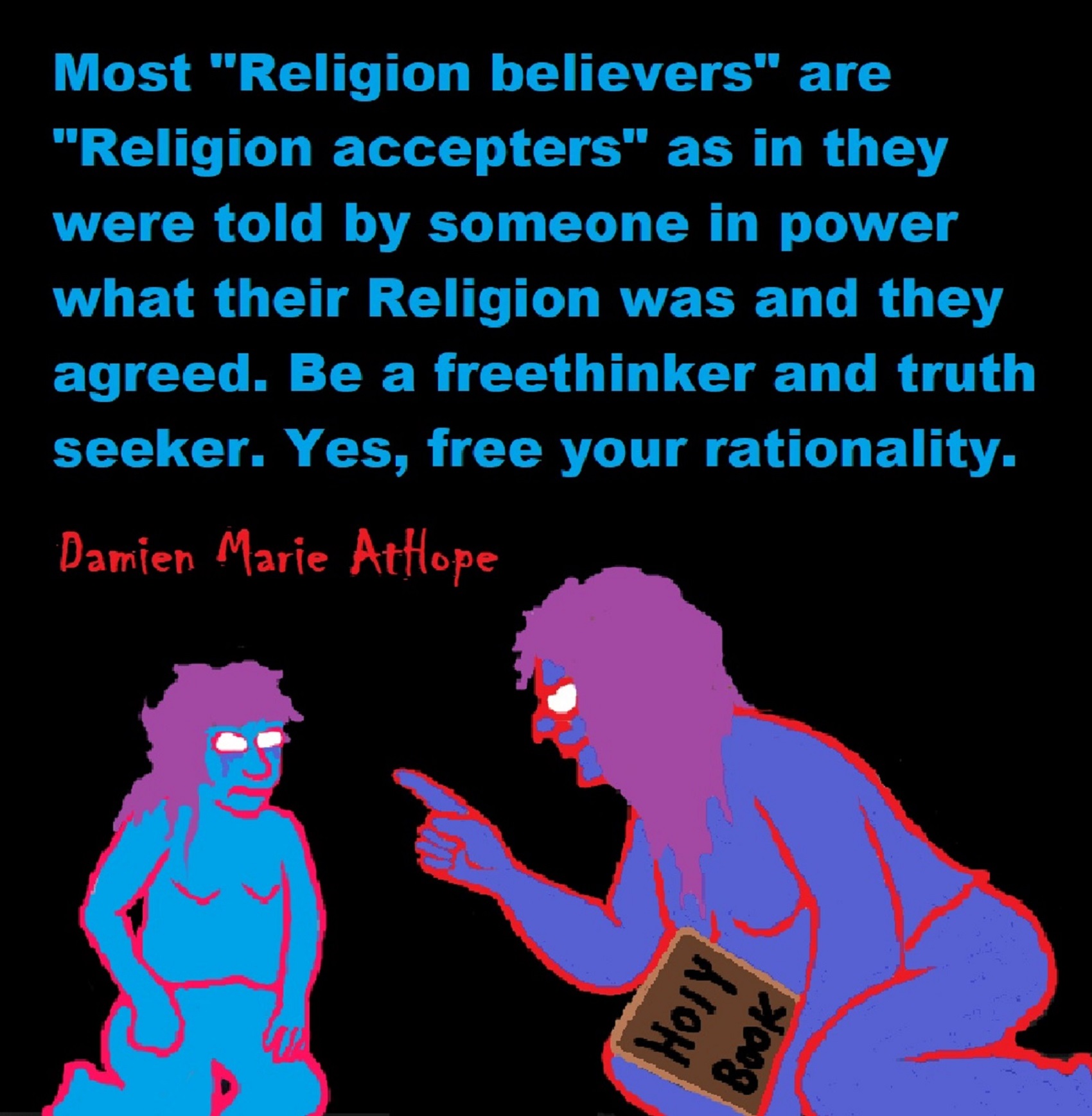
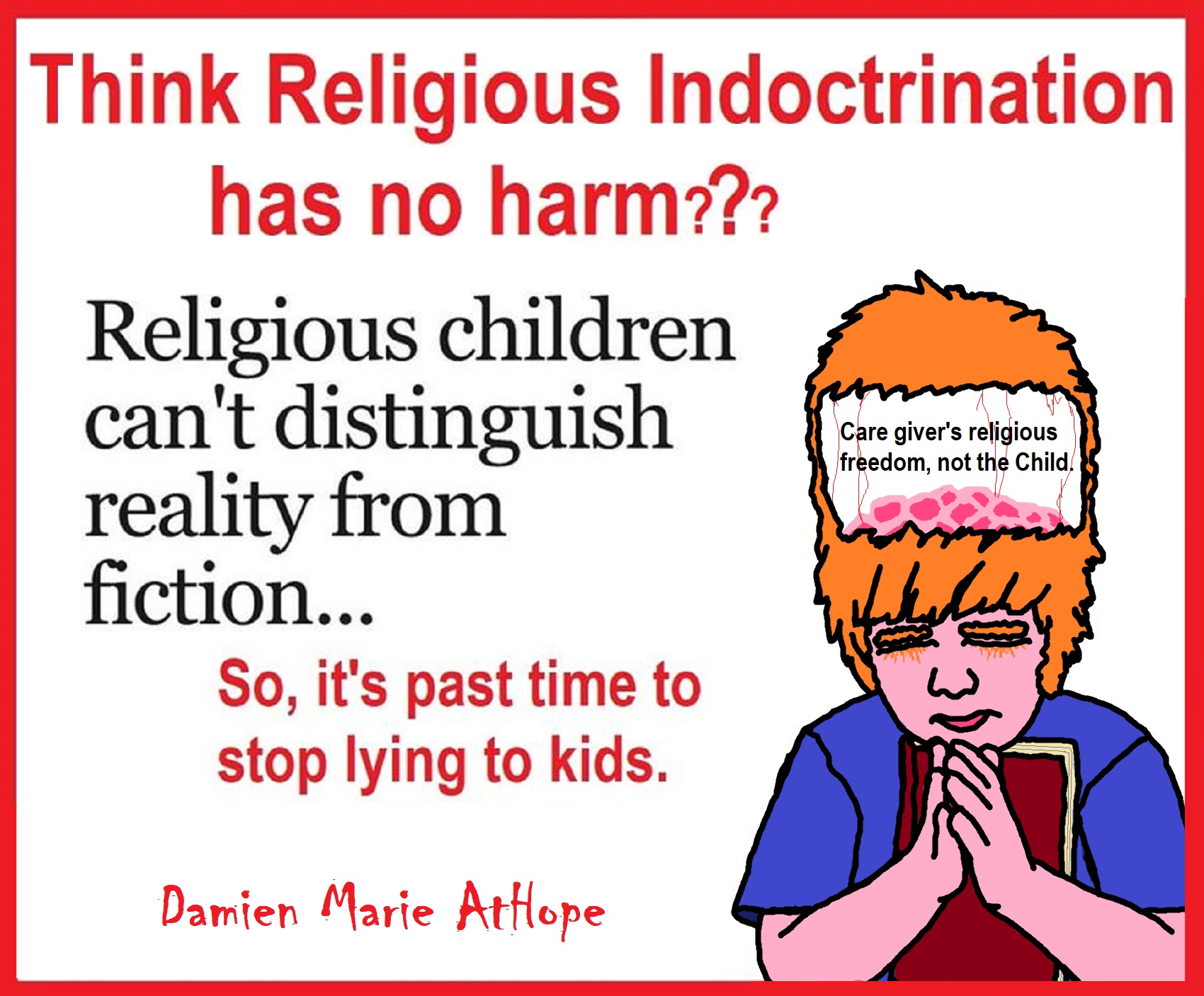
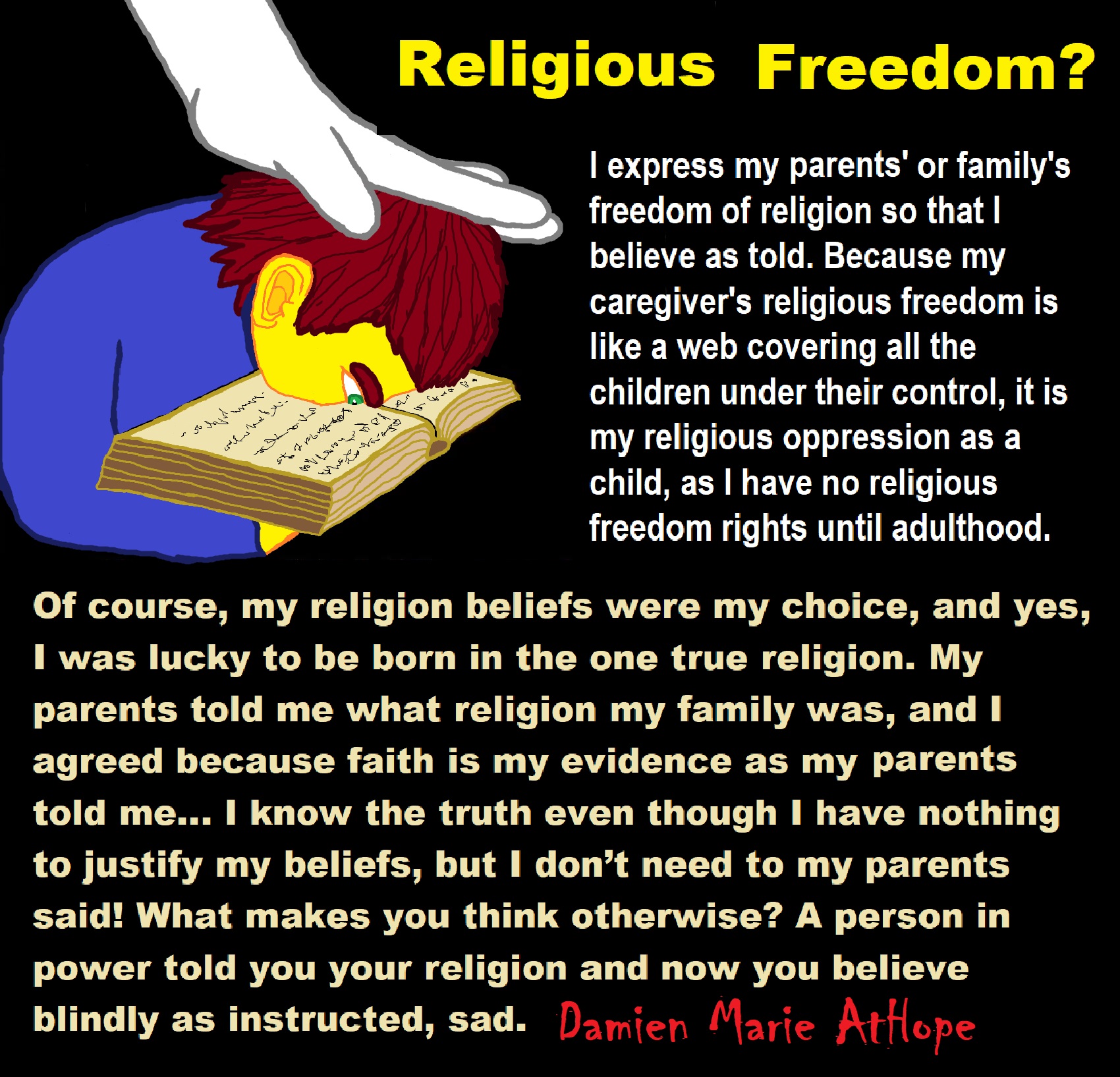
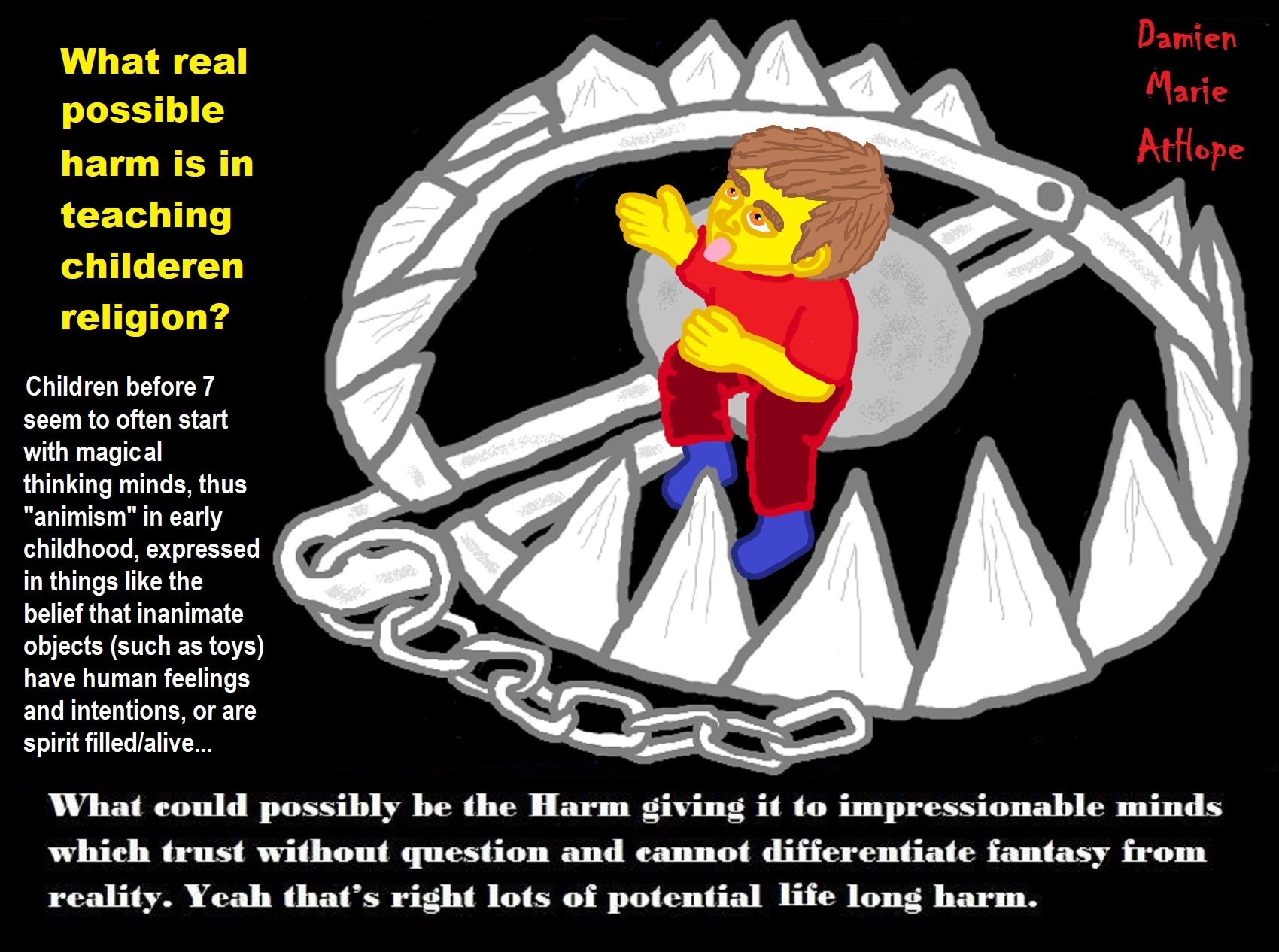
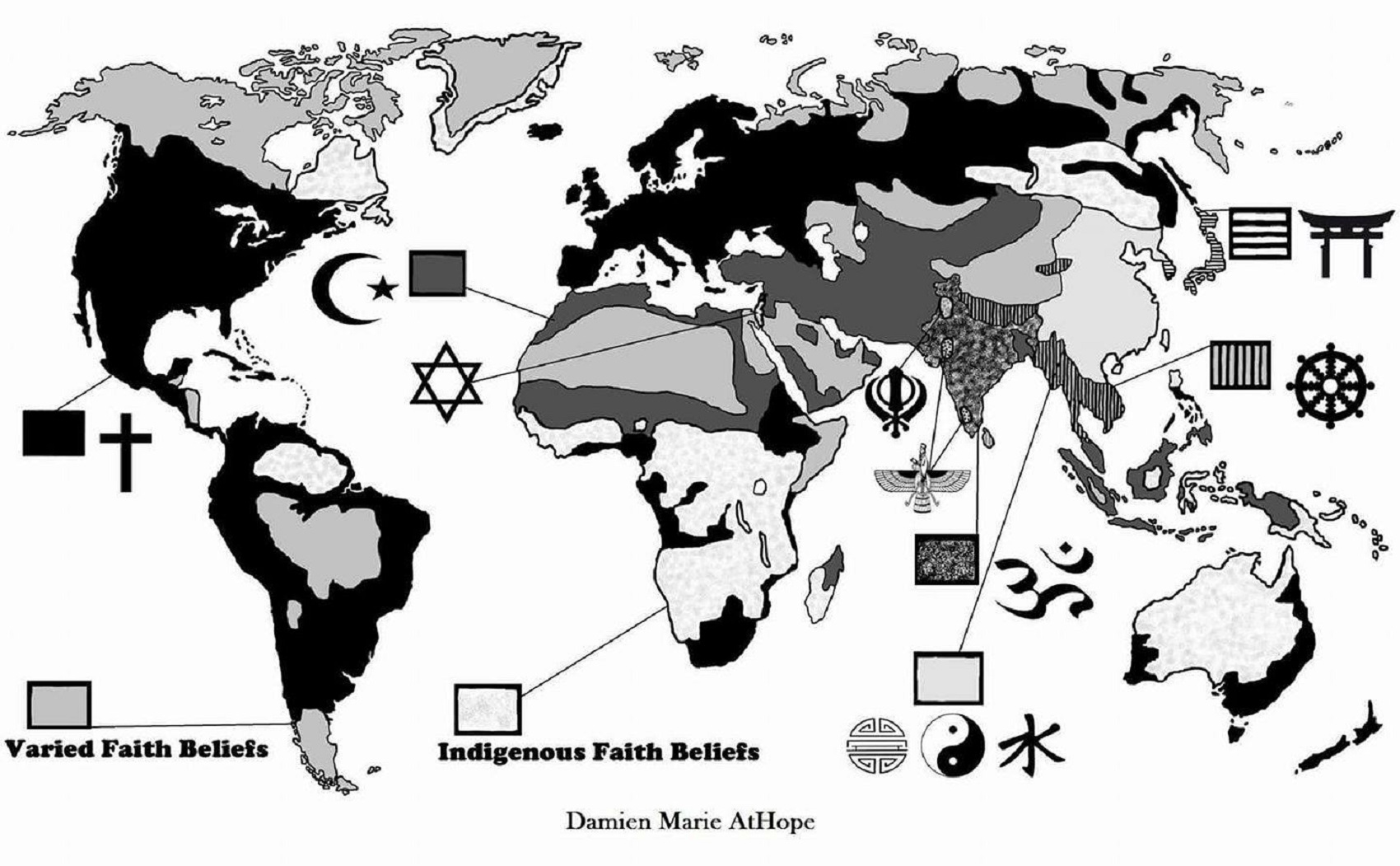
Adapted from (Living Religions: A Brief Introduction by Mary Pat Fisher)
http://books.google.com/books/about/Living_Religions.html?id=ITnlAAAAMAAJ
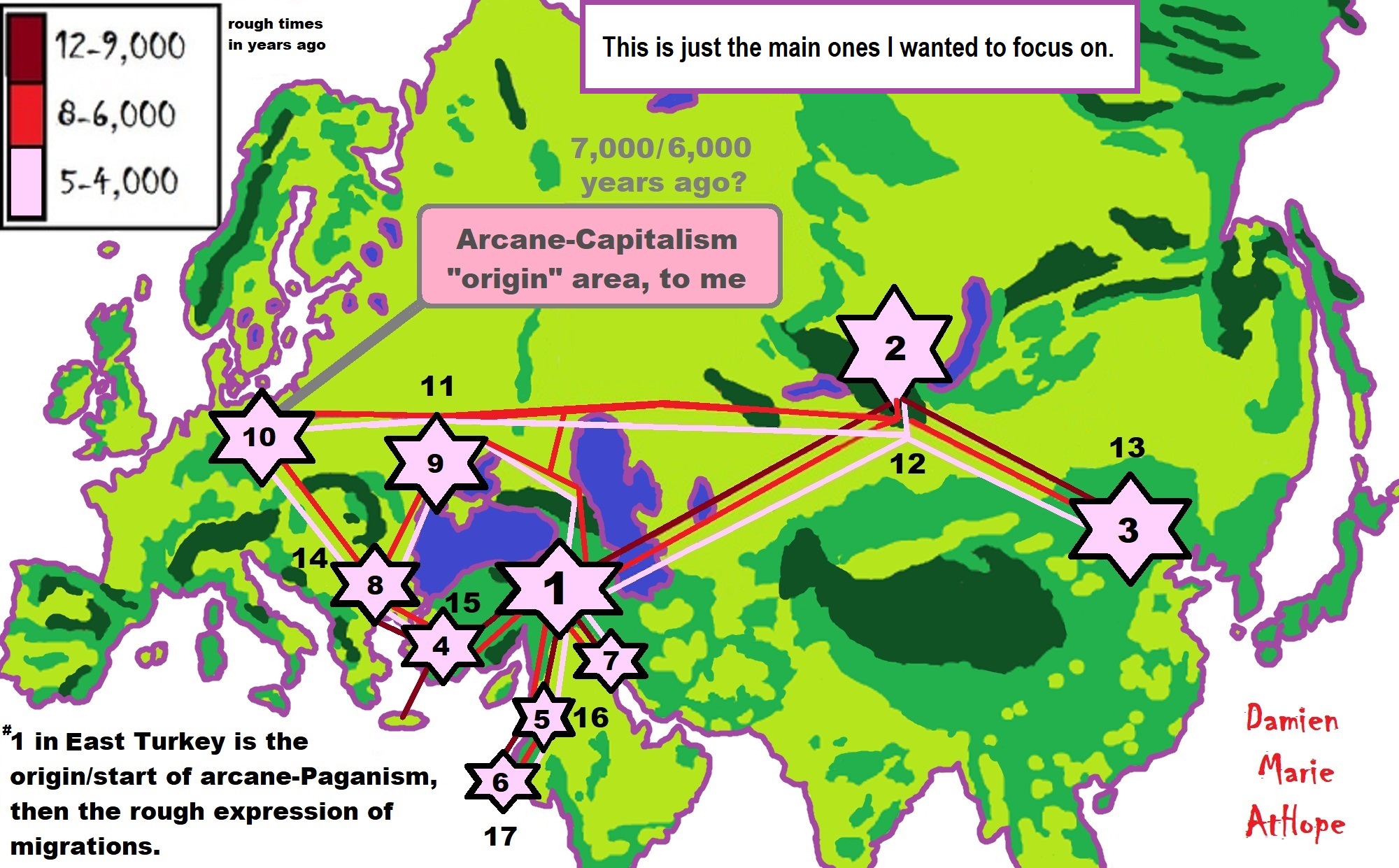
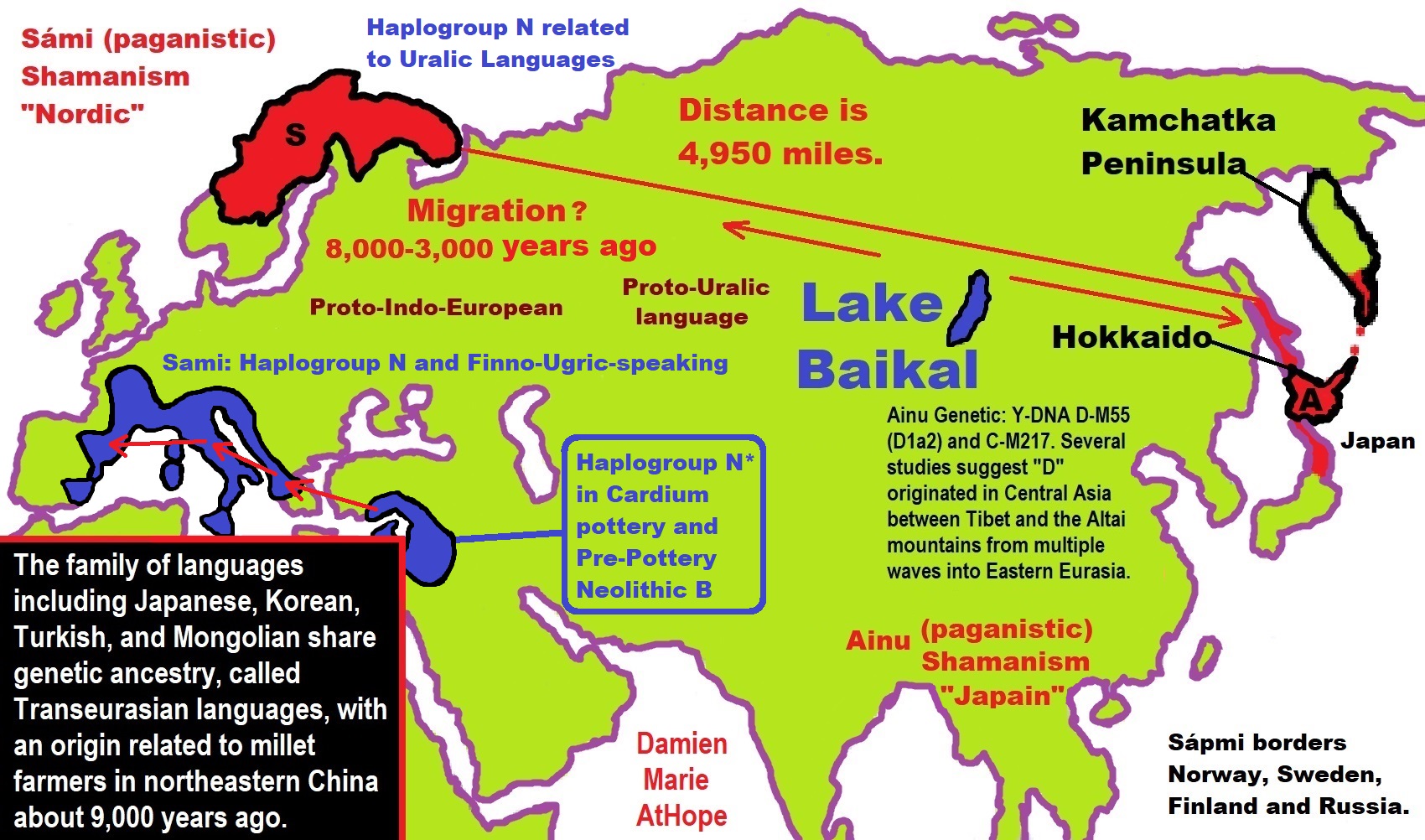
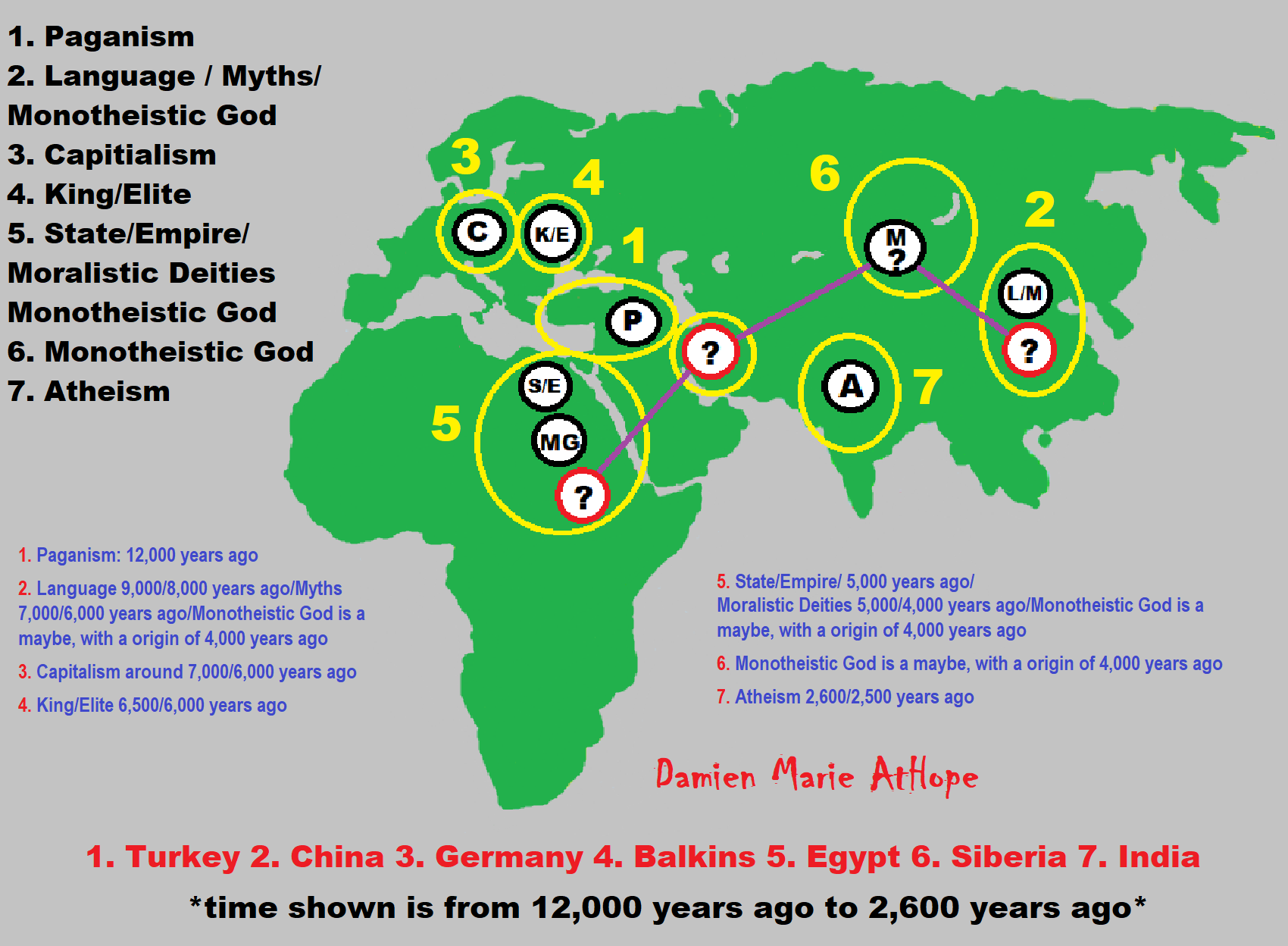
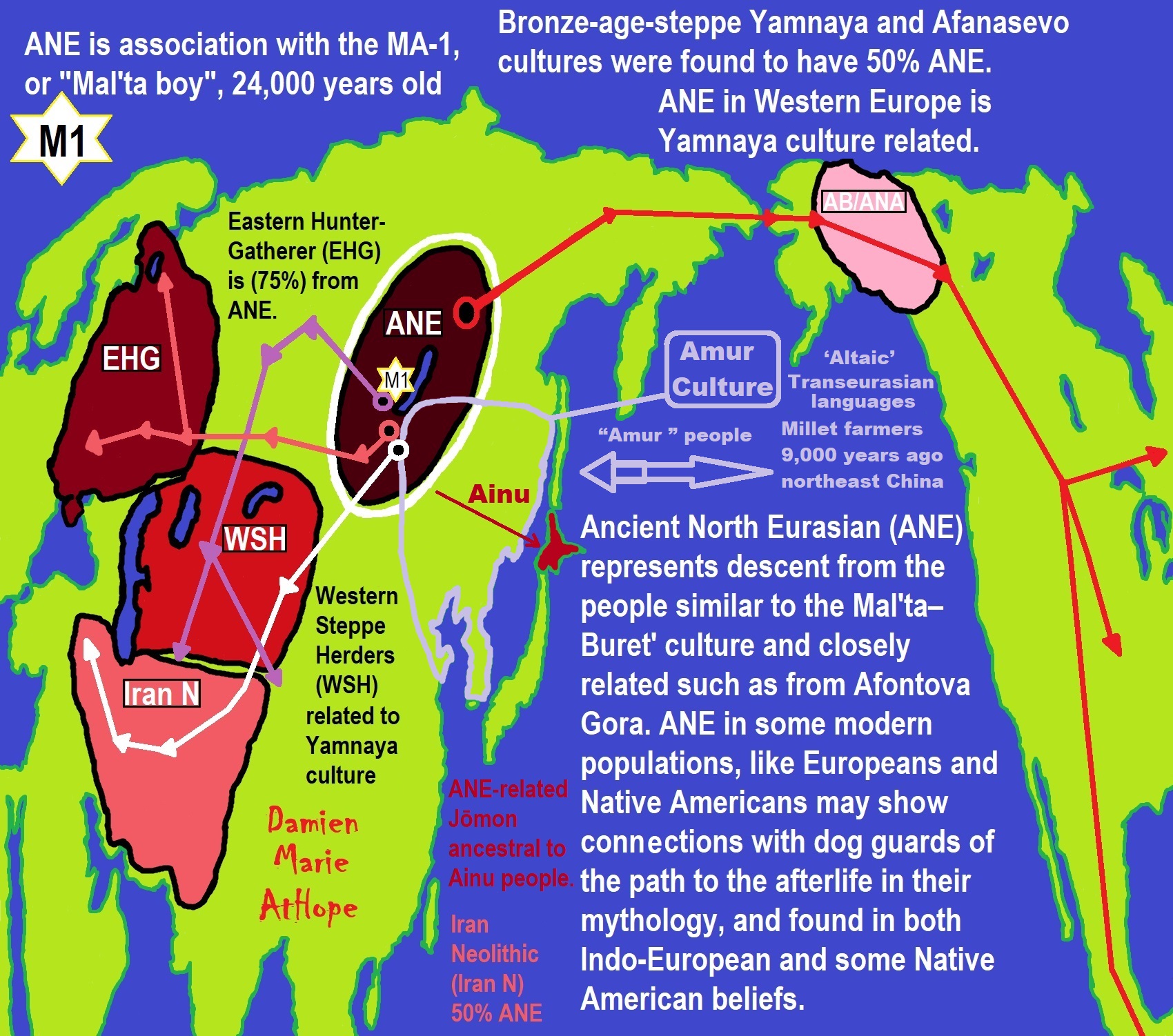
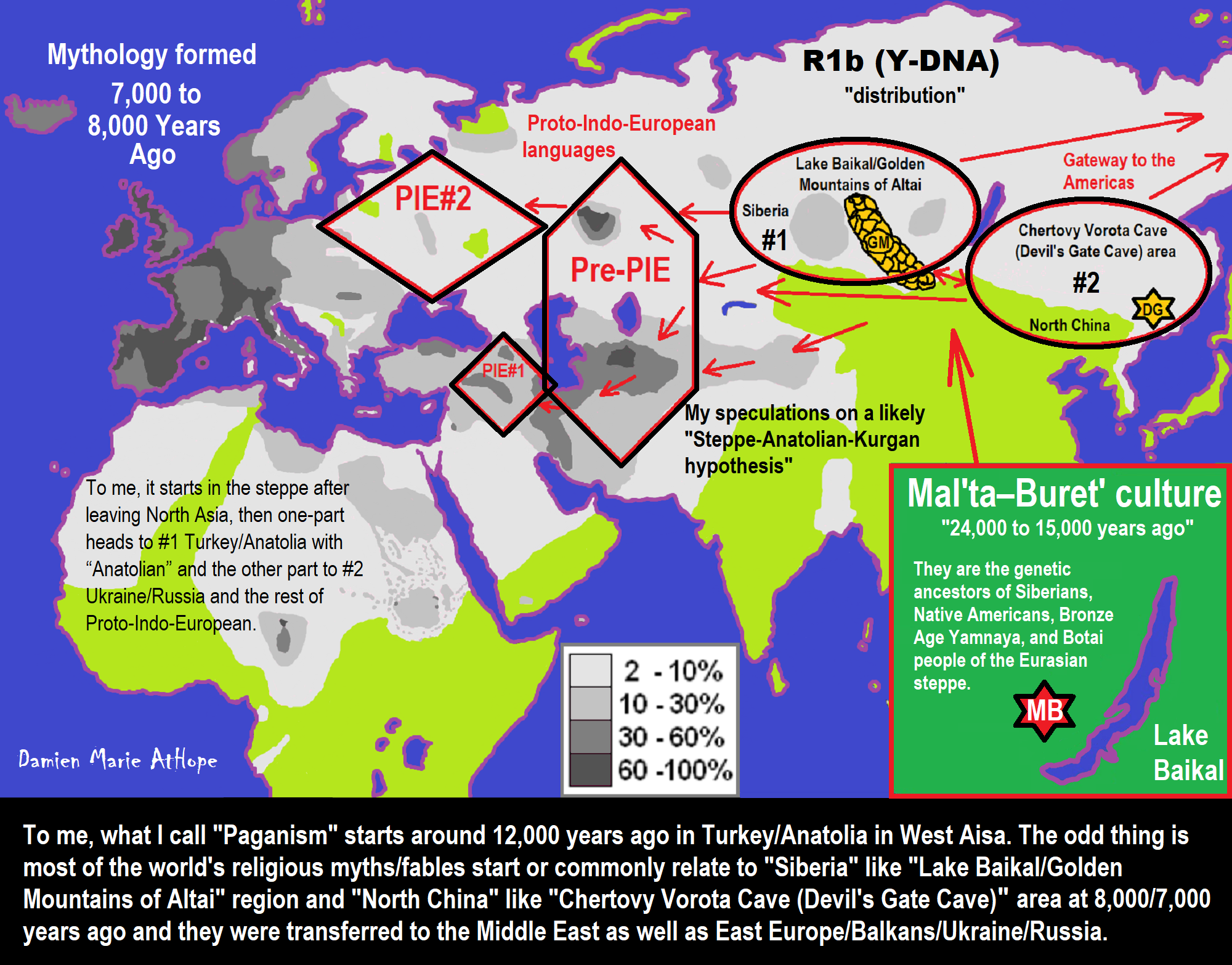
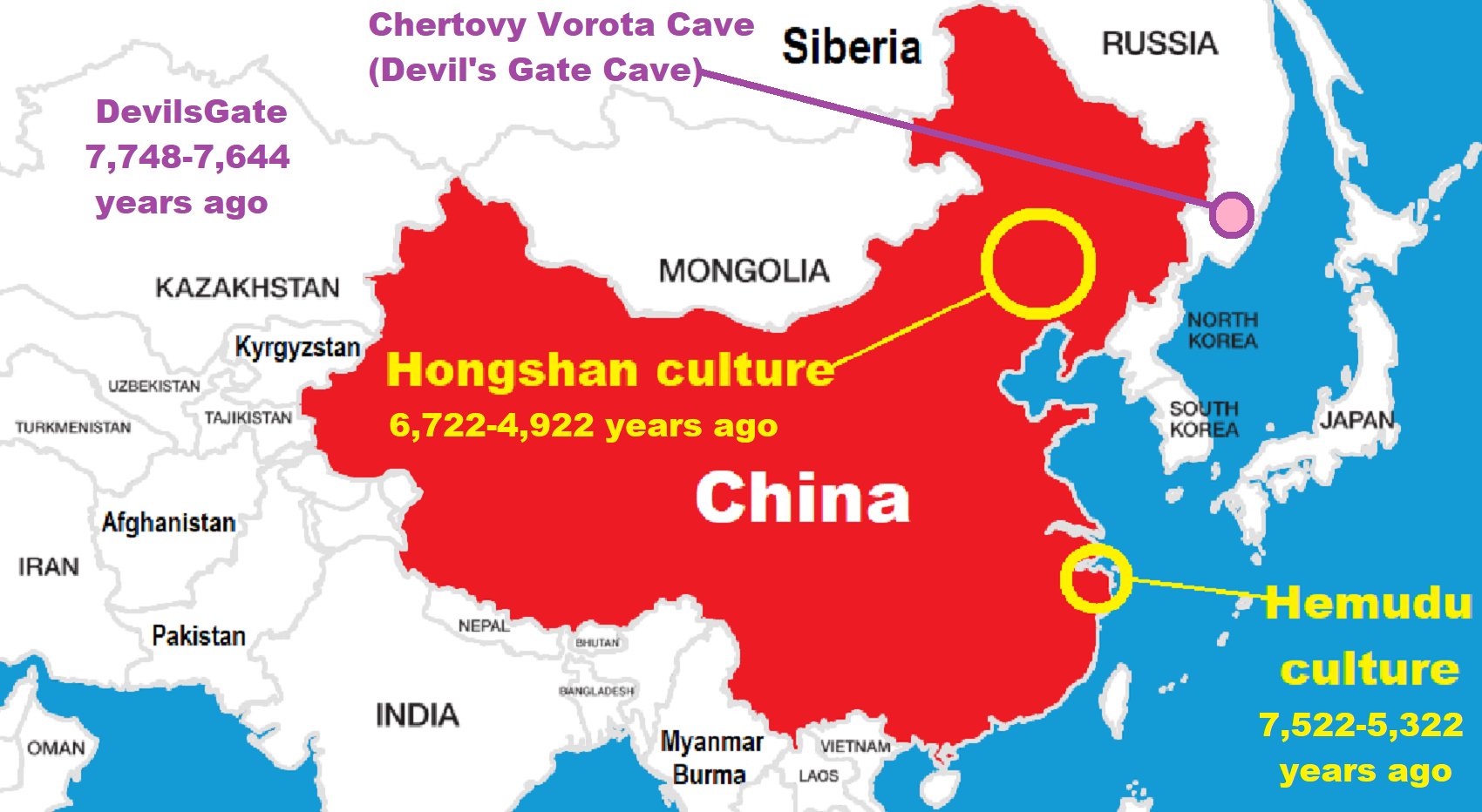
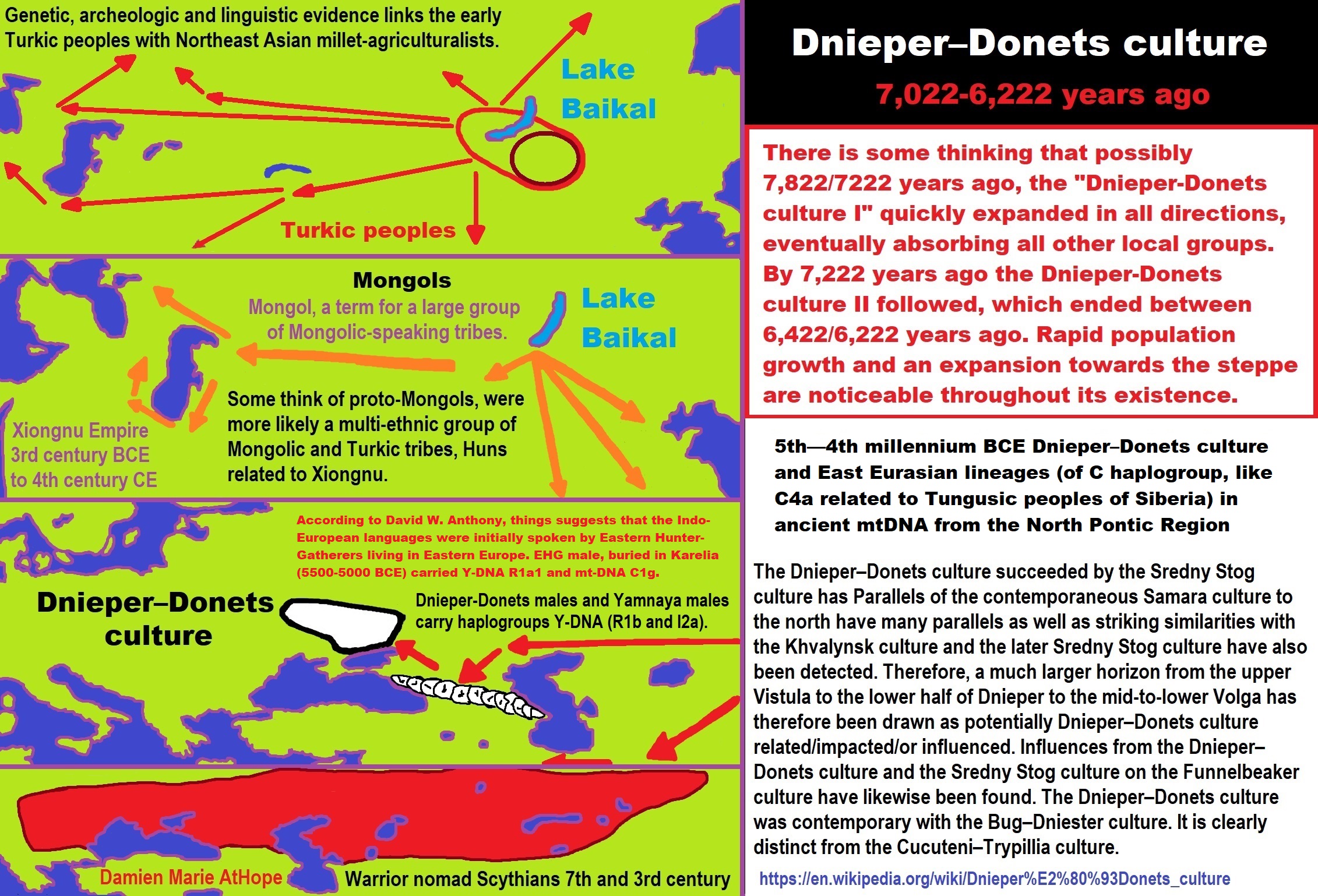
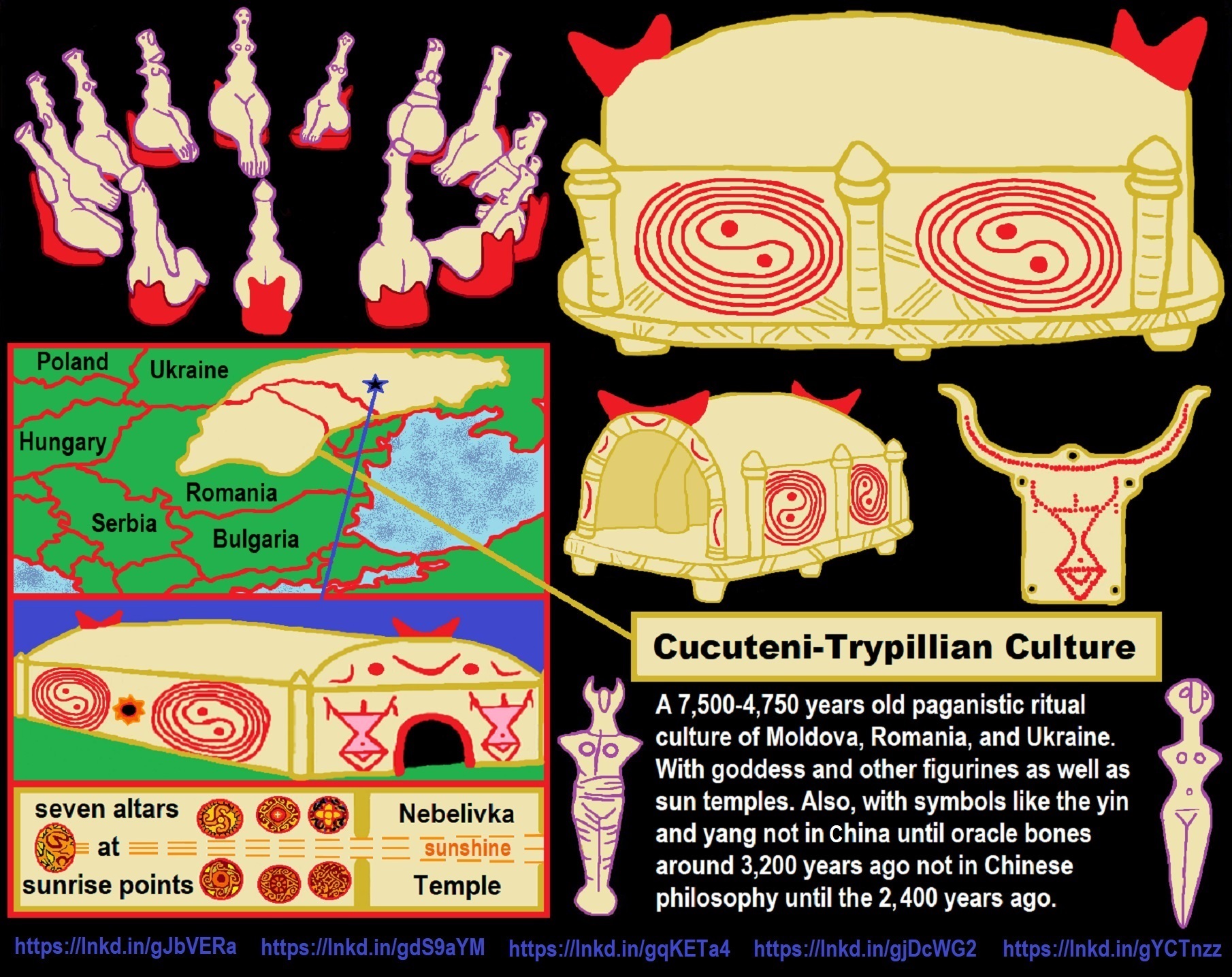
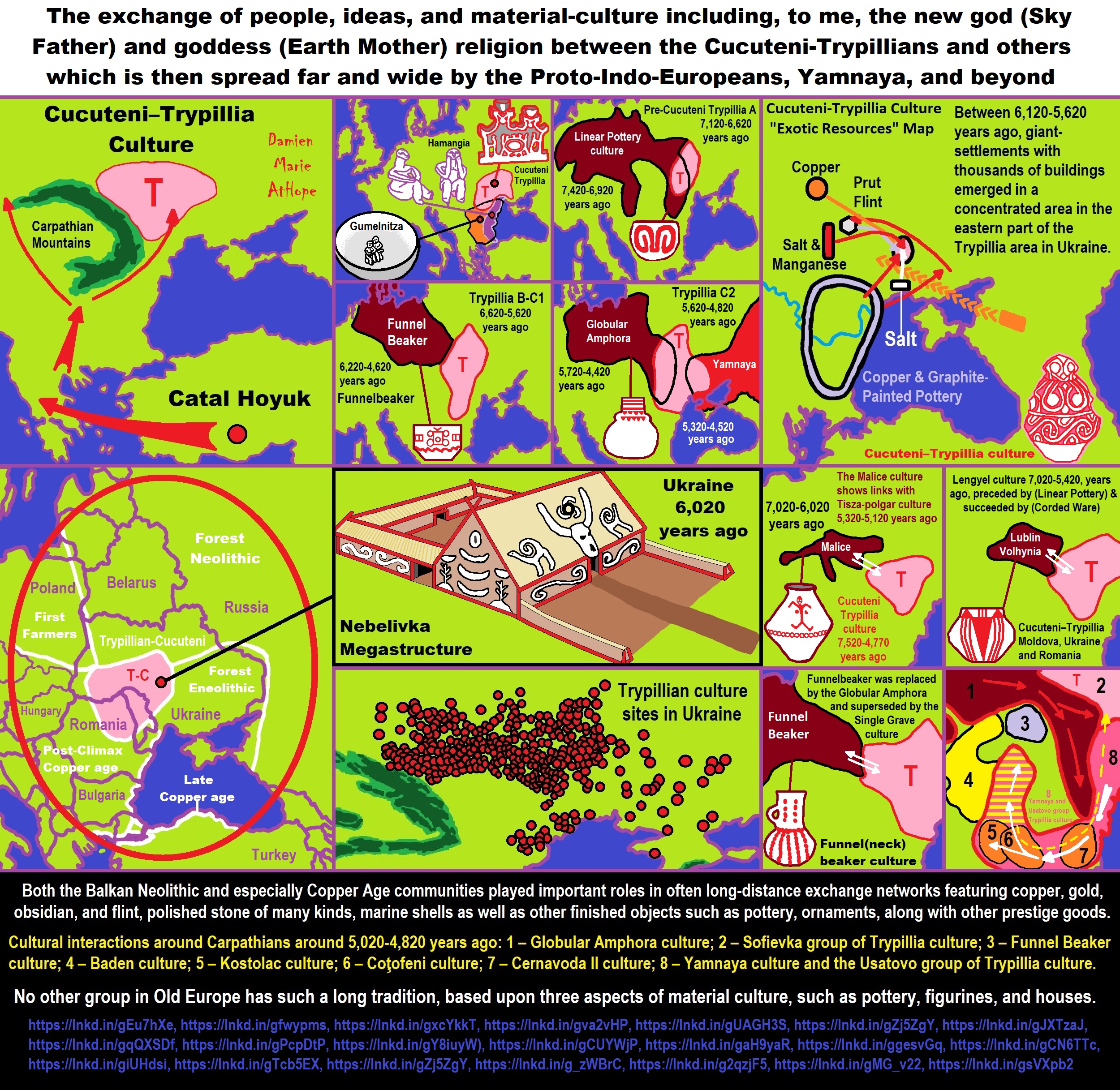
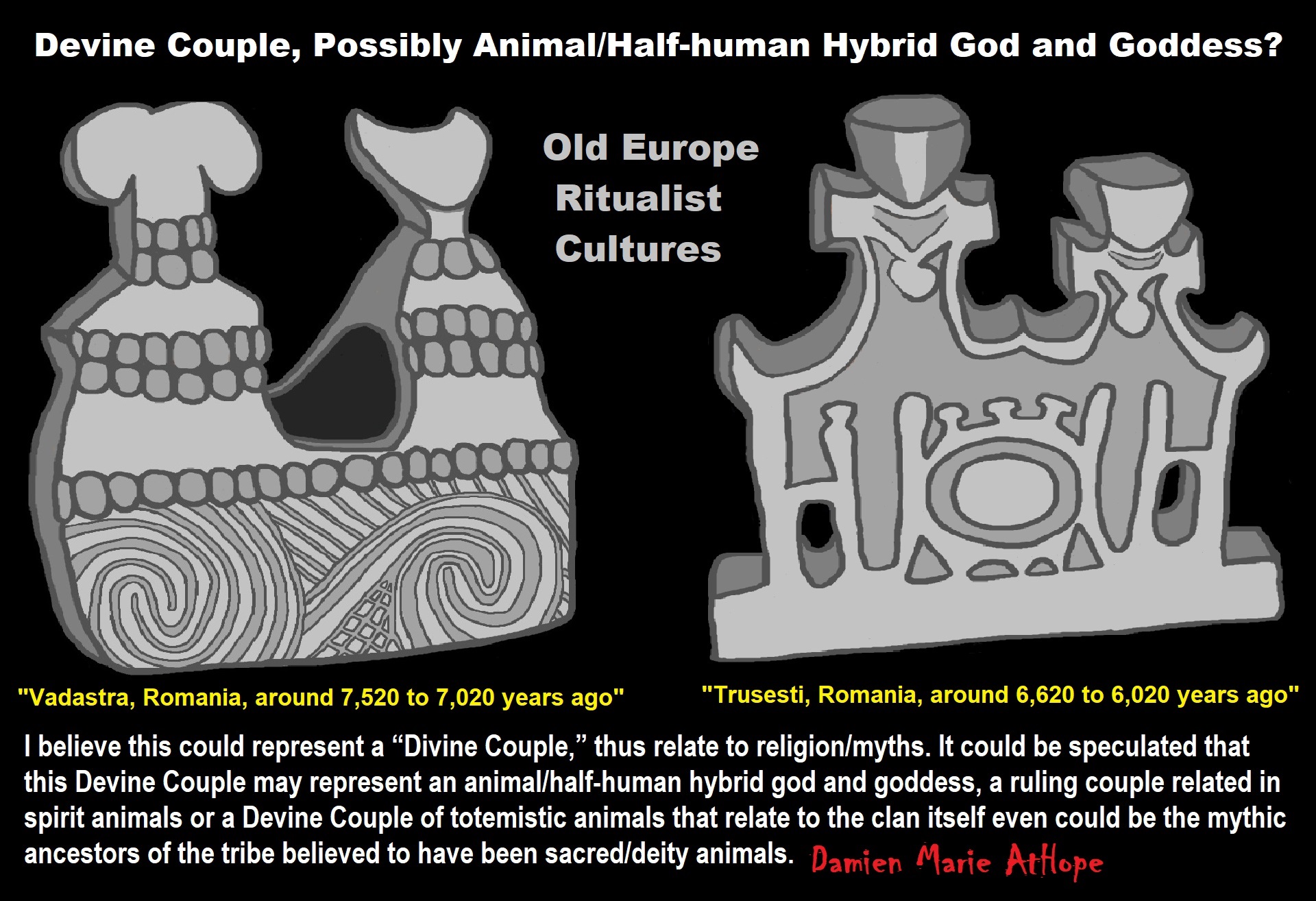
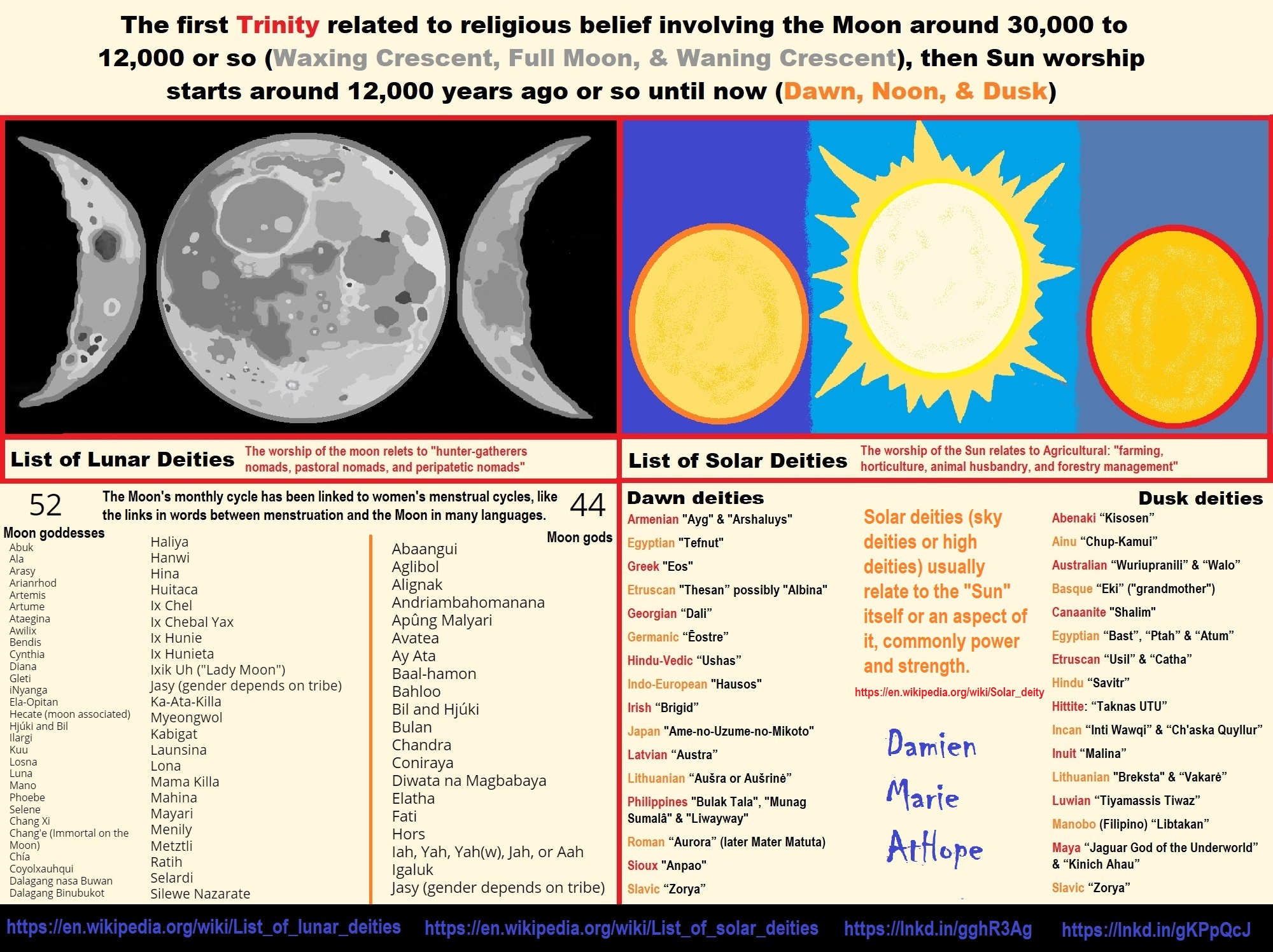
ref, ref, ref, ref, ref, ref, ref
List of Lunar Deities
“In mythology, a lunar deity is a god or goddess of the Moon, sometimes as a personification. These deities can have a variety of functions and traditions depending upon the culture, but they are often related. Some forms of moon worship can be found in most ancient religions. The Moon features prominently in art and literature, often with a purported influence in human affairs. Many cultures are oriented chronologically by the Moon, as opposed to the Sun. The Hindu calendar maintains the integrity of the lunar month and the moon god Chandra has religious significance during many Hindu festivals (e.g. Karwa Chauth, Sankashti Chaturthi, and during eclipses). The ancient Germanic tribes were also known to have a lunar calendar.” ref
“Many cultures have implicitly linked the 29.5-day lunar cycle to women’s menstrual cycles, as evident in the shared linguistic roots of “menstruation” and “moon” words in multiple language families. This identification was not universal, as demonstrated by the fact that not all moon deities are female. Still, many well-known mythologies feature moon goddesses, including the Greek goddess Selene, the Roman goddess Luna, and the Chinese goddess Chang’e. Several goddesses including Artemis, Hecate, and Isis did not originally have lunar aspects, and only acquired them late in antiquity due to syncretism with the de facto Greco-Roman lunar deity Selene/Luna. In traditions with male gods, there is little evidence of such syncretism, though the Greek Hermes has been equated with the male Egyptian lunar god Thoth.” ref
“Male lunar gods are also common, such as Sin of the Mesopotamians, Mani of the Germanic tribes, Tsukuyomi of the Japanese, Igaluk/Alignak of the Inuit, and the Hindu god Chandra. The original Proto-Indo-European lunar deity appears to have been male, with many possible derivatives including the Homeric figure of Menelaus. Cultures with male moon gods often feature sun goddesses. An exception is Hinduism, featuring both male and female aspects of the solar divine. The ancient Egyptians had several moon gods including Khonsu and Thoth, although Thoth is a considerably more complex deity. Set represented the moon in the Egyptian Calendar of Lucky and Unlucky Days.” ref
List of Solar Deities
“A solar deity is a god or goddess who represents the Sun, or an aspect of it, usually by its perceived power and strength. Solar deities and Sun worship can be found throughout most of recorded history in various forms. The following is a list of solar deities. A dawn god or goddess is a deity in a polytheistic religious tradition who is in some sense associated with the dawn. These deities show some relation with the morning, the beginning of the day, and, in some cases, become syncretized with similar solar deities.” ref, ref
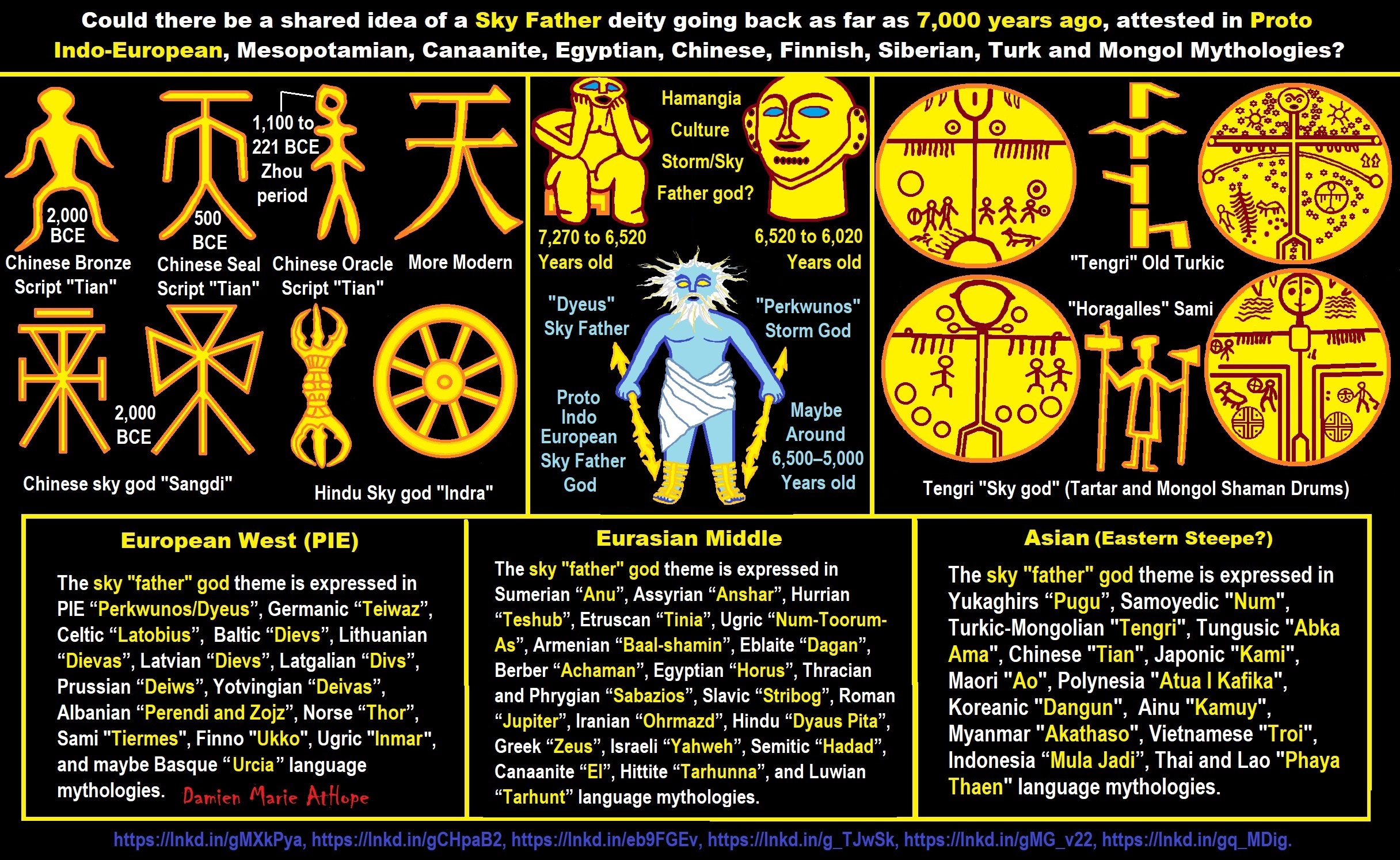
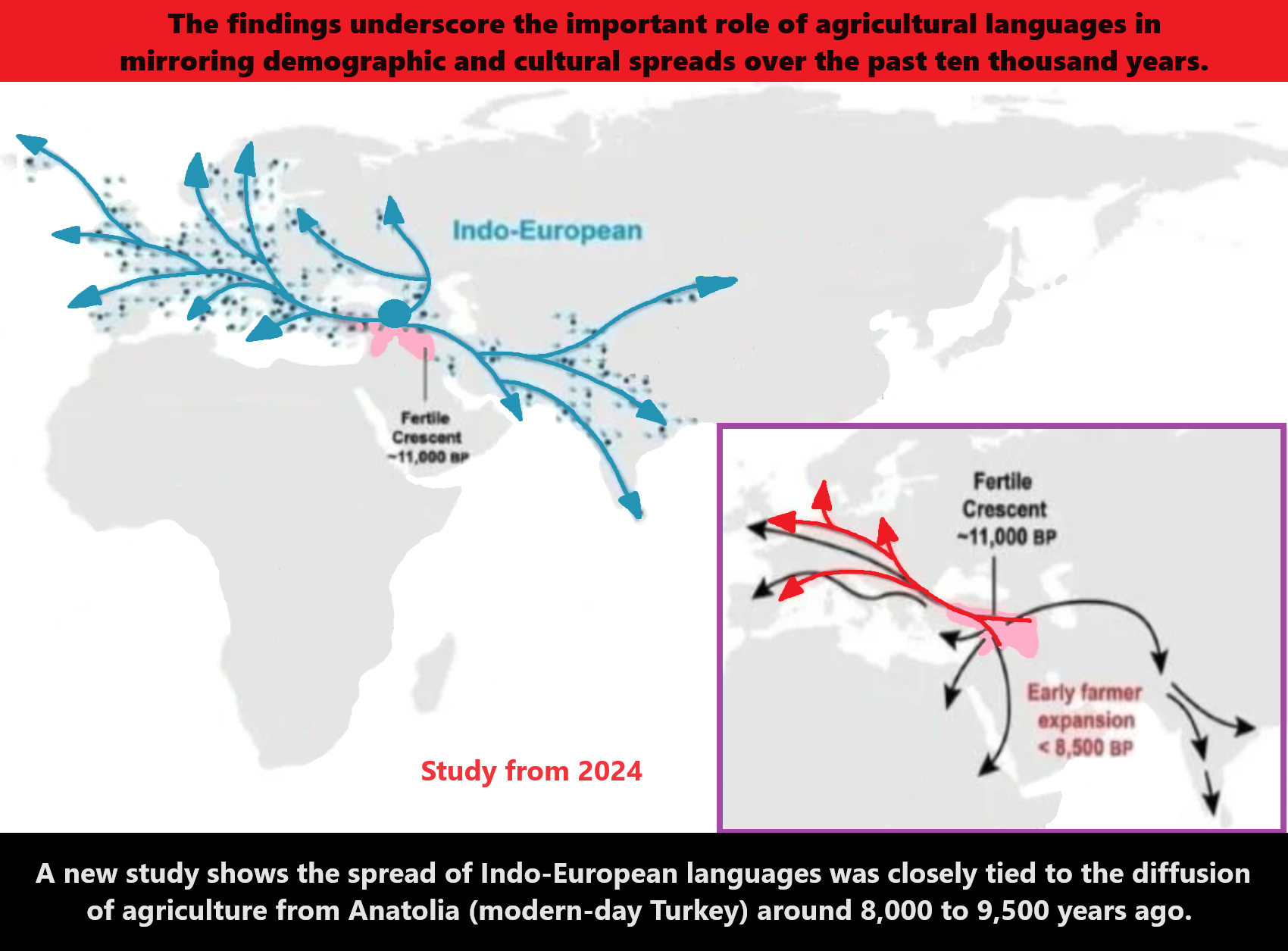
Paganism 12,000-4,000 years old
12,000-7,000 years old: related to (Pre-Capitalism)
7,000-5,000 years old: related to (Capitalism) (World War 0) Elite and their slaves!
5,000 years old: related to (Kings and the Rise of the State)
4,000 years old: related to (First Moralistic gods, then the Origin time of Monotheism)
To me, Siberian Shamanism (related to the Ancient North Eurasians and the Mal’ta–Buret’ culture) comes to the Middle East, then in Turkey around the time of agricultural emergence, I think by 12,000 years ago, they had animal Tutelary Deities (A tutelary can be either a deity or a spirit who is a guardian, patron, or protector of a particular place, geographic feature, person, lineage, nation, culture, or occupation). ref
“Gods and goddesses who are often depicted as being animals, having partially animalistic features, or are at least commonly associated with particular wild or domestic animals.” ref
Then I think new religious ideas came in related to Epigravettians and then I think around 11,000/10,000 years ago it influenced the ideas of Female Goddesses (think of the self-created or self-existing single Mesopotamian goddess Nammu who was the creator of everything and all first deities or those she birthed deities aided in the creation of everything).
I also think there may have been an early (8,000/7,000 years ago) Deity Trinity involving a Sky Father commonly sun god and Earth Mother goddess along with a Bird deity of some kind. I think it is likely similar to how the inhabitants of “Hemudu (5500 to 3300 BCE or around 7,500 to 5,300 years ago Neolithic China) that worshiped a sun spirit as well as a fertility spirit. They also enacted shamanistic rituals to the sun and believed in bird totems. A belief in an afterlife and ghosts is thought to have been widespread as well.” ref
“Nammu also read Namma was a Mesopotamian goddess regarded as a creator deity in the local theology of Eridu. It is assumed that she was associated with water. She is also well-attested in connection with incantations and apotropaic magic. She was regarded as the mother of Enki, and in a single inscription she appears as the wife of Anu, but it is assumed that she usually was not believed to have a spouse.” ref
“The Sumerians believed that the universe had come into being through a series of cosmic births such as gods. First, Nammu, the primeval waters, gave birth to Ki (the earth) and An (the sky), who mated together and produced a son named Enlil. Enlil separated heaven from earth and claimed the earth as his domain. Humans were believed to have been created by AnKi or Enki, the son of the An and Ki. Heaven was reserved exclusively for deities and, upon their deaths, all mortals’ spirits, regardless of their behavior while alive, were believed to go to Kur, a cold, dark cavern deep beneath the earth, which was ruled by the goddess Ereshkigal and where the only food available was dry dust.” ref
“In later times, Ereshkigal was believed to rule alongside her husband Nergal, the god of death. The major deities in the Sumerian pantheon included An, the god of the heavens, Enlil, the god of wind and storm, AnKi Enki, the god of water and human culture, Ninhursag, the goddess of fertility and the earth, Utu, the god of the sun and justice, and his father Nanna, the god of the moon. During the Akkadian Empire, Inanna, the goddess of sex, beauty, and warfare, was widely venerated across Sumer and appeared in many myths, including the famous story of her descent into the Underworld.” ref
“Sumerian religion heavily influenced the religious beliefs of later Mesopotamian peoples; elements of it are retained in the mythologies and religions of the Hurrians, Akkadians, Babylonians, Assyrians, and other Middle Eastern culture groups. Scholars of comparative mythology have noticed parallels between the stories of the ancient Sumerians and those recorded later in the early parts of the Hebrew Bible.” ref
- Sumerian Creator Being was a Female, not Male possibly around 6,000 years ago or more
- Sumerian Word for “Sky” or “Heaven” and “Goddess” or “God” May Connect to the Ghassulian Culture “Star”
- Sky Father/Sky Mother “High Gods” or similar gods/goddesses of the sky more loosely connected, seeming arcane mythology across the earth seen in Siberia, China, Europe, Native Americans/First Nations People and Mesopotamia, etc.
Proto-Indo-European (PIE) is the reconstructed
common ancestor of the Indo-European language family.
| Proto-language | Proto-Indo-European |
|---|---|
| Subdivisions |
“Proto-Indo-European mythology is the body of myths and deities associated with the Proto-Indo-Europeans, speakers of the hypothesized Proto-Indo-European language. Although the mythological motifs are not directly attested – since Proto-Indo-European speakers lived in preliterate societies – scholars of comparative mythology have reconstructed details from inherited similarities found among Indo-European languages, based on the assumption that parts of the Proto-Indo-Europeans’ original belief systems survived in the daughter traditions.” ref
“The Proto-Indo-European pantheon includes a number of securely reconstructed deities, since they are both cognates – linguistic siblings from a common origin – and associated with similar attributes and body of myths: such as *Dyḗws Ph₂tḗr, the daylight-sky god; his consort *Dʰéǵʰōm, the earth mother; his daughter *H₂éwsōs, the dawn goddess; his sons the Divine Twins; and *Seh₂ul and *Meh₁not, a solar goddess and moon god, respectively. Some deities, like the weather god *Perkʷunos or the herding-god *Péh₂usōn, are only attested in a limited number of traditions – Western (i.e. European) and Graeco-Aryan, respectively – and could therefore represent late additions that did not spread throughout the various Indo-European dialects.” ref
“Some myths are also securely dated to Proto-Indo-European times, since they feature both linguistic and thematic evidence of an inherited motif: a story portraying a mythical figure associated with thunder and slaying a multi-headed serpent to release torrents of water that had previously been pent up; a creation myth involving two brothers, one of whom sacrifices the other in order to create the world; and probably the belief that the Otherworld was guarded by a watchdog and could only be reached by crossing a river. Various schools of thought exist regarding possible interpretations of the reconstructed Proto-Indo-European mythology. The main mythologies used in comparative reconstruction are Indo-Iranian, Baltic, Roman, and Norse, often supported with evidence from the Celtic, Greek, Slavic, Hittite, Armenian, Illyrian, and Albanian traditions as well.” ref
Source mythologies
“One of the earliest attested and thus one of the most important of all Indo-European mythologies is Vedic mythology, especially the mythology of the Rigveda, the oldest of the Vedas. Early scholars of comparative mythology such as Friedrich Max Müller stressed the importance of Vedic mythology to such an extent that they practically equated it with Proto-Indo-European myths. Modern researchers have been much more cautious, recognizing that, although Vedic mythology is still central, other mythologies must also be taken into account. The Vedas are a large body of religious texts originating in ancient India. Composed in Vedic Sanskrit, the texts constitute the oldest layer of Sanskrit literature and the oldest scriptures of Hinduism.” ref, ref
“Another of the most important source mythologies for comparative research is Roman mythology. The Romans possessed a very complex mythological system, parts of which have been preserved through the characteristic Roman tendency to rationalize their myths into historical accounts. Despite its relatively late attestation, Norse mythology is still considered one of the three most important of the Indo-European mythologies for comparative research, due to the vast bulk of surviving Icelandic material.” ref
“Baltic mythology has also received a great deal of scholarly attention, as it is linguistically the most conservative and archaic of all surviving branches, but has so far remained frustrating to researchers because the sources are so comparatively late. Nonetheless, Latvian folk songs are seen as a major source of information in the process of reconstructing Proto-Indo-European myth. Despite the popularity of Greek mythology in western culture, Greek mythology is generally seen as having little importance in comparative mythology due to the heavy influence of Pre-Greek and Near Eastern cultures, which overwhelms what little Indo-European material can be extracted from it. Consequently, Greek mythology received minimal scholarly attention until the first decade of the 21st century.” ref
“Although Scythians are considered relatively conservative in regards to Proto-Indo-European cultures, retaining a similar lifestyle and culture, their mythology has very rarely been examined in an Indo-European context and infrequently discussed in regards to the nature of the ancestral Indo-European mythology. At least three deities, Tabiti, Papaios, and Api, are generally interpreted as having Indo-European origins, while the remaining have seen more disparate interpretations. Influence from Siberian, Turkic, and even Near Eastern beliefs, on the other hand, are more widely discussed in literature.” ref
Creation myth
“Lincoln reconstructs a creation myth involving twin brothers, *Manu- (“Man”) and *Yemo- (“Twin”), as the progenitors of the world and humankind, and a hero named *Trito (“Third”) who ensured the continuity of the original sacrifice. Regarding the primordial state that may have preceded the creation process, West notes that the Vedic, Norse and, at least partially, the Greek traditions give evidence of an era when the cosmological elements were absent, with similar formula insisting on their non-existence: “neither non-being was nor being was at that time; there was not the air, nor the heaven beyond it” (Rigveda), “there was not sand nor sea nor the cool waves; earth was nowhere nor heaven above; Ginnunga Gap there was, but grass nowhere” (Völuspá), “there was Chasm and Night and dark Erebos at first, and broad Tartarus, but earth nor air nor heaven there was” (The Birds).” ref
“In the creation myth, the first man Manu and his giant twin Yemo are crossing the cosmos, accompanied by the primordial cow. To create the world, Manu sacrifices his brother and, with the help of heavenly deities (the Sky-Father, the Storm-God, and the Divine Twins), forges both the natural elements and human beings from his remains. Manu thus becomes the first priest after initiating sacrifice as the primordial condition for the world order, and his deceased brother Yemo the first king as social classes emerge from his anatomy (priesthood from his head, the warrior class from his breast and arms, and the commoners from his sexual organs and legs). Although the European and Indo-Iranian versions differ on this matter, Lincoln argues that the primeval cow was most likely sacrificed in the original myth, giving birth to the other animals and vegetables, since the pastoral way of life of Proto-Indo-Iranian speakers was closer to that of Proto-Indo-European speakers.” ref
“To the third man Trito, the celestial gods then offer cattle as a divine gift, which is stolen by a three-headed serpent named *Ngʷhi (“serpent”; and the Indo-European root for negation). Trito first suffers at his hands, but the hero eventually manages to overcome the monster, fortified by an intoxicating drink and aided by the Sky-Father. He eventually gives the recovered cattle back to a priest for it to be properly sacrificed. Trito is now the first warrior, maintaining through his heroic actions the cycle of mutual giving between gods and mortals.” ref
Interpretations
“According to Lincoln, Manu and Yemo seem to be the protagonists of “a myth of the sovereign function, establishing the model for later priests and kings”, while the legend of Trito should be interpreted as “a myth of the warrior function, establishing the model for all later men of arms”. The myth indeed recalls the Dumézilian tripartition of the cosmos between the priest (in both his magical and legal aspects), the warrior (the Third Man), and the herder (the cow).” ref
The story of Trito served as a model for later cattle raiding epic myths and most likely as a moral justification for the practice of raiding among Indo-European peoples. In the original legend, Trito is only taking back what rightfully belongs to his people, those who sacrifice properly to the gods. The myth has been interpreted either as a cosmic conflict between the heavenly hero and the earthly serpent, or as an Indo-European victory over non-Indo-European people, the monster symbolizing the aboriginal thief or usurper.” ref
Some scholars have proposed that the primeval being Yemo was depicted as a two-fold hermaphrodite rather than a twin brother of Manu, both forming indeed a pair of complementary beings entwined together. The Germanic names Ymir and Tuisto were understood as twin, bisexual or hermaphrodite, and some myths give a sister to the Vedic Yama, also called Twin and with whom incest is discussed. In this interpretation, the primordial being may have self-sacrificed, or have been divided in two, a male half and a female half, embodying a prototypal separation of the sexes.” ref
Legacy
“Cognates deriving from the Proto-Indo-European First Priest *Manu (“Man“, “ancestor of mankind”) include the Indic Manu, legendary first man in Hinduism, and Manāvī, his sacrificed wife; the Germanic Mannus (PGmc *Mannaz), mythical ancestor of the West Germanic tribes; and the Persian Manūščihr (from Aves. Manūš.čiθra), a Zoroastrian high priest of the 9th century CE. From the name of the sacrificed First King *Yemo (“Twin”) derive the Indic Yama, god of death and the underworld; the Avestan Yima, king of the golden age and guardian of hell; the Norse Ymir (from PGmc *Jumijaz), ancestor of the giants (jötnar); and most likely Remus (from Proto-Latin *Yemos or *Yemonos, with the initial y– shifting to r– under the influence of Rōmulus), killed in the Roman foundation myth by his twin brother Romulus. Cognates stemming from the First Warrior *Trito (“Third”) include the Vedic Trita, the Avestan Thrita, and the Norse þriði.” ref
“Many Indo-European beliefs explain the origin of natural elements as the result of the original dismemberment of Yemo: his flesh usually becomes the earth, his hair grass, his bone yields stone, his blood water, his eyes the sun, his mind the moon, his brain the clouds, his breath the wind, and his head the heavens. The traditions of sacrificing an animal to disperse its parts according to socially established patterns, a custom found in Ancient Rome and India, has been interpreted as an attempt to restore the balance of the cosmos ruled by the original sacrifice.” ref
“The motif of Manu and Yemo has been influential throughout Eurasia following the Indo-European migrations. The Greek, Old Russian (Poem on the Dove King), and Jewish versions depend on the Iranian, and a Chinese version of the myth has been introduced from Ancient India. The Armenian version of the myth of the First Warrior Trito depends on the Iranian, and the Roman reflexes were influenced by earlier Greek versions.” ref
Cosmic order
“Linguistic evidence has led scholars to reconstruct the concept of *h₂értus, denoting ‘what is fitting, rightly ordered’, and ultimately deriving from the verbal root *h₂er-, ‘to fit’. Descendant cognates include Hittite āra (‘right, proper’); Sanskrit ṛta (‘divine/cosmic law, force of truth, or order’); Avestan arəta- (‘order’); Greek artús (‘arrangement’), possibly arete (‘excellence’) via the root *h₂erh₁ (‘please, satisfy’); Latin artus (‘joint’); Tocharian A ārtt- (‘to praise, be pleased with’); Armenian ard (‘ornament, shape’); Middle High German art (‘innate feature, nature, fashion’).” ref
“Interwoven with the root *h₂er- (‘to fit’) is the verbal root *dʰeh₁-, which means ‘to put, lay down, establish’, but also ‘speak, say; bring back’. The Greek thémis and the Sanskrit dhāman both derive from the PIE noun for the ‘Law’, *dʰeh₁-men-, literally ‘that which is established’. This notion of ‘Law’ includes an active principle, denoting an activity in obedience to the cosmic order *h₂értus, which in a social context is interpreted as a lawful conduct: in the Greek daughter culture, the titaness Themis personifies the cosmic order and the rules of lawful conduct which derived from it, and the Vedic code of lawful conduct, the Dharma, can also be traced back to the PIE root *dʰeh₁-. According to Martin L. West, the root *dʰeh₁- also denotes a divine or cosmic creation, as attested by the Hittite expression nēbis dēgan dāir (“established heaven (and) earth”), the Young Avestan formula kə huvāpå raocåscā dāt təmåscā? (“What skilful artificer made the regions of light and dark?”), the name of the Vedic creator god Dhātr, and possibly by the Greek nymph Thetis, presented as a demiurgical goddess in Alcman‘s poetry.” ref
Another root *yew(e)s- appears to be connected with ritualistic laws, as suggested by the Latin iūs (‘law, right, justice, duty’), Avestan yaož-dā- (‘make ritually pure’), and Sanskrit śáṃca yóśca (‘health and happiness’), with a derived adjective *yusi(iy)os seen in Old Irish uisse (‘just right, fitting’) and possibly Old Church Slavonic istǔ (‘actual, true’).” ref
Otherworld
“The realm of death was generally depicted as the Lower Darkness and the land of no return. Many Indo-European myths relate a journey across a river, guided by an old man (*ǵerh₂ont-), in order to reach the Otherworld. The Greek tradition of the dead being ferried across the river Styx by Charon is probably a reflex of this belief, and the idea of crossing a river to reach the Underworld is also present throughout Celtic mythologies. Several Vedic texts contain references to crossing a river (river Vaitarna) in order to reach the land of the dead, and the Latin word tarentum (“tomb”) originally meant “crossing point”. In Norse mythology, Hermóðr must cross a bridge over the river Giöll in order to reach Hel and, in Latvian folk songs, the dead must cross a marsh rather than a river.” ref
“Traditions of placing coins on the bodies of the deceased in order to pay the ferryman are attested in both ancient Greek and early modern Slavic funerary practices; although the earliest coins date to the Iron Age, this may provide evidence of an ancient tradition of giving offerings to the ferryman. “In a recurrent motif, the Otherworld contains a gate, generally guarded by a multi-headed (sometimes multi-eyed) dog who could also serve as a guide and ensured that the ones who entered could not get out. The Greek Cerberus and the Hindu Śárvara most likely derive from the common noun *Ḱérberos (“spotted”). Bruce Lincoln has proposed a third cognate in the Norse Garmr, although this has been debated as linguistically untenable.” ref
Eschatology
“Several traditions reveal traces of a Proto-Indo-European eschatological myth that describes the end of the world following a cataclysmic battle. The story begins when an archdemon, usually coming from a different and inimical paternal line, assumes the position of authority among the community of the gods or heroes (Norse Loki, Roman Tarquin, Irish Bres). The subjects are treated unjustly by the new ruler, forced to erect fortifications while the archdemon instead favours outsiders, on whom his support relies. After a particularly heinous act, the archdemon is exiled by his subjects and takes refuge among his foreign relatives. A new leader (Norse Víðarr, Roman Lucius Brutus, Irish Lug), known as the “silent” one and usually the nephew or grandson (*népōt) of the exiled archdemon, then springs up and the two forces come together to annihilate each other in a cataclysmic battle. The myth ends with the interruption of the cosmic order and the conclusion of a temporal cyclic era. In the Norse and Iranian traditions, a cataclysmic “cosmic winter” precedes the final battle.” ref
Other propositions
“In the cosmological model proposed by Jean Haudry, the Proto-Indo-European sky is composed of three “heavens” (diurnal, nocturnal, and liminal) rotating around an axis mundi, each having its own deities, social associations, and colors (white, dark, and red, respectively). Deities of the diurnal sky could not transgress the domain of the nocturnal sky, inhabited by its own sets of gods and by the spirits of the dead. For instance, Zeus cannot extend his power to the nightly sky in the Iliad. In this vision, the liminal or transitional sky embodies the gate or frontier (dawn and twilight) binding the two other heavens.” ref
“Proto-Indo-Europeans may have believed that the peripheral part of the earth was inhabited by a people exempt from the hardships and pains that arise from the human condition. The common motif is suggested by the legends of the Indic Śvetadvīpam (“White Island”), whose inhabitants shine white like the moon and need no food; the Greek Hyperborea (“Beyond the North Wind”), where the sun shines all the time and the men know “neither disease nor bitter old age”; the Irish Tír na nÓg (“Land of the Young”), a mythical region located in the western sea where “happiness lasts forever and there is no satiety”; or the Germanic Ódáinsakr (“Glittering Plains”), a land situated beyond the Ocean where “no one is permitted to die.” ref
Deities
“PIE is hypothesized to have been spoken as a single language from approximately 4500 to 2500 BCE or 6,500 to 4,500 years ago, during the Late Neolithic to Early Bronze Age, though estimates vary by more than a thousand years.” ref
“The archaic Proto-Indo-European language (4500–4000 BCE) had a two-gender system which originally distinguished words between animate and inanimate, a system used to separate a common term from its deified synonym. For instance, fire as an active principle was *h₁n̥gʷnis (Latin ignis; Sanskrit Agní), while the inanimate, physical entity was *péh₂ur (Greek pyr; English fire). During this period, Proto-Indo-European beliefs were still animistic and their language did not yet make formal distinctions between masculine and feminine, although it is likely that each deity was already conceived as either male or female. Most of the goddesses attested in later Indo-European mythologies come from pre-Indo-European deities eventually assimilated into the various pantheons following the migrations, like the Greek Athena, the Roman Juno, the Irish Medb, or the Iranian Anahita. Diversely personified, they were frequently seen as fulfilling multiple functions, while Proto-Indo-European goddesses shared a lack of personification and narrow functionalities as a general characteristic. The most well-attested female Indo-European deities include *H₂éwsōs, the Dawn, *Dʰéǵʰōm, the Earth, and *Seh₂ul, the Sun.” ref
“It is not probable that the Proto-Indo-Europeans had a fixed canon of deities or assigned a specific number to them. The term for “a god” was *deywós (“celestial”), derived from the root *dyew, which denoted the bright sky or the light of day. It has numerous reflexes in Latin deus, Old Norse Týr (< Germ. *tīwaz), Sanskrit devá, Avestan daeva, Irish día, or Lithuanian Dievas. In contrast, human beings were synonymous of “mortals” and associated with the “earthly” (*dʰéǵʰōm), likewise the source of words for “man, human being” in various languages. Proto-Indo-Europeans believed the gods to be exempt from death and disease because they were nourished by special aliments, usually not available to mortals: in the Chāndogya Upaniṣad, “the gods, of course, neither eat nor drink. They become sated by just looking at this nectar”, while the Edda states that “on wine alone the weapon-lord Odin ever lives … he needs no food; wine is to him both drink and meat”. Sometimes concepts could also be deified, such as the Avestan mazdā (“wisdom”), worshipped as Ahura Mazdā (“Lord Wisdom”); the Greek god of war Ares (connected with ἀρή, “ruin, destruction”); or the Vedic protector of treaties Mitráh (from mitrám, “contract”).” ref
“Gods had several titles, typically “the celebrated”, “the highest”, “king”, or “shepherd”, with the notion that deities had their own idiom and true names which might be kept secret from mortals in some circumstances. In Indo-European traditions, gods were seen as the “dispensers” or the “givers of good things” (*déh₃tōr h₁uesuom). Although certain individual deities were charged with the supervision of justice or contracts, in general the Indo-European gods did not have an ethical character. Their immense power, which they could exercise at their pleasure, necessitated rituals, sacrifices and praise songs from worshipers to ensure they would in return bestow prosperity to the community. The idea that gods were in control of the nature was translated in the suffix *-nos (feminine -nā), which signified “lord of”. According to West, it is attested in Greek Ouranos (“lord of rain”) and Helena (“mistress of sunlight”), Germanic *Wōðanaz (“lord of frenzy”), Gaulish Epona (“goddess of horses”), Lithuanian Perkūnas (“lord of oaks”), and in Roman Neptunus (“lord of waters”), Volcanus (“lord of fire-glare”) and Silvanus (“lord of woods”).” ref
Pantheon
“Linguists have been able to reconstruct the names of some deities in the Proto-Indo-European language (PIE) from many types of sources. Some of the proposed deity names are more readily accepted among scholars than others. According to philologist Martin L. West, “the clearest cases are the cosmic and elemental deities: the Sky-god, his partner Earth, and his twin sons; the Sun, the Sun Maiden, and the Dawn; gods of storm, wind, water, fire; and terrestrial presences such as the Rivers, spring and forest nymphs, and a god of the wild who guards roads and herds.” ref
Heavenly deities
Sky Father
“The head deity of the Proto-Indo-European pantheon was the god *Dyḗws Ph₂tḗr, whose name literally means “Sky Father”. Regarded as the Sky or Day conceived as a divine entity, and thus the dwelling of the gods, the Heaven, Dyēus is, by far, the most well-attested of all the Proto-Indo-European deities. As the gateway to the gods and the father of both the Divine Twins and the goddess of the dawn (Hausos), Dyēws was a prominent deity in the pantheon. He was however likely not their ruler, or the holder of the supreme power like Zeus and Jupiter.” ref
“Due to his celestial nature, Dyēus is often described as “all-seeing”, or “with wide vision” in Indo-European myths. It is unlikely however that he was in charge of the supervision of justice and righteousness, as it was the case for the Zeus or the Indo-Iranian Mithra–Varuna duo; but he was suited to serve at least as a witness to oaths and treaties. The Greek god Zeus and the Roman god Jupiter both appear as the head gods of their respective pantheons. *Dyḗws Ph₂tḗr is also attested in the Rigveda as Dyáus Pitā, a minor ancestor figure mentioned in only a few hymns, and in the Illyrian god Dei-Pátrous, attested once by Hesychius of Alexandria. The ritual expressions Debess tēvs in Latvian and attas Isanus in Hittite are not exact descendants of the formula *Dyḗws Ph₂tḗr, but they do preserve its original structure.” ref
Dawn Goddess
“*H₂éusōs has been reconstructed as the Proto-Indo-European goddess of the dawn. In three traditions (Indic, Greek, Baltic), the Dawn is the “daughter of heaven”, *Dyḗws. In these three branches plus a fourth (Italic), the reluctant dawn-goddess is chased or beaten from the scene for tarrying. An ancient epithet designating the Dawn appears to have been *Dʰuǵh₂tḗr Diwós, “Sky Daughter”. Depicted as opening the gates of Heaven when she appears at the beginning of the day, Hausōs is generally seen as never-ageing or born again each morning. Associated with red or golden cloths, she is often portrayed as dancing.” ref
“Twenty-one hymns in the Rigveda are dedicated to the dawn goddess Uṣás and a single passage from the Avesta honors the dawn goddess Ušå. The dawn goddess Eos appears prominently in early Greek poetry and mythology. The Roman dawn goddess Aurora is a reflection of the Greek Eos, but the original Roman dawn goddess may have continued to be worshipped under the cultic title Mater Matuta. The Anglo-Saxons worshipped the goddess Ēostre, who was associated with a festival in spring which later gave its name to a month, which gave its name to the Christian holiday of Easter in English. The name Ôstarmânôth in Old High German has been taken as an indication that a similar goddess was also worshipped in southern Germany. The Lithuanian dawn goddess Aušra was still acknowledged in the sixteenth century.” ref
Sun and Moon
“*Seh₂ul and *Meh₁not are reconstructed as the Proto-Indo-European goddess of the Sun and god of the Moon respectively. The daily course of *Seh₂ul across the sky on a horse-driven chariot is a common motif among Indo-European myths. While it is probably inherited, the motif certainly appeared after the introduction of the wheel in the Pontic–Caspian steppe about 3500 BCE, and is therefore a late addition to Proto-Indo-European culture. Although the sun was personified as an independent, female deity, the Proto-Indo-Europeans also visualized the sun as the “lamp of Dyēws” or the “eye of Dyēws.” ref
Divine Twins
“The Horse Twins are a set of twin brothers found throughout nearly every Indo-European pantheon who usually have a name that means ‘horse’, *h₁éḱwos, although the names are not always cognate, and no Proto-Indo-European name for them can be reconstructed. In most traditions, the Horse Twins are brothers of the Sun Maiden or Dawn goddess, and the sons of the sky god, *Dyḗws Ph₂tḗr. The Greek Dioscuri (Castor and Pollux) are the “sons of Zeus“; the Vedic Divó nápātā (Aśvins) are the “sons of Dyaús“, the sky-god; the Lithuanian Dievo sūneliai (Ašvieniai) are the “sons of the God” (Dievas); and the Latvian Dieva dēli are likewise the “sons of the God” (Dievs).” ref
“Represented as young men and the steeds who pull the sun across the sky, the Divine Twins rode horses (sometimes they were depicted as horses themselves) and rescued men from mortal peril in battle or at sea. The Divine Twins are often differentiated: one is represented as a young warrior while the other is seen as a healer or concerned with domestic duties. In most tales where they appear, the Divine Twins rescue the Dawn from a watery peril, a theme that emerged from their role as the solar steeds. At night, the horses of the sun returned to the east in a golden boat, where they traversed the sea to bring back the Sun each morning. During the day, they crossed the sky in pursuit of their consort, the morning star.” ref
“Other reflexes may be found in the Anglo-Saxon Hengist and Horsa (whose names mean “stallion” and “horse”), the Celtic “Dioskouroi” said by Timaeus to be venerated by Atlantic Celts as a set of horse twins, the Germanic Alcis, a pair of young male brothers worshipped by the Naharvali, or the Welsh Brân and Manawydan. The horse twins could have been based on the morning and evening star (the planet Venus) and they often have stories about them in which they “accompany” the Sun goddess, because of the close orbit of the planet Venus to the sun.” ref
Mitra-Varuna
“Although the etymological association is often deemed untenable, some scholars (such as Georges Dumézil and S. K. Sen) have proposed *Worunos or *Werunos (also the eponymous god in the reconstructed dialogue The king and the god) as the nocturnal sky and benevolent counterpart of Dyēws, with possible cognates in Greek Ouranos and Vedic Varuna, from the PIE root *woru- (“to encompass, cover”). Worunos may have personified the firmament, or dwelled in the night sky. In both Greek and Vedic poetry, Ouranos and Varuna are portrayed as “wide-looking”, bounding or seizing their victims, and having or being a heavenly “seat”. In the three-sky cosmological model, the celestial phenomena linking the nightly and daily skies is embodied by a “Binder-god”: the Greek Kronos, a transitional deity between Ouranos and Zeus in Hesiod‘s Theogony, the Indic Savitṛ, associated with the rising and setting of the sun in the Vedas, and the Roman Saturnus, whose feast marked the period immediately preceding the winter solstice.” ref
Other propositions
“Some scholars have proposed a consort goddess named *Diwōnā or *Diuōneh₂, a spouse of Dyēws with a possible descendant in the Greek goddess Dione. A thematic echo may also occur in Vedic India, as both Indra‘s wife Indrānī, and Zeus‘s consort Dione display a jealous and quarrelsome disposition under provocation. A second descendant may be found in Dia, a mortal said to unite with Zeus in a Greek myth. The story leads ultimately to the birth of the Centaurs after the mating of Dia’s husband Ixion with the phantom of Hera, the spouse of Zeus. The reconstruction is however only attested in those two traditions and therefore not secured. The Greek Hera, the Roman Juno, the Germanic Frigg, and the Indic Shakti are often depicted as the protectress of marriage and fertility, or as the bestowal of the gift of prophecy. James P. Mallory and Douglas Q. Adams note however that “these functions are much too generic to support the supposition of a distinct PIE ‘consort goddess’ and many of the ‘consorts’ probably represent assimilations of earlier goddesses who may have had nothing to do with marriage.” ref
Nature deities
“The substratum of Proto-Indo-European mythology is animistic. This native animism is still reflected in the Indo-European daughter cultures. In Norse mythology the Vættir are for instance reflexes of the native animistic nature spirits and deities. Trees have a central position in Indo-European daughter cultures, and are thought to be the abode of tree spirits. In Indo-European tradition, the storm is deified as a highly active, assertive, and sometimes aggressive element; the fire and water are deified as cosmic elements that are also necessary for the functioning of the household; the deified earth is associated with fertility and growth on the one hand, and with death and the underworld on the other.” ref
Earth Mother
“The earth goddess, *Dʰéǵʰōm, is portrayed as the vast and dark house of mortals, in contrast with Dyēws, the bright sky and seat of the immortal gods. She is associated with fertility and growth, but also with death as the final dwelling of the deceased. She was likely the consort of the sky father, *Dyḗws Ph₂tḗr. The duality is associated with fertility, as the crop grows from her moist soil, nourished by the rain of Dyēws. The Earth is thus portrayed as the giver of good things: she is exhorted to become pregnant in an Old English prayer; and Slavic peasants described Zemlja-matushka, Mother Earth, as a prophetess that shall offer favourable harvest to the community.” ref
“The unions of Zeus with Semele and Demeter is likewise associated with fertility and growth in Greek mythology. This pairing is further attested in the Vedic pairing of Dyáus Pitā and Prithvi Mater, the Greek pairing of Ouranos and Gaia, the Roman pairing of Jupiter and Tellus Mater from Macrobius‘s Saturnalia, and the Norse pairing of Odin and Jörð. Although Odin is not a reflex of *Dyḗws Ph₂tḗr, his cult may have subsumed aspects of an earlier chief deity who was. The Earth and Heaven couple is however not at the origin of the other gods, as the Divine Twins and Hausos were probably conceived by Dyēws alone.” ref
“Cognates include the Albanian Dheu and Zonja e Dheut, Great Mother Earth and Earth Goddess, respectively; Žemyna, a Lithuanian goddess of earth celebrated as the bringer of flowers; the Avestan Zām, the Zoroastrian concept of ‘earth’; Zemes Māte (“Mother Earth”), one of the goddesses of death in Latvian mythology; the Hittite Dagan-zipas (“Genius of the Earth”); the Slavic Mati Syra Zemlya (“Mother Moist Earth”); the Greek Chthôn (Χθών), the partner of Ouranos in Aeschylus‘ Danaids, and the chthonic deities of the underworld. The possibilities of a Thracian goddess Zemelā (*gʰem-elā) and a Messapic goddess Damatura (*dʰǵʰem-māter), at the origin of the Greek Semele and Demeter respectively, are less secured.” ref
“The commonest epithets attached to the Earth goddess are *Pleth₂-wih₁ (the “Broad One”), attested in the Vedic Pṛthvī, the Greek Plataia and Gaulish Litavis, and *Pleth₂-wih₁ Méh₂tēr (“Mother Broad One”), attested in the Vedic and Old English formulas Pṛthvī Mātā and Fīra Mōdor. Other frequent epithets include the “All-Bearing One”, the one who bears all things or creatures, and the “mush-nourishing” or the “rich-pastured.” ref
Weather deity
“*Perkʷunos has been reconstructed as the Proto-Indo-European god of lightning and storms. It either meant “the Striker” or “the Lord of Oaks”, and he was probably represented as holding a hammer or a similar weapon. Thunder and lightning had both a destructive and regenerative connotation: a lightning bolt can cleave a stone or a tree, but is often accompanied with fructifying rain. This likely explains the strong association between the thunder-god and oaks in some traditions (oak being among the densest of trees is most prone to lightning strikes). He is often portrayed in connection with stone and (wooded) mountains, probably because the mountainous forests were his realm. The striking of devils, demons or evildoers by Perkʷunos is a motif encountered in the myths surrounding the Lithuanian Perkūnas and the Vedic Parjanya, a possible cognate, but also in the Germanic Thor, a thematic echo of Perkʷunos.” ref
“The deities generally agreed to be cognates stemming from *Perkʷunos are confined to the European continent, and he could have been a motif developed later in Western Indo-European traditions. The evidence include the Norse goddess Fjǫrgyn (the mother of Thor), the Lithuanian god Perkūnas, the Slavic god Perúnú, and the Celtic Hercynian (Herkynío) mountains or forests. Perëndi, an Albanian thunder-god (from the stem per-en-, “to strike”, attached to –di, “sky”, from *dyews-) is also a probable cognate. The evidence could extend to the Vedic tradition if one adds the god of rain, thunder, and lightning Parjánya, although Sanskrit sound laws rather predict a **parkūn(y)a form.” ref
“From another root *(s)tenh₂ (“thunder”) stems a group of cognates found in the Germanic, Celtic and Roman thunder-gods Thor, Taranis, (Jupiter) Tonans and (Zeus) keraunos. According to Jackson, “they may have arisen as the result of fossilisation of an original epithet or epiclesis“, as the Vedic Parjanya is also called stanayitnú- (“Thunderer”). The Roman god Mars may be a thematic echo of Perkʷunos, since he originally had thunderer characteristics.” ref
Fire deities
“Although the linguistic evidence is restricted to the Vedic and Balto-Slavic traditions, scholars have proposed that Proto-Indo-Europeans conceived the fire as a divine entity called *h₁n̥gʷnis. “Seen from afar” and “untiring”, the Indic deity Agni is pictured in the Rigveda as the god of both terrestrial and celestial fires. He embodied the flames of the sun and the lightning, as well as the forest fire, the domestic hearth fire and the sacrificial altar, linking heaven and earth in a ritual dimension. Another group of cognates deriving from the Balto-Slavic *ungnis (“fire”) is also attested. Early modern sources report that Lithuanian priests worshipped a “holy Fire” named Ugnis (szwenta), which they tried to maintain in perpetual life, while Uguns (māte) was revered as the “Mother of Fire” by the Latvians. Tenth-century Persian sources give evidence of the veneration of fire among the Slavs, and later sources in Old Church Slavonic attest the worship of fire (ogonĭ), occurring under the divine name Svarožič, who has been interpreted as the son of Svarog.” ref
“The name of an Albanian fire deity, *Enji, has also been reconstructed from the Albanian name of Thursday, enj-të, which is also attested in older texts as egni or a similar variant. This fire deity is thought to have been worshiped by the Illyrians in antiquity, among whom he was the most prominent god of the pantheon during Roman times. In other traditions, as the sacral name of the dangerous fire may have become a word taboo, the root served instead as an ordinary term for fire, as in the Latin ignis.” ref
“Scholars generally agree that the cult of the hearth dates back to Proto-Indo-European times. The domestic fire had to be tended with care and given offerings, and if one moved house, one carried fire from the old to the new home. The Avestan Ātar was the sacral and hearth fire, often personified and honoured as a god. In Albanian beliefs, Nëna e Vatrës (“the Hearth Mother”) is the goddess protector of the domestic hearth (vatër). Herodotus reported a Scythian goddess of hearth named Tabiti, a term likely given under a slightly distorted guise, as she might represent a feminine participial form corresponding to an Indo-Iranian god named *Tapatī, “the Burning one.” ref
“The sacral or domestic hearth can likewise be found in the Greek and Roman hearth goddesses Hestia and Vesta, two names that may derive from the PIE root *h₁w-es- (“burning”). Both the ritual fires set in the temples of Vesta and the domestic fires of ancient India were circular, rather than the square form reserved for public worship in India and for the other gods in Roman antiquity. Additionally, the custom that the bride circles the hearth three times is common to Indian, Ossetian, Slavic, Baltic, and German traditions, while a newly born child was welcomed into a Greek household when the father circled the hearth carrying it in the Amphidromia ceremony.” ref
Water deities
“Based on the similarity of motifs attested over a wide geographical extent, it is very likely that Proto-Indo-European beliefs featured some sorts of beautiful and sometimes dangerous water goddesses who seduced mortal men, akin to the Greek naiads, the nymphs of fresh waters. The Vedic Apsarás are said to frequent forest lakes, rivers, trees, and mountains. They are of outstanding beauty, and Indra sends them to lure men. In Ossetic mythology, the waters are ruled by Donbettyr (“Water-Peter”), who has daughters of extraordinary beauty and with golden hair. In Armenian folklore, the Parik take the form of beautiful women who dance amid nature. The Slavonic water nymphs víly are also depicted as alluring maidens with long golden or green hair who like young men and can do harm if they feel offended.” ref
“The Albanian mountain nymphs, Perit and Zana, are portrayed as beautiful but also dangerous creatures. Similar to the Baltic nymph-like Laumes, they have the habit of abducting children. The beautiful and long-haired Laumes also have sexual relations and short-lived marriages with men. The Breton Korrigans are irresistible creatures with golden hair wooing mortal men and causing them to perish for love. The Norse Huldra, Iranian Ahuraīnīs, and Lycian Eliyãna can likewise be regarded as reflexes of the water nymphs.” ref
“A wide range of linguistic and cultural evidence attest the holy status of the terrestrial (potable) waters *h₂ep-, venerated collectively as “the Waters” or divided into “Rivers and Springs”. The cults of fountains and rivers, which may have preceded Proto-Indo-European beliefs by tens of thousands of years, was also prevalent in their tradition. Some authors have proposed *Neptonos or *H₂epom Nepōts as the Proto-Indo-European god of the waters. The name literally means “Grandson [or Nephew] of the Waters”. Linguists reconstruct his name from that of the Vedic god Apám Nápát, the Roman god Neptūnus, and the Old Irish god Nechtain. Although such a god has been solidly reconstructed in Proto-Indo-Iranian religion, Mallory and Adams nonetheless still reject him as a Proto-Indo-European deity on linguistic grounds.” ref
“A river goddess *Deh₂nu- has been proposed based on the Vedic goddess Dānu, the Irish goddess Danu, the Welsh goddess Dôn, and the names of the rivers Danube, Don, Dnieper, and Dniester. Mallory and Adams however note that while the lexical correspondence is probable, “there is really no evidence for a specific river goddess” in Proto-Indo-European mythology “other than the deification of the concept of ‘river’ in Indic tradition”. Some have also proposed the reconstruction of a sea god named *Trih₂tōn based on the Greek god Triton and the Old Irish word trïath, meaning “sea”. Mallory and Adams also reject this reconstruction as having no basis, asserting that the “lexical correspondence is only just possible and with no evidence of a cognate sea god in Irish.” ref
Wind deities
“We find evidence for the deification of the wind in most Indo-European traditions. The root *h₂weh₁ (“to blow”) is at the origin of the two words for the wind: *H₂weh₁-yú- and *H₂w(e)h₁-nt-. The deity is indeed often depicted as a couple in the Indo-Iranian tradition. Vayu-Vāta is a dual divinity in the Avesta, Vāta being associated with the stormy winds and described as coming from everywhere (“from below, from above, from in front, from behind”). Similarly, the Vedic Vāyu, the lord of the winds, is connected in the Vedas with Indra—the king of Svarga Loka (also called Indraloka)—while the other deity Vāta represents a more violent sort of wind and is instead associated with Parjanya—the god of rain and thunder. Other cognates include Hitt. huwant-, Lith. vėjas, Toch. B yente, Lat. uentus, Ger. *windaz, or Welsh gwynt. The Slavic Viy is another possible equivalent entity. Based on these different traditions, Yaroslav Vassilkov postulated a proto-Indo-European wind deity which “was probably marked by ambivalence, and combined in itself both positive and negative characteristics”. This god is hypothesized to have been linked to life and death through adding and taking breath from people.” ref
Guardian deity
“The association between the Greek god Pan and the Vedic god Pūshān was first identified in 1924 by German linguist Hermann Collitz. Both were worshipped as pastoral deities, which led scholars to reconstruct *Péh₂usōn (“Protector”) as a pastoral god guarding roads and herds. He may have had an unfortunate appearance, a bushy beard and a keen sight. He was also closely affiliated with goats or bucks: Pan has goat’s legs while goats are said to pull the car of Pūshān (the animal was also sacrificed to him on occasion).” ref
Cattle deity
“Jaan Puhvel has proposed a cattle god called *Welnos which he links to the Slavic god Veles, the Lithuanian god Velnias, and less certainly to Old Norse Ullr.” ref
Other propositions
“In 1855, Adalbert Kuhn suggested that the Proto-Indo-Europeans may have believed in a set of helper deities, whom he reconstructed based on the Germanic elves and the Hindu ribhus. Although this proposal is often mentioned in academic writings, very few scholars actually accept it since the cognate relationship is linguistically difficult to justify. While stories of elves, satyrs, goblins and giants show recurrent traits in Indo-European traditions, West notes that “it is difficult to see so coherent an overall pattern as with the nymphs. It is unlikely that the Indo-Europeans had no concept of such creatures, but we cannot define with any sharpness of outline what their conceptions were.” A wild god named *Rudlos has also been proposed, based on the Vedic Rudrá and the Old Russian Rŭglŭ. Problematic is whether the name derives from *rewd- (“rend, tear apart”; akin to Lat. rullus, “rustic”), or rather from *rew- (“howl”).” ref
“Although the name of the divinities are not cognates, a horse goddess portrayed as bearing twins and in connection with fertility and marriage has been proposed based on the Gaulish Epona, Irish Macha and Welsh Rhiannon, with other thematic echos in the Greek and Indic traditions. Demeter transformed herself into a mare when she was raped by Poseidon appearing as a stallion, and she gave birth to a daughter and a horse, Areion. Similarly, the Indic tradition tells of Saranyu fleeing from her husband Vivásvat when she assumed the form of a mare. Vivásvat metamorphosed into a stallion and of their intercourse were born the twin horses, the Aśvins. The Irish goddess Macha gave birth to twins, a mare and a boy, and the Welsh figure Rhiannon bore a child who was reared along with a horse.” ref
Societal deities
Fate goddesses
“It is highly probable that the Proto-Indo-Europeans believed in three fate goddesses who spun the destinies of mankind. Although such fate goddesses are not directly attested in the Indo-Aryan tradition, the Atharvaveda does contain an allusion comparing fate to a warp. Furthermore, the three Fates appear in nearly every other Indo-European mythology. The earliest attested set of fate goddesses are the Gulses in Hittite mythology, who were said to preside over the individual destinies of human beings. They often appear in mythical narratives alongside the goddesses Papaya and Istustaya, who, in a ritual text for the foundation of a new temple, are described sitting holding mirrors and spindles, spinning the king’s thread of life. In the Greek tradition, the Moirai (“Apportioners”) are mentioned dispensing destiny in both the Iliad and the Odyssey, in which they are given the epithet Κλῶθες (Klothes, meaning “Spinners”).” ref
“In Hesiod’s Theogony, the Moirai are said to “give mortal men both good and ill” and their names are listed as Klotho (“Spinner”), Lachesis (“Apportioner”), and Atropos (“Inflexible”). In his Republic, Plato records that Klotho sings of the past, Lachesis of the present, and Atropos of the future. In Roman legend, the Parcae were three goddesses who presided over the births of children and whose names were Nona (“Ninth”), Decuma (“Tenth”), and Morta (“Death”). They too were said to spin destinies, although this may have been due to influence from Greek literature.” ref
“In the Old Norse Völuspá and Gylfaginning, the Norns are three cosmic goddesses of fate who are described sitting by the well of Urðr at the foot of the world tree Yggdrasil. In Old Norse texts, the Norns are frequently conflated with Valkyries, who are sometimes also described as spinning. Old English texts, such as Rhyme Poem 70, and Guthlac 1350 f., reference Wyrd as a singular power that “weaves” destinies.” ref
“Later texts mention the Wyrds as a group, with Geoffrey Chaucer referring to them as “the Werdys that we clepyn Destiné” in The Legend of Good Women. A goddess spinning appears in a bracteate from southwest Germany and a relief from Trier shows three mother goddesses, with two of them holding distaffs. Tenth-century German ecclesiastical writings denounce the popular belief in three sisters who determined the course of a man’s life at his birth. An Old Irish hymn attests to seven goddesses who were believed to weave the thread of destiny, which demonstrates that these spinster fate-goddesses were present in Celtic mythology as well.” ref
“A Lithuanian folktale recorded in 1839 recounts that a man’s fate is spun at his birth by seven goddesses known as the deivės valdytojos and used to hang a star in the sky; when he dies, his thread snaps and his star falls as a meteor. In Latvian folk songs, a goddess called the Láima is described as weaving a child’s fate at its birth. Although she is usually only one goddess, the Láima sometimes appears as three. The three spinning fate goddesses appear in Slavic traditions in the forms of the Russian Rožanicy, the Czech and Slovak Sudičky, the Bulgarian Narenčnice or Urisnice, the Polish Rodzanice, the Croatian Rodjenice, the Serbian Sudjenice, and the Slovene Rojenice. Albanian folk tales speak of the Fatit, three old women who appear three days after a child is born and determine its fate, using language reminiscent of spinning.” ref
Welfare god
“The god *h₂eryo-men has been reconstructed as a deity in charge of welfare and the community, connected to the building and maintenance of roads or pathways, but also with healing and the institution of marriage. It derives from the noun *h₂eryos (a “member of one’s own group”, “one who belongs to the community”, in contrast to an outsider), also at the origin of the Indo-Iranian *árya, “noble, hospitable”, and the Celtic *aryo-, “free man” (Old Irish: aire, “noble, chief”; Gaulish: arios, “free man, lord”). The Vedic god Aryaman is frequently mentioned in the Vedas, and associated with social and marital ties. In the Gāthās, the Iranian god Airyaman seems to denote the wider tribal network or alliance, and is invoked in a prayer against illness, magic, and evil. In the mythical stories of the founding of the Irish nation, the hero Érimón became the first king of the Milesians (the mythical name of the Irish) after he helped conquer the island from the Tuatha Dé Danann. He also provided wives to the Cruithnig (the mythical Celtic Britons or Picts), a reflex of the marital functions of *h₂eryo-men. The Gaulish given name Ariomanus, possibly translated as “lord-spirited” and generally borne by Germanic chiefs, is also to be mentioned.” ref
Smith god
“Although the name of a particular smith god cannot be linguistically reconstructed, smith gods of various names are found in most Proto-Indo-European daughter languages. There is not a strong argument for a single mythic prototype. Mallory notes that “deities specifically concerned with particular craft specializations may be expected in any ideological system whose people have achieved an appropriate level of social complexity”. Nonetheless, two motifs recur frequently in Indo-European traditions: the making of the chief god’s distinctive weapon (Indra‘s and Zeus‘ bolt; Lugh‘s spear) by a special artificer, and the craftsman god’s association with the immortals’ drinking.” ref
Love goddess
“A love goddess *PriHyéh₂ has been proposed with her name ancestral to Sanskrit priya “dear, beloved” and common Germanic Frijjō. She is also seen as linked to the garden.” ref
Other propositions
“The Proto-Indo-Europeans may also have had a goddess who presided over the trifunctional organization of society. Various epithets of the Iranian goddess Anahita and the Roman goddess Juno provide sufficient evidence to solidly attest that she was probably worshipped, but no specific name for her can be lexically reconstructed. Vague remnants of this goddess may also be preserved in the Greek goddess Athena. A decay goddess has also been proposed on the basis of the Vedic Nirṛti and the Roman Lūa Mater. Her names derive from the verbal roots “decay, rot”, and they are both associated with the decomposition of human bodies.” ref
“Michael Estell has reconstructed a mythical craftsman named *H₃r̥bʰew based on the Greek Orpheus and the Vedic Ribhus. Both are the son of a cudgel-bearer or an archer, and both are known as “fashioners” (*tetḱ-). A mythical hero named *Promāth₂ew has also been proposed, from the Greek hero Prometheus (“the one who steals”), who took the heavenly fire away from the gods to bring it to mankind, and the Vedic Mātariśvan, the mythical bird who “robbed” (found in the myth as pra math-, “to steal”) the hidden fire and gave it to the Bhrigus.” ref
“A medical god has been reconstructed based on a thematic comparison between the Indic god Rudra and the Greek Apollo. Both inflict disease from afar thanks to their bows, both are known as healers, and both are specifically associated with rodents: Rudra’s animal is the “rat mole” and Apollo was known as a “rat god”. Some scholars have proposed a war god named *Māwort- based on the Roman god Mars and the Vedic Marutás, the companions of the war-god Indra. Mallory and Adams reject this reconstruction on linguistic grounds. Likewise, some researchers have found it more plausible that Mars was originally a storm deity, while the same cannot be said of Ares.” ref
Myths
Serpent-slaying myth
“One common myth found in nearly all Indo-European mythologies is a battle ending with a hero or god slaying a serpent or dragon of some sort. Although the details of the story often vary widely, several features remain remarkably the same in all iterations. The protagonist of the story is usually a thunder-god, or a hero somehow associated with thunder. His enemy the serpent is generally associated with water and depicted as multi-headed, or else “multiple” in some other way. Indo-European myths often describe the creature as a “blocker of waters”, and his many heads get eventually smashed by the thunder-god in an epic battle, releasing torrents of water that had previously been pent up. The original legend may have symbolized the Chaoskampf, a clash between forces of order and chaos.” ref
“The dragon or serpent loses in every version of the story, although in some mythologies, such as the Norse Ragnarök myth, the hero or the god dies with his enemy during the confrontation. Historian Bruce Lincoln has proposed that the dragon-slaying tale and the creation myth of *Trito killing the serpent *Ngʷhi may actually belong to the same original story. Reflexes of the Proto-Indo-European dragon-slaying myth appear in most Indo-European poetic traditions, where the myth has left traces of the formulaic sentence *(h₁e) gʷʰent h₁ógʷʰim, meaning “[he] slew the serpent”. In Hittite mythology, the storm god Tarhunt slays the giant serpent Illuyanka, as does the Vedic god Indra the multi-headed serpent Vritra, which has been causing a drought by trapping the waters in his mountain lair.” ref
“Several variations of the story are also found in Greek mythology. The original motif appears inherited in the legend of Zeus slaying the hundred-headed Typhon, as related by Hesiod in the Theogony, and possibly in the myth of Heracles slaying the nine-headed Lernaean Hydra and in the legend of Apollo slaying the earth-dragon Python. The story of Heracles‘s theft of the cattle of Geryon is probably also related. Although he is not usually thought of as a storm deity in the conventional sense, Heracles bears many attributes held by other Indo-European storm deities, including physical strength and a penchant for violence and gluttony.” ref
“The original motif is also reflected in Germanic mythology. The Norse god of thunder Thor slays the giant serpent Jörmungandr, which lived in the waters surrounding the realm of Midgard. In the Völsunga saga, Sigurd slays the dragon Fafnir and, in Beowulf, the eponymous hero slays a different dragon. The depiction of dragons hoarding a treasure (symbolizing the wealth of the community) in Germanic legends may also be a reflex of the original myth of the serpent holding waters.” ref
“In Zoroastrianism and in Persian mythology, Fereydun (and later Garshasp) slays the serpent Zahhak. In Albanian mythology, the drangue, semi-human divine figures associated with thunders, slay the kulshedra, huge multi-headed fire-spitting serpents associated with water and storms. The Slavic god of storms Perun slays his enemy the dragon-god Veles, as does the bogatyr hero Dobrynya Nikitich to the three-headed dragon Zmey. A similar execution is performed by the Armenian god of thunders Vahagn to the dragon Vishap, by the Romanian knight hero Făt-Frumos to the fire-spitting monster Zmeu, and by the Celtic god of healing Dian Cecht to the serpent Meichi.” ref
“In Shinto, where Indo-European influences through Vedic religion can be seen in mythology, the storm god Susanoo slays the eight-headed serpent Yamata no Orochi. The Genesis narrative of Judaism and Christianity can be interpreted as a more allegorical retelling of the serpent-slaying myth. The Deep or Abyss from or on top of which God is said to make the world is translated from the Biblical Hebrew Tehom (Hebrew: תְּהוֹם). Tehom is a cognate of the Akkadian word tamtu and Ugaritic t-h-m which have similar meaning. As such it was equated with the earlier Babylonian serpent Tiamat. Folklorist Andrew Lang suggests that the serpent-slaying myth morphed into a folktale motif of a frog or toad blocking the flow of waters.” ref
Fire in water
“Another reconstructed myth is the story of the fire in the waters. It depicts a fiery divine being named *H₂epom Nepōts (‘Descendant of the Waters’) who dwells in waters, and whose powers must be ritually gained or controlled by a hero who is the only one able to approach it. In the Rigveda, the god Apám Nápát is envisioned as a form of fire residing in the waters. In Celtic mythology, a well belonging to the god Nechtain is said to blind all those who gaze into it. In an old Armenian poem, a small reed in the middle of the sea spontaneously catches fire and the hero Vahagn springs forth from it with fiery hair and a fiery beard, and eyes that blaze as suns. In a ninth-century Norwegian poem by the poet Thiodolf, the name sǣvar niþr, meaning “grandson of the sea”, is used as a kenning for fire. Even the Greek tradition contains possible allusions to the myth of a fire-god dwelling deep beneath the sea. The phrase “νέποδες καλῆς Ἁλοσύδνης”, meaning “descendants of the beautiful seas”, is used in The Odyssey 4.404 as an epithet for the seals of Proteus.” ref
King and virgin
“The legend of the King and Virgin involves a ruler saved by the offspring of his virgin daughter after seeing his future threatened by rebellious sons or male relatives. The virginity likely symbolizes in the myth the woman that has no loyalty to any man but her father, and the child is likewise faithful only to his royal grandfather. The legends of the Indic king Yayāti, saved by his virgin daughter Mādhāvi; the Roman king Numitor, rescued by his chaste daughter Rhea Silvia; the Irish king Eochaid, father of the legendary queen Medb, and threatened by his sons the findemna; as well as the myth of the Norse virgin goddess Gefjun offering lands to Odin, are generally cited as possible reflexes of an inherited Proto-Indo-European motif. The Irish queen Medb could be cognate with the Indic Mādhāvi (whose name designates either a spring flower, rich in honey, or an intoxicating drink), both deriving from the root *medʰ- (“mead, intoxicating drink”).” ref
War of the foundation
“A myth of the War of the Foundation has also been proposed, involving a conflict between the first two functions (the priests and warriors) and the third function (fertility), which eventually make peace in order to form a fully integrated society. The Norse Ynglingasaga tells of a war between the Æsir (led by Oðinn and Thor) and the Vanir (led by Freyr, Freyja, and Njörðr) that finally ends with the Vanir coming to live among the Æsir. Shortly after the mythical founding of Rome, Romulus fights his wealthy neighbors the Sabines, the Romans abducting their women to eventually incorporate the Sabines into the founding tribes of Rome. In Vedic mythology, the Aśvins (representing the third function as the Divine Twins) are blocked from accessing the heavenly circle of power by Indra (the second function), who is eventually coerced into letting them in. The Trojan War has also been interpreted as a reflex of the myth, with the wealthy Troy as the third function and the conquering Greeks as the first two functions.” ref
Binding of evil
“Jaan Puhvel notes similarities between the Norse myth in which the god Týr inserts his hand into the wolf Fenrir‘s mouth while the other gods bind him with Gleipnir, only for Fenrir to bite off Týr’s hand when he discovers he cannot break his bindings, and the Iranian myth in which Jamshid rescues his brother’s corpse from Ahriman‘s bowels by reaching his hand up Ahriman’s anus and pulling out his brother’s corpse, only for his hand to become infected with leprosy. In both accounts, an authority figure forces the evil entity into submission by inserting his hand into the being’s orifice (in Fenrir’s case the mouth, in Ahriman’s the anus) and losing or impairing it. Fenrir and Ahriman fulfill different roles in their own mythological traditions and are unlikely to be remnants of a Proto-Indo-European “evil god”; nonetheless, it is clear that the “binding myth” is of Proto-Indo-European origin.” ref
Other propositions
“The motif of the “death of a son”, killed by his father who is unaware of the relationship, is so common among the attested traditions that some scholars have ascribed it to Proto-Indo-European times. In the Ulster Cycle, Connla, son of the Irish hero Cú Chulainn, who was raised abroad in Scotland, unknowingly confronts his father and is killed in the combat; Ilya Muromets must kill his own son, who was also raised apart, in Russian epic poems; the Germanic hero Hildebrant inadvertently kills his son Hadubrant in the Hildebrandslied; and the Iranian Rostam unknowingly confronts his son Sohrab in the eponymous epic of the Shāhnāmeh. King Arthur is forced to kill his son Mordred in battle who was raised far away on the Orkney Islands; and in Greek mythology, an intrigue leads the hero Theseus to kill his son Hippolytus; when the lie is finally exposed, Hippolytus is already dead. According to Mallory and Adams, the legend “places limitations on the achievement of warrior prowess, isolates the hero from time by cutting off his generational extension, and also re-establishes the hero’s typical adolescence by depriving him of a role (as father) in an adult world.” ref
“Although the concept of elevation through intoxicating drink is a nearly universal motif, a Proto-Indo-European myth of the “cycle of the mead“, originally proposed by Georges Dumézil and further developed by Jarich G. Oosten (1985), is based on the comparison of Indic and Norse mythologies. In both traditions, gods and demons must cooperate to find a sacred drink providing immortal life. The magical beverage is prepared from the sea, and a serpent (Vāsuki or Jörmungandr) is involved in the quest. The gods and demons eventually fight over the magical potion and the former, ultimately victorious, deprive their enemy of the elixir of life.” ref
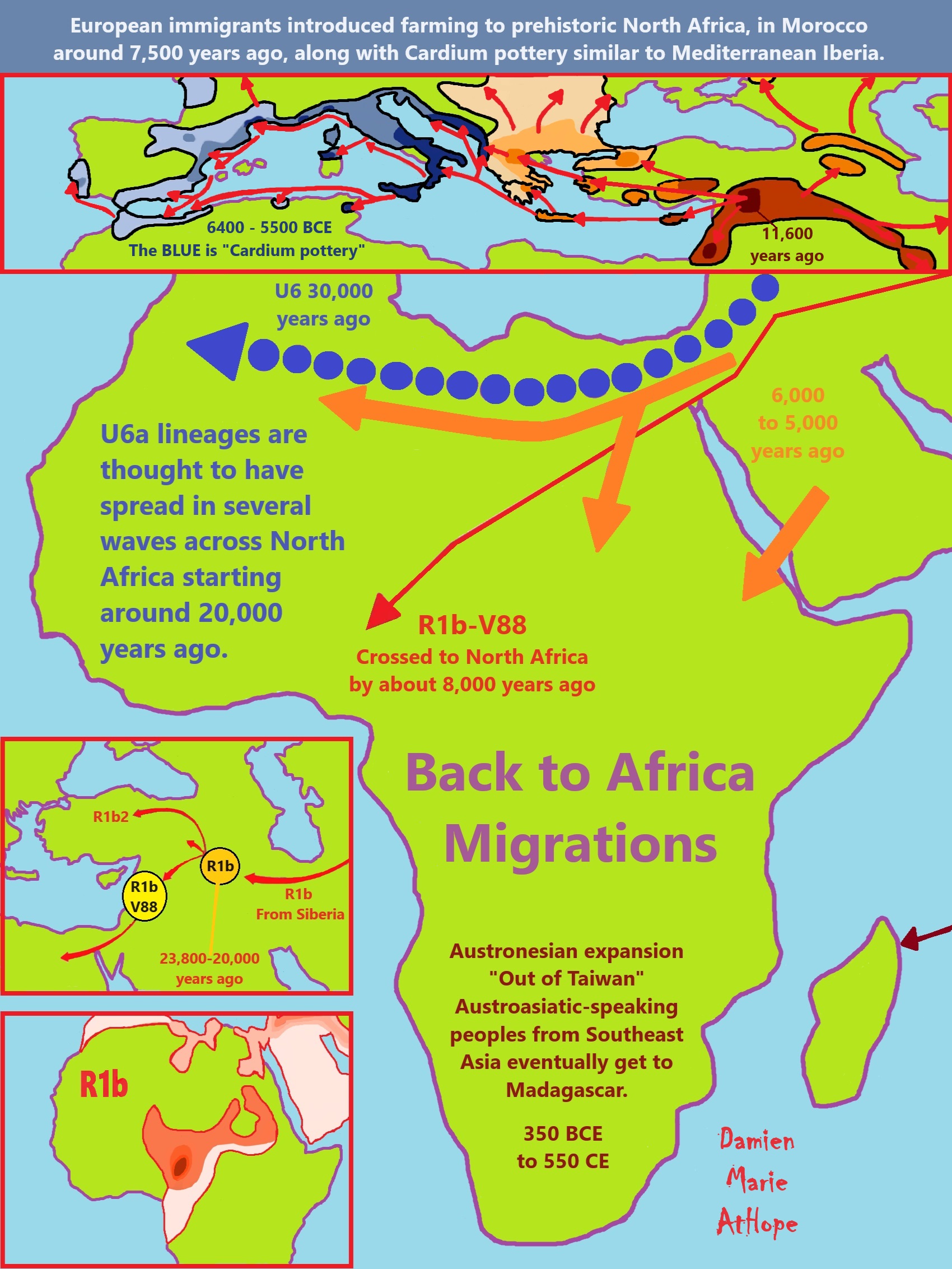
African Back Migrations and the Status of Shamanism Origins as well as its Spreading
“Various DNA studies have found Christian-era and modern Nubians along with modern Afro-Asiatic speaking populations in the Horn of Africa to be descended from a mix of West Eurasian and East African populations.” ref
“The results showed that King Tut belonged to a genetic profile group, known as haplogroup R1b1a2, to which more than 50 percent of all men in Western Europe belong, indicating that they share a common ancestor. Among modern-day Egyptians this haplogroup contingent is below 1 percent, according to iGENEA. Up to 70 percent of British men and half of all Western European men are related to the Egyptian Pharaoh Tutankhamun, geneticists in Switzerland said.” ref
“A 2020 study by Gad, Hawass, et al. analysed mitochondrial and Y-chromosomal haplogroups from Tutankhamun‘s family members of the 18th Dynasty, using comprehensive control procedures to ensure quality results. The study found that the Y-chromosome haplogroup of the family was R1b. Haplogroup R1b is carried by modern Egyptians. Modern Egypt is also the only African country that is known to harbor all three R1 subtypes, including R1b-M269. The Y-chromosome profiles for Tutankhamun and Amenhotep III were incomplete and the analysis produced differing probability figures despite having concordant allele results. Because the relationships of these two mummies with the KV55 mummy (identified as Akhenaten) had previously been confirmed in an earlier study, the haplogroup prediction of both mummies could be derived from the full profile of the KV55 data.” ref
“Genetic analysis indicated the following haplogroups for the 18th Dynasty:
- Amenhotep III: YDNA R1b& mtDNA H2b.
- Tutankhamun: YDNA R1b & mtDNA K.
- Akhenaten: YDNA R1b & mtDNA K.
- Tiye: mtDNA K.
- Yuya: YDNA G2a& mtDNA K.
- Thuya: mtDNA K.
Both Y-DNA haplogroups R1b and G2a, as well as both mtDNA haplogroups H and K, are carried by modern Egyptians.” ref
“In 2020, three mummies, dating from the 1st millennium BCE, from the Pushkin Museum of Arts collection were tested at the Kurchatov Institute of Moscow for their mitochondrial and Y-chromosomal haplogroups. Two of the mummies were found to belong to the Y-chromosomal haplogroup R1b1a1b (R1b-M269), which originated either in Eastern Europe or in the Near East, and to the Y-chromosome haplogroup E1b1b1a1b2a4b5a, which originated in North Africa. They also belonged to mtDNA haplogroups L3h1 and N5, common in Africans and Middle Easterners, respectively. The third mummy was found to belong to mtDNA haplogroup N, which is widely distributed across Eurasia as well as eastern and northeastern Africa.” ref
(Haplogroup N5 – found in India)
“In Southern Asia, N5 haplogroup, arose; N5 is extremely rare and has also been recently described in Iran, raising the possibility that this lineage could also have arisen in Southwest Asia. A greater number of N(xR) branches exist in Eastern Asia, Southeast Asia, and Australasia, showing that N(xR) certainly crossed into this region, along with lineages within R haplogroups.” ref
“”The Predynastic of Upper Egypt and the Late Dynastic of Lower Egypt are more closely related to each other than to any other population” and most similar to modern Egyptians among modern populations, stating that “the Egyptians have been in place since back in the Pleistocene and have been largely unaffected by either invasions or migrations.” The craniometric analysis of predynastic Naqada human remains found that they were closely related to other Afroasiatic-speaking populations inhabiting North Africa, parts of the Horn of Africa and the Maghreb, as well as to Bronze Age and medieval period Nubians and to specimens from ancient Jericho.” ref
“Kaiser’s chronology began c. 4000 BCE or around 6,000 years ago, but the modern version has been adjusted slightly, as follows:
- Naqada I(about 3900–3650 BCE or 5,900-5,650 years ago)
- black-topped and painted pottery
- trade with Nubia, Western Desertoases, and Eastern Mediterranean
- obsidianfrom Ethiopia
- Naqada II(about 3650–3300 BCE or 5,650-5,300 years ago)
- represented throughout Egypt
- first marlpottery, and metalworking
- Naqada III(about 3300–2900 BCE or 5,300-4,900 years ago)
- more elaborate grave goods, first Pharaohs
- cylindrical jars
- writing” ref
“The Naqada skeletons were also morphologically proximate to modern osteological series from Europe and the Indian subcontinent. However, the Naqada skeletons and these ancient and recent skeletons were phenotypically distinct from skeletons belonging to modern Niger-Congo-speaking populations inhabiting Sub-Saharan Africa and Tropical Africa, as well as from Mesolithic skeletons excavated at Wadi Halfa in the Nile Valley. ” ref
“The ancient Egyptian individuals in their own dataset possessed highly similar mtDNA haplogroup profiles, and cluster together, supporting genetic continuity across the 1,300-year transect. Modern Egyptians shared this mtDNA haplogroup profile, but also carried 8% more African component. A wide range of mtDNA haplogroups were found including clades of J, U, H, HV, M, R0, R2, K, T, L, I, N, X, and W. In addition, three ancient Egyptian individuals were analyzed for Y-DNA, two were assigned to Middle Eastern haplogroup J and one to haplogroup E1b1b1a1b2. Both of these haplogroups are carried by modern Egyptians, and are also common among Afroasiatic speakers in Northern Africa, Eastern Africa, and the Middle East. The researchers cautioned that the examined ancient Egyptian specimens may not be representative of those of all ancient Egyptians since they were from a single archaeological site from the northern part of Egypt.” ref
“The analyses revealed that Ancient Egyptians had higher affinities with Near Eastern and European populations than do modern Egyptians, likely due to the 8% increase in the African component found in modern Egyptians. The absolute estimates of sub-Saharan African ancestry in these three ancient Egyptian individuals ranged from 6 to 15%, and the absolute estimates of sub-Saharan African ancestry in the 135 modern Egyptian samples ranged from 14 to 21%, which show an 8% increase in African component.” ref
“The age of the ancient Egyptian samples suggests that this 8% increase in African component occurred predominantly within the last 2000 years. Verena Schuenemann and the authors of this study suggest a high level of genetic interaction with the Near East since ancient times, probably going back to Prehistoric Egypt although the oldest mummies at the site were from the New Kingdom: “Our data seem to indicate close admixture and affinity at a much earlier date, which is unsurprising given the long and complex connections between Egypt and the Middle East. These connections date back to Prehistory and occurred at a variety of scales, including overland and maritime commerce, diplomacy, immigration, invasion and deportation. According to the results of an analysis published by FTDNA in 2023, Nakht Ankh’s most likely Y-DNA haplogroup was H-Z19008, a subclade of H2.” ref
“The primary branch H2 (P96) seems to have been found in sparse levels primarily in Europe and West Asia since prehistory. It has been found in remains of the Pre-Pottery Neolithic B (PPNB), which is part of the Pre-Pottery Neolithic, a Neolithic culture centered in upper Mesopotamia and the Levant, dating to c. 10,800 – c. 8,500 years ago, and also the later Linear Pottery culture and Neolithic Iberia. H2 likely entered Europe during the Neolithic with the spread of agriculture. The earliest sample of H2 is found in the Pre-Pottery Neolithic B culture of the Levant 10,000 years ago. From ancient samples, it is clear that H2 also has a strong association with the spread of agriculture from Anatolia into Europe, and is commonly found with haplogroup G2a. H2 was found in Neolithic Anatolia, as well as in multiple later Neolithic cultures of Europe, such as the Vinča culture in Serbia, and the Megalith culture of Western Europe. While being found in numerous ancient samples, H2 has only been found scarcely in modern populations across West Eurasia.” ref
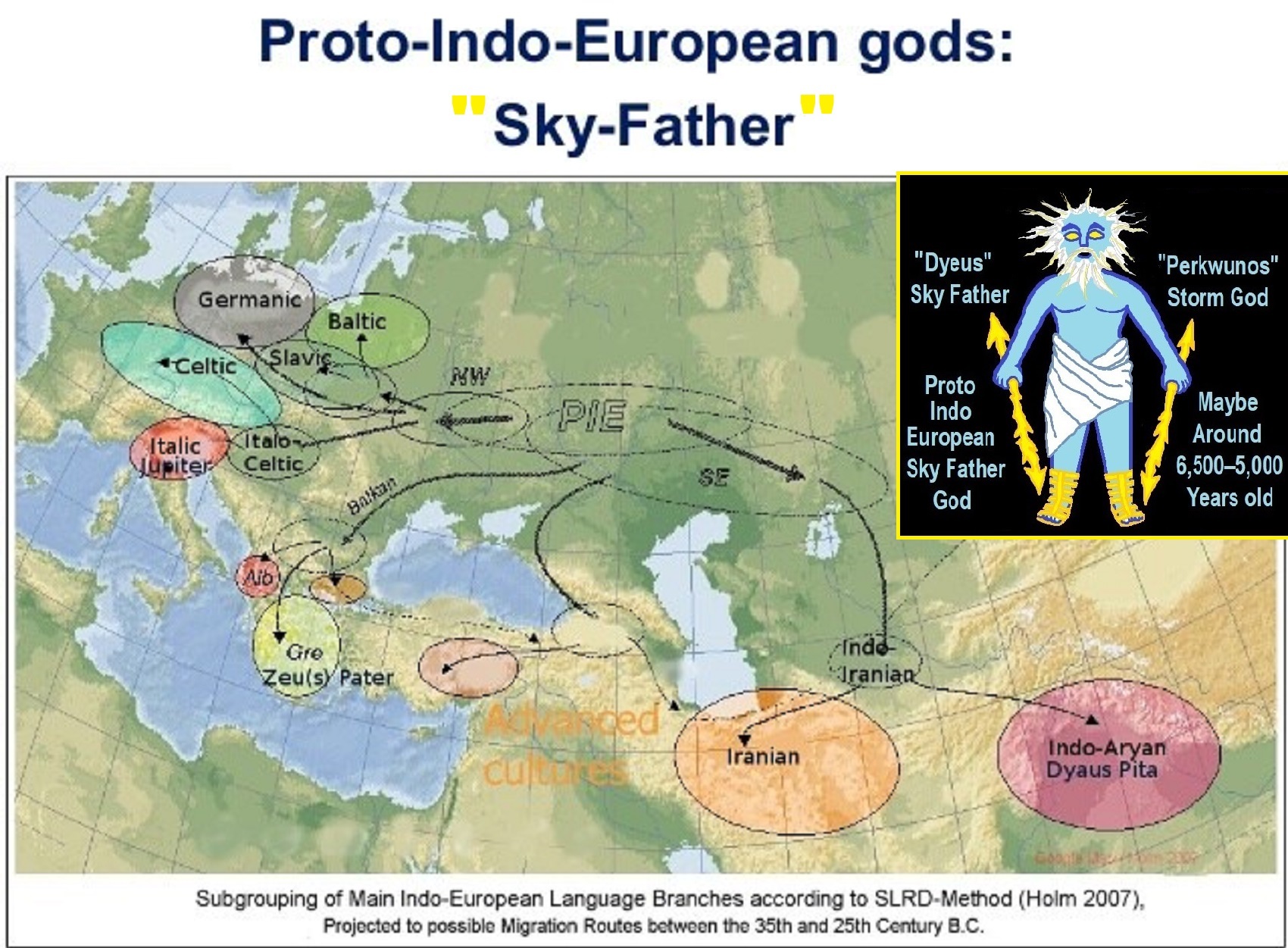
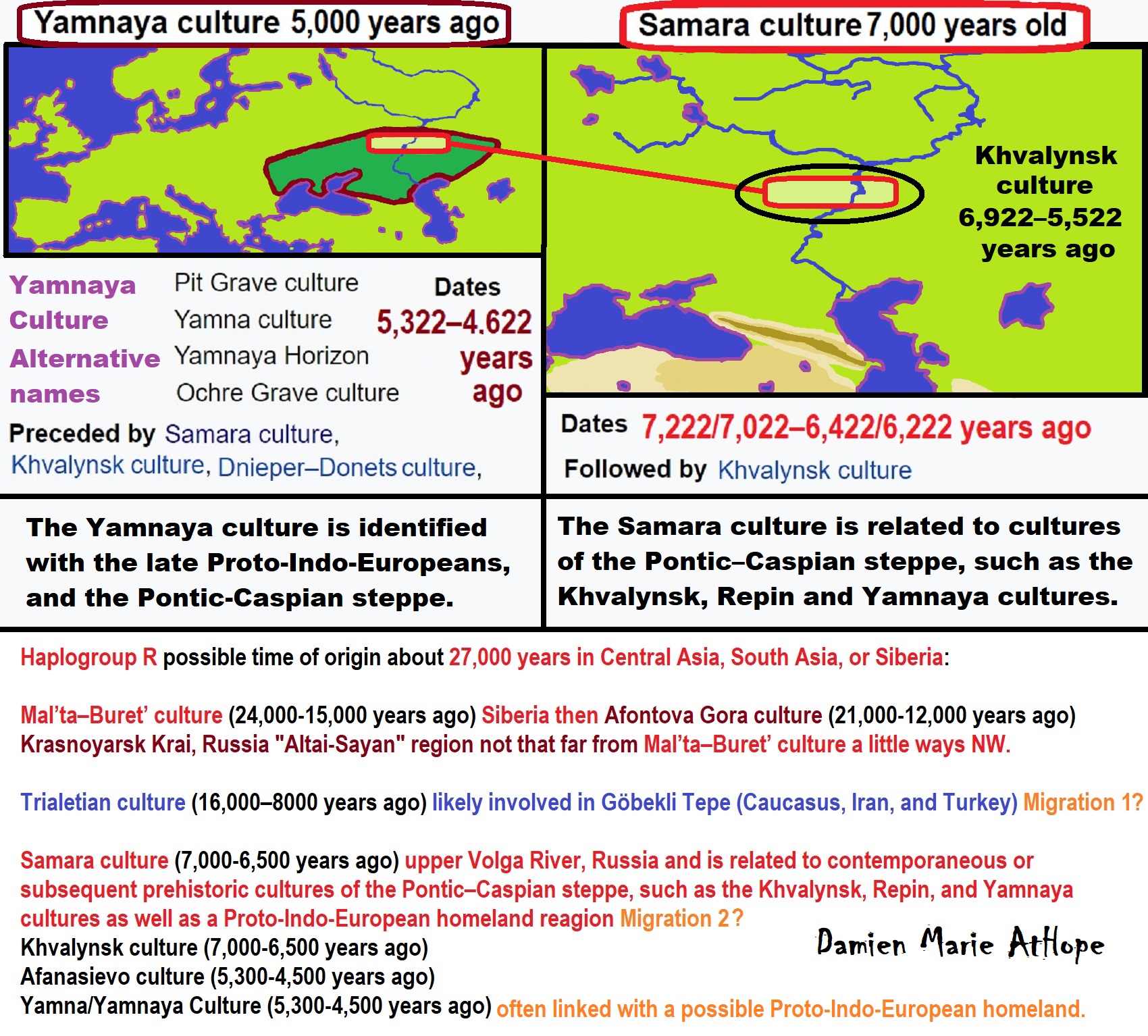
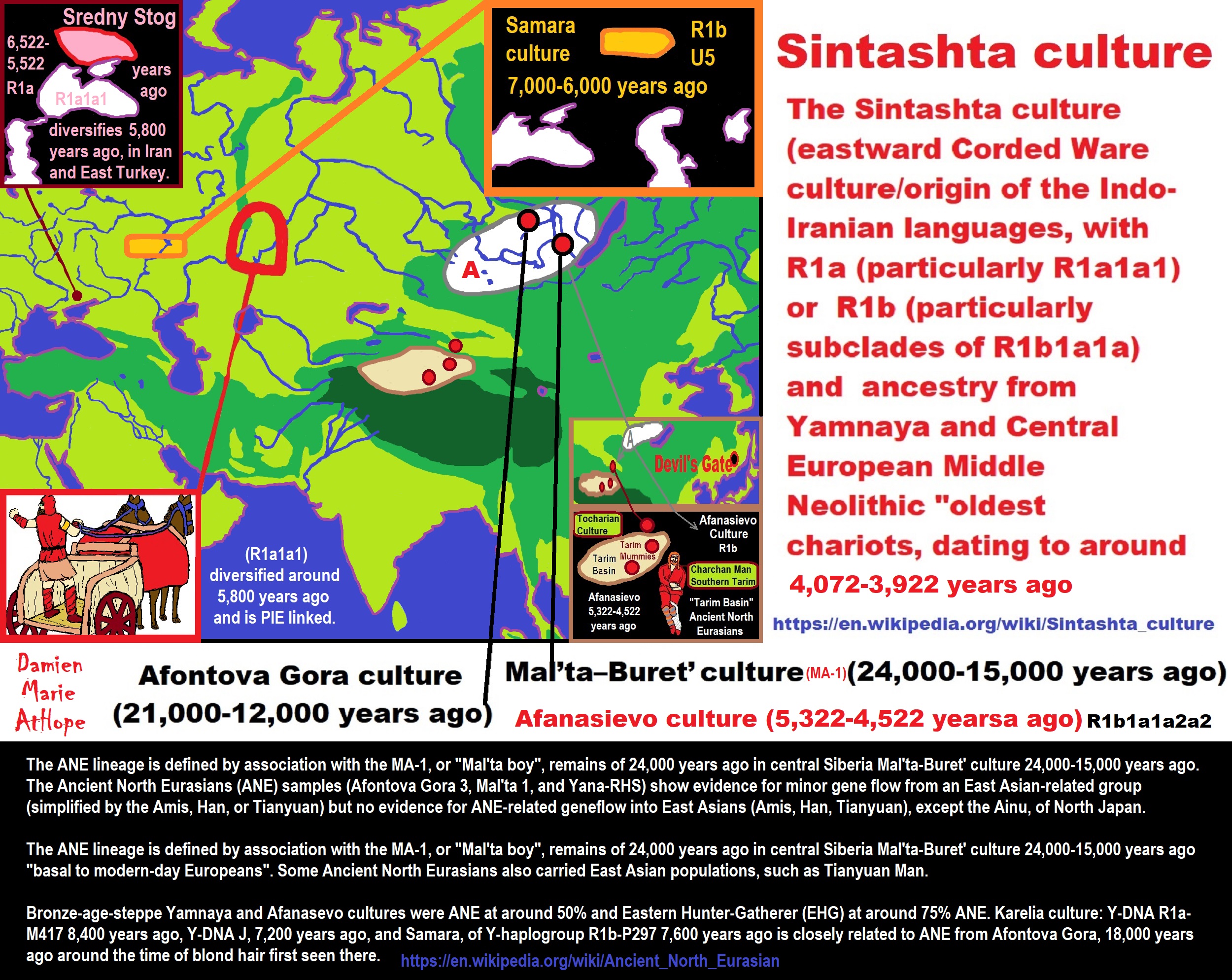
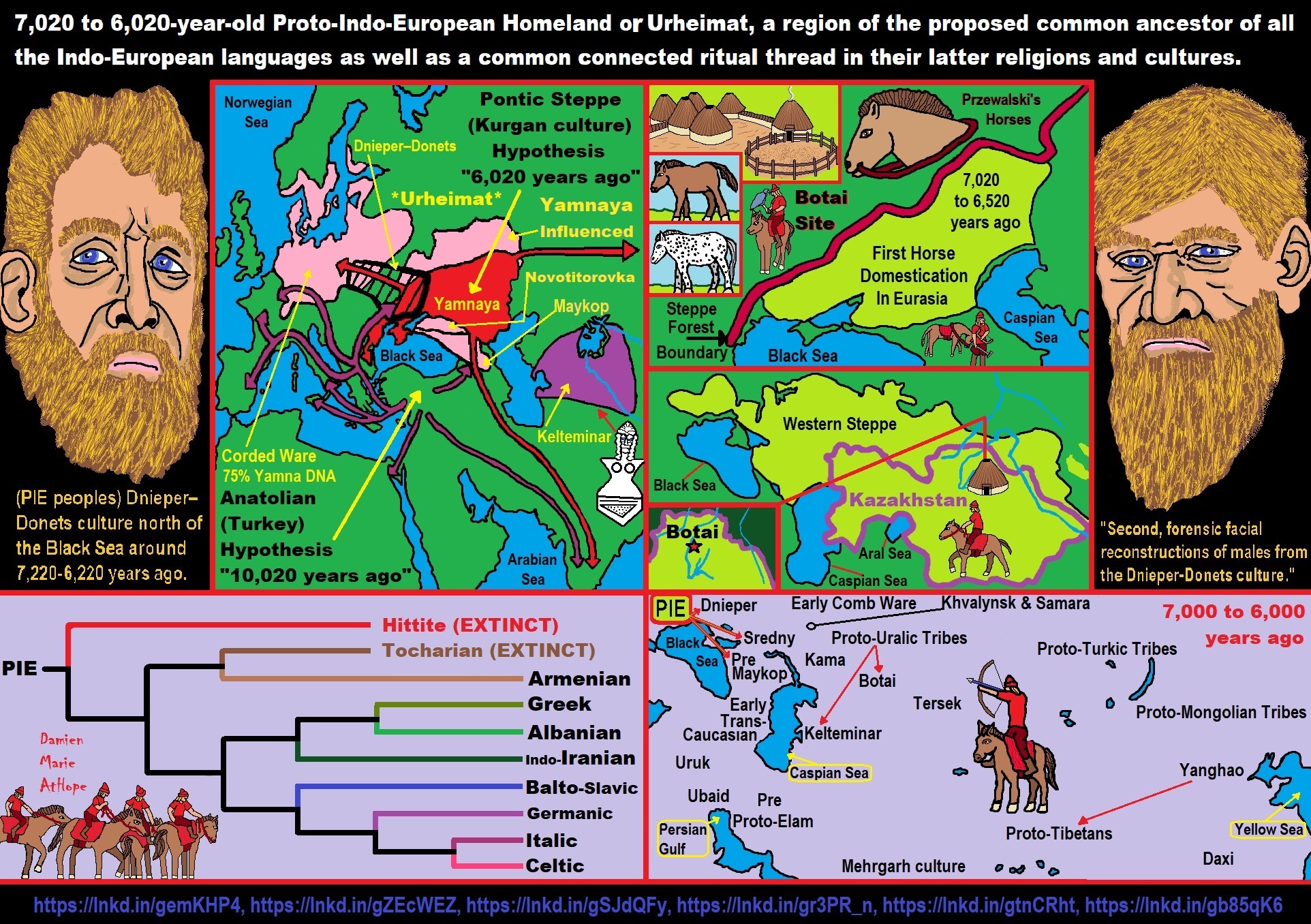
- My Thoughts on Possible Migrations of “R” DNA and Proto-Indo-European?
- Proto-Indo-European (PIE), ancestor of Indo-European languages: DNA, Society, Language, and Mythology
- Indo-European language Trees fit an Agricultural expansion from Anatolia beginning 8,000 – 9,500 years ago?
- 7,020 to 6,020-year-old Proto-Indo-European Homeland of Urheimat or proposed home of their Language and Religion
- Understanding Proto-Indo-Europeans and Paganism Religions
- Hell and Underworld mythologies starting maybe as far back as 7,000 to 5,000 years ago with the Proto-Indo-Europeans?
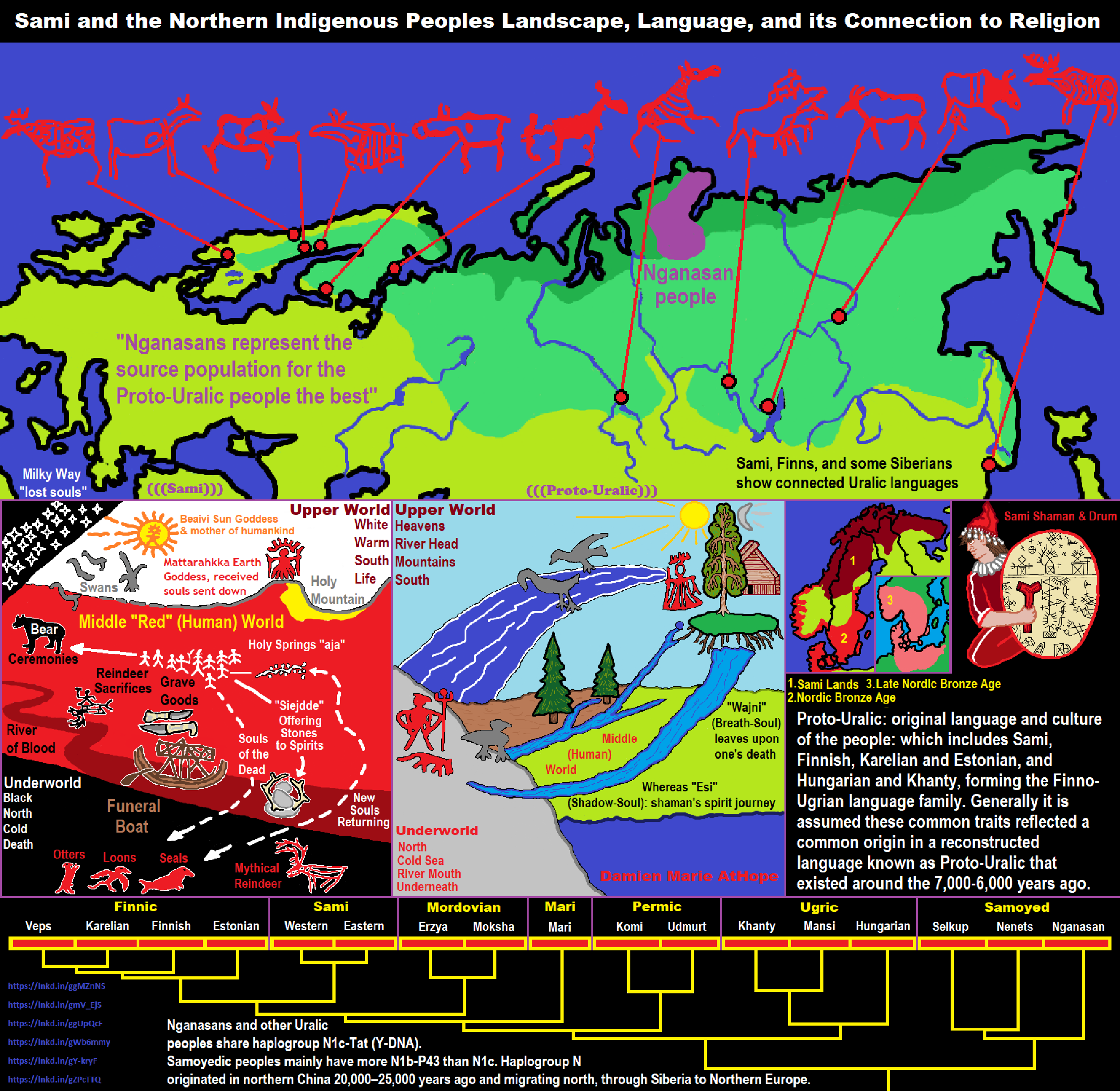
When was the beginning:
TIMELINE OF CURRENT RELIGIONS?
Around 4,000 years ago
Hinduism around 3,700 to 3,500 years old. ref
Judaism around 3,450 or 3,250 years old. (The first writing in the bible was “Paleo-Hebrew” dated to around 3,000 years ago Khirbet Qeiyafa is the site of an ancient fortress city overlooking the Elah Valley. And many believe the religious Jewish texts were completed around 2,500) ref, ref
Judaism is around 3,450 or 3,250 years old. (“Paleo-Hebrew” 3,000 years ago and Torah 2,500 years ago)
“Judaism is an Abrahamic, its roots as an organized religion in the Middle East during the Bronze Age. Some scholars argue that modern Judaism evolved from Yahwism, the religion of ancient Israel and Judah, by the late 6th century BCE, and is thus considered to be one of the oldest monotheistic religions.” ref
“Yahwism is the name given by modern scholars to the religion of ancient Israel, essentially polytheistic, with a plethora of gods and goddesses. Heading the pantheon was Yahweh, the national god of the Israelite kingdoms of Israel and Judah, with his consort, the goddess Asherah; below them were second-tier gods and goddesses such as Baal, Shamash, Yarikh, Mot, and Astarte, all of whom had their own priests and prophets and numbered royalty among their devotees, and a third and fourth tier of minor divine beings, including the mal’ak, the messengers of the higher gods, who in later times became the angels of Judaism, Christianity and Islam. Yahweh, however, was not the ‘original’ god of Israel “Isra-El”; it is El, the head of the Canaanite pantheon, whose name forms the basis of the name “Israel”, and none of the Old Testament patriarchs, the tribes of Israel, the Judges, or the earliest monarchs, have a Yahwistic theophoric name (i.e., one incorporating the name of Yahweh).” ref
“El is a Northwest Semitic word meaning “god” or “deity“, or referring (as a proper name) to any one of multiple major ancient Near Eastern deities. A rarer form, ‘ila, represents the predicate form in Old Akkadian and in Amorite. The word is derived from the Proto-Semitic *ʔil-, meaning “god”. Specific deities known as ‘El or ‘Il include the supreme god of the ancient Canaanite religion and the supreme god of East Semitic speakers in Mesopotamia’s Early Dynastic Period. ʼĒl is listed at the head of many pantheons. In some Canaanite and Ugaritic sources, ʼĒl played a role as father of the gods, of creation, or both. For example, in the Ugaritic texts, ʾil mlk is understood to mean “ʼĒl the King” but ʾil hd as “the god Hadad“. The Semitic root ʾlh (Arabic ʾilāh, Aramaic ʾAlāh, ʾElāh, Hebrew ʾelōah) may be ʾl with a parasitic h, and ʾl may be an abbreviated form of ʾlh. In Ugaritic the plural form meaning “gods” is ʾilhm, equivalent to Hebrew ʾelōhîm “powers”. In the Hebrew texts this word is interpreted as being semantically singular for “god” by biblical commentators. However the documentary hypothesis for the Old Testament (corresponds to the Jewish Torah) developed originally in the 1870s, identifies these that different authors – the Jahwist, Elohist, Deuteronomist, and the Priestly source – were responsible for editing stories from a polytheistic religion into those of a monotheistic religion. Inconsistencies that arise between monotheism and polytheism in the texts are reflective of this hypothesis.” ref
Jainism around 2,599 – 2,527 years old. ref
Confucianism around 2,600 – 2,551 years old. ref
Buddhism around 2,563/2,480 – 2,483/2,400 years old. ref
Christianity around 2,o00 years old. ref
Shinto around 1,305 years old. ref
Islam around 1407–1385 years old. ref
Gobekli Tepe: “first human made temple”
Catal Huyuk “first religious designed city”
Possible Religion Motivations in the First Cave Art?
Interconnectedness of religious thinking
Animism, Totemism, Shamanism, and Paganism and Beyond
So, it all starts in a general way with Animism (theoretical belief in supernatural powers/spirits), then this is physically expressed in or with Totemism (theoretical belief in mythical relationship with powers/spirits through a totem item), which then enlists a full-time specific person to do this worship and believed interacting Shamanism (theoretical belief in access and influence with spirits through ritual), and then there is the further employing of myths and gods added to all the above giving you Paganism (often a lot more nature-based than most current top world religions, thus hinting to their close link to more ancient religious thinking it stems from). My hypothesis is expressed with an explanation of the building of a theatrical house (modern religions development). Sky Burials: Animism, Totemism, Shamanism, and Paganism
What is the Afterlife in most religions?
Why do people think Religion is much more than supernaturalism and superstitionism?
Need to Mythicized: gods and goddesses
Single God Religions (Monotheism) = Man-o-theism
Sexism in the Major World Religions
The Evolution of Fire Sacralizing and/or Worship
* “totemist” Believe in spirit-filled life and/or afterlife can be attached to or be expressed in things or objects (you are a hidden totemist/Totemism: an approximately 50,000-year-old belief system (though it may be older as there is evidence of what looks like a Stone Snake in South Africa which may be the “first human worship” dating to around 70,000 years ago) (possibly extending to or from Neanderthals Likewise a number of archeologists propose that Middle Paleolithic societies — such as that of the Neanderthals — may also have practiced the earliest form of totemism or animal worship in addition to their (presumably religious) burial of the dead. Emil Bächler in particular suggests (based on archeological evidence from Middle Paleolithic caves) that a widespread Neanderthal bear-cult existed. Animal cults in the following Upper Paleolithic period — such as the bear cult — may have had their origins in these hypothetical Middle Paleolithic animal cults. Animal worship during the Upper Paleolithic intertwined with hunting rites. For instance, archeological evidence from art and bear remains reveals that the bear cult apparently had involved a type of sacrificial bear ceremonialism in which a bear was shot with arrows and then was finished off by a shot in the lungs and ritualistically buried near a clay bear statue covered by a bear fur, with the skull and the body of the bear buried separately. 100,000 to 50,000 years ago – Increased use of red ochre at several Middle Stone Age sites in Africa. Red Ochre is thought to have played an important role in ritual. 42,000 years ago – Ritual burial of a man at Lake Mungo in Australia. The body is sprinkled with copious amounts of red ochre. 40,000 years ago – Upper Paleolithic begins in Europe. An abundance of fossil evidence includes elaborate burials of the dead, Venus figurines (depiction of female) and cave art also involving red ochre. Venus figurines are thought to represent fertility. The cave paintings at Chauvet and Lascaux are believed to represent religious thought. ref
What is a god, as most so-called god claims sound like hidden animist inspiring Anthropomorphism conclusions/confusions about the nature of reality? Are you asking me if magic exists? I am not a hidden animist. If so, well my answer as an ignostic atheist is, first prove the actuality of simple magic before you try to ask anyone about the possibility of some supreme magic.
Timeline of religion – Wikipedia
The timeline of religion is a chronological catalogue of important and noteworthy religious events in pre-historic and modern times. This article reaches into pre-historic times, as the bulk of the human religious experience pre-dates written history. Written history (the age of formal writing) is only around 5000 years old. A lack of written records results in most of the knowledge of pre-historic religion being derived from archaeological records and other indirect sources, and from suppositions. Much pre-historic religion is subject to continued debate. ref
According to Pettitt, Paul (August 2002). “When Burial Begins”. British Archeology. No. 66. Archived from the original on 2 June 2007, 15,000–10,000 years ago noticeable burial activity resumed. Prior mortuary activity had either taken a less obvious form or contemporaries retained some of their burial knowledge in the absence of such activity. Dozens of men, women, and children were being buried in the same caves which were used for burials 10,000 years beforehand. All these graves are delineated by the cave walls and large limestone blocks. The burials share a number of characteristics (such as use of ochre, and shell and mammoth ivory jewellery) that go back thousands of years. Some burials were double, comprising an adult male with a juvenile male buried by his side. They were now beginning to take on the form of modern cemeteries. Old burials were commonly re-dug and moved to make way for new ones, with the older bones often being gathered and cached together. Large stones may have acted as grave markers. Pairs of ochred antlers were sometimes mounted on poles within the cave; this is compared to the modern practice of leaving flowers at a grave. ref
11,130–9,370 years ago or so: This was the apparent period of use of Göbekli Tepe, one of the oldest human-made sites of worship yet discovered; evidence of similar usage has also been found in another nearby site, Nevalı Çori. This period is also noted as the beginning of the First Sangam period in South India. ref
- 9,500–9,700 years ago or so: The settlements of Catalhoyuk developed as a likely spiritual center of Anatolia. Possibly practicing worship in communal shrines, its inhabitants left behind numerous clay figurines and impressions of phallic, feminine and hunting scenes. ref
- 7,500–6,500 years ago or so: The Proto-Indo-Europeans (PIE) emerged, probably within the Pontic-Caspian steppe (though their exact urheimat is debated). The PIE peoples developed a religion focused on sacrificial ideology, which would influence the religions and cultures throughout Eurasia. ref
- 5,102 years ago or so: This was the beginning of Kaliyuga, a new age among the followers of Indian religions. ref
- 5,100 years ago or so: The initial form of Stonehenge was completed. The circular bank and ditch enclosure, about 110 metres (360 ft) across, may have been completed with a timber circle. ref
- 5,100–4,900 years ago or so: Newgrange, the 250,000 ton (226,796.2 tonne) passage tomb aligned to the winter solstice in Ireland, was built. ref
- 5,000 years ago or so: Sumerian Cuneiform emerged from the proto-literateUruk period, allowing the codification of beliefs and creation of detailed historical religious records. The second phase of Stonehenge was completed and appeared to function as the first enclosed cremation cemetery in the British Isles. ref
- 4,635–4,610 years ago or so: The oldest surviving Egyptian Pyramid was commissioned by Pharaoh Djoser. ref
- 4,600 years ago or so: Stonehenge began to take on the form of its final phase. The wooden posts were replaced with bluestone. It began taking on an increasingly complex setup (including an altar, a portal, station stones, etc.) and shows consideration of solar alignments. ref
- 4,560 years ago or so: This is the approximate time accepted as the completion of the Great Pyramid of Giza, the oldest pyramid of the Giza Plateau. ref
- 4,494–4,345 years ago or so: The first of the oldest surviving religious texts, the Pyramid Texts, was composed in Ancient Egypt. ref
- 4,200 years ago or so: The Minoan Civilization developed in Crete. Citizens worshipped a variety of goddesses. ref
- 4,150–4,000 years ago or so: The earliest surviving versions of the Sumerian Epic of Gilgamesh—originally titled He who Saw the Deep (Sha naqba īmuru) or Surpassing All Other Kings (Shūtur eli sharrī)—were written. ref
- 3,700–3,100 years ago or so: The oldest of the Hindu Vedas (scriptures), the Rig Veda was composed. ref
- 3,600 years ago or so: The ancient development of Stonehenge came to an end. ref
- 3,500 years ago or so: The Vedic Age began in India after the collapse of the Indus Valley Civilisation. ref
3,450 or 3,250 years ago or so: This is the traditionally accepted period in which, according to legend, the Israelite lawgiver Moses gave the Ten Commandments ref The Hebrew Bible, or the Old Testament (abbreviated OT) is the first part of Christian Bibles based primarily upon the Hebrew Bible (or Tanakh), a collection of ancient religious writings by the Israelites dates to around 2,500/2,400 or less. The most accepted hypothesis, the canon formed in stages, first the Pentateuch by around 400 BC, then the Prophets during the Hasmonean dynasty (140-116 BC), and finally the remaining books. Christians traditionally divide the Old Testament into four sections: (1) the first five books or Pentateuch (Torah); (2) the history books telling the history of the Israelites, from their conquest of Canaan to their defeat and exile in Babylon; (3) the poetic and “Wisdom books” dealing, in various forms, with questions of good and evil in the world; and (4) the books of the biblical prophets, warning of the consequences of turning away from God. ref The bible inspired religion was not one thing but many:
(Henotheism Exodus 20:23 “You shall not make other gods besides Me (not saying there are no other gods just not to worship hem); gods of silver or gods of gold, you shall not make for yourselves.”
(Polytheism: Judges 10:6 “Then the sons of Israel again did evil in the sight of the LORD, served the Baals and the Ashtaroth, the gods of Aram, the gods of Sidon, the gods of Moab, the gods of the sons of Ammon, and the gods of the Philistines; thus they forsook the LORD and did not serve Him. 1 Corinthians 8:5 “For even if there are so-called gods whether in heaven or on earth, as indeed there are many gods and many lords.”)
In the Hebrew Bible, there are multiple descriptions of Yahweh presiding over a great assembly of Heavenly Hosts. Some interpret these assemblies as examples of Divine Council: “The Old Testament description of the ‘divine assembly’ all suggest that this metaphor for the organization of the divine world was consistent with that of Mesopotamia and Canaan. One difference, however, should be noted. In the Old Testament, the identities of the members of the assembly are far more obscure than those found in other descriptions of these groups, as in their polytheistic environment. Israelite writers sought to express both the uniqueness and the superiority of their God Yahweh.” The Book of Psalms (Psalm 82:1), states “God (אֱלֹהִ֔ים elohim) stands in the divine assembly (בַּעֲדַת-אֵל ); He judges among the gods (אֱלֹהִ֔ים elohim)” (אֱלֹהִים נִצָּב בַּעֲדַת־אֵל בְּקֶרֶב אֱלֹהִים יִשְׁפֹּט). The meaning of the two occurrences of “elohim” has been debated by scholars, with some suggesting both words refer to Yahweh, while others propose that the God of Israel rules over a divine assembly of other Gods or angels. Some translations of the passage render “God (elohim) stands in the congregation of the mighty to judge the heart as God (elohim)” (the Hebrew is “beqerev elohim”, “in the midst of gods”, and the word “qerev” if it were in the plural would mean “internal organs”). Later in this Psalm, the word “gods” is used (in the KJV): Psalm 82:6 – “I have said, Ye [are] gods; and all of you [are] children of the most High.” Instead of “gods”, another version has “godlike beings”, but here again, the word is elohim/elohiym (Strong’s H430). This passage is quoted in the New Testament in John 10:34. In the Books of Kings (1 Kings 22:19), the prophet Micaiah has a vision of Yahweh seated among “the whole host of heaven” standing on his right and on his left. He asks who will go entice Ahab and a spirit volunteers. This has been interpreted as an example of a divine council. The first two chapters of the Book of Job describe the “Sons of God” assembling in the presence of Yahweh. Like “multitudes of heaven”, the term “Sons of God” defies certain interpretation. This assembly has been interpreted by some as another example of divine council. Others translate “Sons of God” as “angels”, and thus argue this is not a divine council because angels are God’s creation and not deities. “The role of the divine assembly as a conceptual part of the background of Hebrew prophecy is clearly displayed in two descriptions of prophetic involvement in the heavenly council. In 1 Kings 22:19-23… Micaiah is allowed to see God (elohim) in action in the heavenly decision regarding the fate of Ahab. Isaiah 6 depicts a situation in which the prophet himself takes on the role of the messenger of the assembly and the message of the prophet is thus commissioned by Yahweh. The depiction here illustrates this important aspect of the conceptual background of prophetic authority.” The concept of a divine assembly (or council) is attested in the archaic Sumerian, Akkadian, Old Babylonian, Ancient Egyptian, Babylonian, Caananite, Israelite, Celtic, Ancient Greek and Ancient Roman and Nordic pantheons. Ancient Egyptian literature reveals the existence of a “synod of the gods”. Some of our most complete descriptions of the activities of the divine assembly are found in the literature from Mesopotamia. Their assembly of the gods, headed by the high god Anu, would meet to address various concerns. The term used in Sumerian to describe this concept was Ukkin, and in later Akkadian and Aramaic was puhru. Sons of God (Heb: bənê hāʼĕlōhîm, בני האלהים) is a phrase used in the Hebrew Bible and apocrypha. The phrase is also used in Kaballah where Bene elohim are part of different Jewish angelic hierarchies. ref, ref
Genesis 6: When man began to multiply on the face of the land and daughters were born to them, the sons of God saw that the daughters of man were attractive. And they took as their wives any they chose. Then the Lord said, “My Spirit shall not abide in man forever, for he is flesh: his days shall be 120 years.” The Nephilim were on the earth in those days, and also afterward, when the sons of God came in to the daughters of man and they bore children to them. These were the mighty men who were of old, the men of renown. — Genesis 6:1-4
The first mention of “sons of God” in the Hebrew Bible occurs at Genesis 6:1-4. In terms of literary-historical origin, this phrase is typically associated with the Jahwist tradition. This passage has had two interpretations in Judaism.
- Offspring of Seth: The first references to the offspring of Seth rebelling from God and mingling with the daughters of Cain are found in Christian and Rabbinic literature from the second century CE onwards e.g. Rabbi Shimon bar Yochai, Augustine of Hippo, Julius Africanus, and the Letters attributed to St. Clement. It is also the view expressed in the modern canonical Amharic Ethiopian Orthodox Bible. In Judaism “Sons of God” usually refers to the righteous, i.e. the children of Seth.
- Angels: All of the earliest sources interpret the “sons of God” as angels. From the 2,300 years ago onwards, references are found in the Enochic literature, the Dead Sea Scrolls the (Genesis Apocryphon, the Damascus Document, 4Q180), Jubilees, the Testament of Reuben, 2 Baruch, Josephus, and the book of Jude (compare with 2 Peter 2). This is also the meaning of the only two identical occurrences of bene ha elohim in the Hebrew Bible (Job 1:6 and 2:1), and of the most closely related expressions (refer to the list above). In the Septuagint, the interpretive reading “angels” is found in Codex Alexandrinus, one of four main witnesses to the Greek text. ref
Rabbinic Judaism traditionally adheres to the first interpretation, with some exceptions, and modern Jewish translations may translate bnei elohim as “sons of rulers” rather than “sons of God”. Regardless, the second interpretation (sons of angels or other divine beings) is nonexistent in modern Judaism. This is reflected by the rejection of Enoch and other Apocrypha supporting the second interpretation from the Hebrew Bible Canon. Joseph Hong believes that Genesis 6:1-4 has gone through drastic abridgment by either the original writer or later editors. Nahum M. Sarna believes that the text defies certain interpretation, based on difficulties with the text’s themes, extreme terseness, vocabulary, and syntax. Sarna postulates that such a passage cannot be other than a fragment, or bare outline, from a well-known fuller story. ref, ref
(Monotheism: Isaiah 43:10 “You are my witnesses,” declares the LORD, “and my servant whom I have chosen, so that you may know and believe me and understand that I am he. Before me no god was formed, nor will there be one after me.
- 3,351 or 3,353 years ago or so: The reign of Akhenaten, sometimes credited with starting the earliest known recorded monotheistic or at least Henotheism a religion, in Ancient Egypt. ref
- 3,300 – 3,000 years ago or so: The “standard” Akkadian version of the Epic of Gilgamesh was edited by Sin-liqe-unninni. ref
- 3,250 – 2,600 years ago or so: The Upanishads (Vedic texts) were composed, containing the earliest emergence of some of the central religious concepts of Hinduism, Buddhism and Jainism. ref
- 3,200 years ago or so: The Olmecs built the earliest pyramids and temples in Central America. ref
2,800 to 2,600 years ago or so: The Chandogya Upanishad is compiled, significant for containing the earliest to date mention of Krishna. Verse 3.17.6 mentions Krishna Devakiputra as a student of the sage Ghora Angirasa. ref
- 2,600 – 2,500 years ago or so: The Earliest Confucian type writing, Shu Ching, incorporates ideas of harmony and heaven. ref
- 2,599 – 2,527 years ago or so: The life of Mahavira, 24th and last Tirthankara of Jainism. The Kalpasutra, a popular text in Jainism, cites Kundagrama as the place where he was born, Present-day Vaishali district, Bihar, India. Though it is universally accepted by scholars of Jainism that Mahavira was an actual person who lived in ancient India, the details of his biography and the year of his birth are uncertain, and continue to be a subject of considerable debate among scholars. The Jain Śvētāmbara tradition believes he was born in 599 BC and died in 527 BC, while the Digambara tradition believes 510 BC was the year he died. The scholarly controversy arises from efforts to date him and the Buddha, because both are believed to be contemporaries according to Buddhist and Jain texts, and because, unlike for Jain literature, there is extensive ancient Buddhist literature that has survived. Almost all Indologists and historians, state Dundas and others, accordingly date Mahavira’s birth to about 497 BC and his death to about 2,425 years ago. However, the Vira era tradition that started in 527 BC and places Mahavira in the 6th century BC is a firmly established part of the Jain community tradition. The 12th-century Jain scholar Hemachandra placed Mahavira in the 5th century BC. According to Kailash Jain, Hemachandra made an incorrect analysis that, along with attempts to establish Buddha’s nirvana date, has been a source of confusion and controversy about Mahavira’s year of nirvana. Kailash Jain states the traditional date of 527 BC is accurate, adding that the Buddha was a junior contemporary of the Mahavira and that the Buddha “might have attained nirvana a few years later”. The place of his death, Pavapuri (now in Bihar), is a pilgrimage site for Jains. According to the Digambara Jains, Mahavira was born in 582 BC. According to the Svetambara Jain texts, he was born in 599 BC. Mahavira’s birthday, in the traditional calendar, falls on the thirteenth day of the rising moon in the month of Chaitra in the Vira Nirvana Samvat calendar. In the Gregorian calendar, this date falls in March or April and is celebrated by Jains as Mahavir Jayanti. ref, ref
- 2,563/2,480 – 2,483/2,400 years ago or so: Gautama Buddha, founder of Buddhism was born. ref
- 2,551 years ago or so: Confucius, founder of Confucianism, was born. ref
- 2,440 years ago or so: Zoroastrianism entered recorded history. ref
- 2,399 years ago or so: Socrates was tried for impiety.2,300 years ago or so: The oldest known version of the Tao Te Ching was written on bamboo tablets. ref
- 2,300 years ago or so: Theravada Buddhism was introduced to Sri Lanka by the Venerable Mahinda. ref
- 2,250 years ago or so: The Third Buddhist council was convened. ref
- 2,100 – 1,517 years ago or so: The Yoga Sūtras of Patañjali, constituting the foundational texts of Yoga, were composed. ref
The Common Era
Around years 30/33: The reported death of Jesus of Nazareth, the central figure of Christianity. ref
- Around years 31-36: The death of John the Baptist. ref
- Around years 70: The Siege of Jerusalem, the Destruction of the Temple and the rise of Rabbinic Judaism. ref
- Around years 220: Manichaean Gnosticism was formed by the prophet Mani. ref
- Around years 250–900: Classic Mayan step pyramids were constructed. ref
- Around years 313: The Edict of Milan decreed religious toleration in the Roman empire. ref
- Around years 325: The first ecumenical council (the Council of Nicaea) was convened to attain a consensus on doctrine through an assembly representing all Christendom. It established the original Nicene Creed and fixed the date of Easter. It also confirmed the primacy of the Sees of Rome, Alexandria and Antioch, and granted the See of Jerusalem a position of honor. ref
- Around years 350: The oldest record of the complete biblical texts (the Codex Sinaiticus) survives in a Greek translation called the Septuagint, dating to the 4th century CE. ref
- Around years 380: Theodosius I declared Nicene Christianity the state religion of the Roman Empire. ref
- Around years 381: The second ecumenical council (the First Council of Constantinople) reaffirmed and revised the Nicene Creed, repudiating Arianism and Macedonianism. ref
- Around years 381–391: Theodosius proscribed paganism within the Roman Empire. ref
- Around years 393: A council of early Christian bishops listed and approved a biblical canon for the first time at the Synod of Hippo. ref
Around years 405: St. Jerome completed the Vulgate, the first Latin translation of the Bible. ref
- Around years 410: The Western Roman Empire began to decline, signalling the onset of the Dark Ages. ref
- Around years 424: The Assyrian Church of the East formally separated from the See of Antioch and the western Syrian Church. ref
- Around years 431: The third ecumenical council (the First Council of Ephesus) was convened as a result of the controversial teachings of Nestorius of Constantinople. It repudiated Nestorianism, proclaimed the Virgin Mary as the Theotokos (the God-bearer or Mother of God). It also repudiated Pelagianism and again reaffirmed the Nicene Creed. ref
- Around years 449: The Second Council of Ephesus declared support for Eutyches and attacked his opponents. Originally convened as an ecumenical council, its ecumenical nature was rejected by the Chalcedonians, who denounced the council as latrocinium. ref
- Around years 451: The fourth ecumenical council (the Council of Chalcedon) rejected the Eutychian doctrine of monophysitism, adopting instead the Chalcedonian Creed. It reinstated those deposed in 449, deposed Dioscorus of Alexandria and elevated the bishoprics of Constantinople and Jerusalem to the status of patriarchates. ref
- Around years 451: The Oriental Orthodox Church rejected the christological view put forth by the Council of Chalcedon and was excommunicated. ref
- Around years 480–547: Benedict of Nursia wrote his Rule, laying the foundation of Western Christian monasticism. ref
- Around years 553: The fifth ecumenical council (the Second Council of Constantinople) repudiated the Three Chapters as Nestorian and condemned Origen of Alexandria. ref
- Around years 632–661: The Rashidun Caliphate heralded the Arab conquest of Persia, Egypt and Iraq, bringing Islam to those regions. ref
Around years 610 –632: Muslims believe that the verses of the Quran were revealed to Muhammad by God through the archangel Gabriel (Jibrīl) on many occasions between 610 CE until his death on June 8, 632. While Muhammad was alive, all of these revelations were written down by his companions (sahabah), although the prime method of transmission was orally through memorization. ref ref
- Around year 650: The verses of the Qur’an were compiled in the form of a book in the era of Uthman, the third Caliph of Islam. The Quran is divided into 114 suras, or chapters, which combined, contain 6,236 āyāt, or verses. The chronologically earlier suras, revealed at Mecca, are primarily concerned with ethical and spiritual topics. The later Medinan suras mostly discuss social and moral issues relevant to the Muslim community. ref ref
- Around years 661–750: The Umayyad Caliphate brought the Arab conquest of North Africa, Spain and Central Asia, marking the greatest extent of the Arab conquests and bringing Islam to those regions. ref
- Around years 680–681: The sixth ecumenical council (the Third Council of Constantinople) rejected Monothelitism and Monoenergism. ref
- Around years 716–936: The migration of Zoroastrian (Parsi) communities from Persia to India began, caused by Muslim conquest of their lands and the ensuing persecution. ref
- Around years 788–820: The life of Hindu philosopher Adi Shankara, who consolidated the doctrine of Advaita Vedānta. ref
- Around year 850: The oldest extant manuscripts of the vocalized Masoretic text, upon which modern editions are based, date to 9th century CE. ref
Around year 1054: The Great Schism between the Roman Catholic and Eastern Orthodox churches was formalized. ref
- Around years 1095–1099: The First Crusade led to the capture of Jerusalem. ref
- Around years 1107–1110: Sigurd I of Norway led the Norwegian Crusade against Muslims in Spain, the Balearic Islands and in Palestine. ref
- Around years 1147–1149: The Second Crusade was waged in response to the fall of the County of Edessa. ref
- Around years 1189–1192: In the Third Crusade European leaders attempted to reconquer the Holy Land from Saladin. ref
- Around years 1202–1204: The Fourth Crusade, originally intended to recapture Jerusalem, instead led to the sack of Constantinople, capital of the Byzantine Empire. ref
- Around years 1209–1229: The Albigensian Crusade was conducted to eliminate Catharism in Occitania, Europe. ref
- Around years 1217–1221: With the Fifth Crusade, Christian leaders again attempted (but failed) to recapture Jerusalem. ref
- Around years 1222−1282: The life of Nichiren Daishonin, the Buddha of the Latter Day of the Law and founder of Nichiren Buddhism. Based at the Nichiren Shoshu Head Temple Taisekiji (Japan), this branch of Buddhism teaches the importance of chanting the mantra Nam Myōhō Renge Kyō. ref
- Around years 1228–1229: The Sixth Crusade won control of large areas of the Holy Land for Christian rulers, more through diplomacy than through fighting. ref
- Year 1244: Jerusalem was sacked again, instigating the Seventh Crusade. ref
- Around year 1270: The Eighth Crusade was launched by Louis IX of France but largely petered out when Louis died shortly after reaching Tunis. ref
- Around years 1271–1272: The Ninth Crusade failed. ref
- Around year 1320: Pope John XXII laid the groundwork for future witch-hunts with the formalization of the persecution of witchcraft. ref
- Around years 1378–1417: The Roman Catholic Church split during the Western Schism. ref
- Around years 1469–1539: The life of Guru Nanak, founder of Sikhism. ref
- Around year 1484: Pope Innocent VIII marked the beginning of the classical European witch-hunts with his papal bull Summis desiderantes. ref
- Around years 1486-1534: Chaitanya Mahaprabhu popularised the chanting of the Hare Krishna and composed the Siksastakam (eight devotional prayers) in Sanskrit. His followers, Gaudiya Vaishnavas, revere him as a spiritual reformer, a Hindu revivalist and an avatar of Krishna. ref
Around year 1500: African religious systems were introduced to the Americas, with the commencement of the trans-Atlantic slave trade. In the Spanish Empire, Catholicism was spread and encouraged through such institutions as the missions and the Inquisition. ref
- Around year 1517: Martin Luther posted The Ninety-Five Theses on the door of All Saints’ Church, Wittenberg, launching the Protestant Reformation. ref
- Around year 1534: Henry VIII separated the English Church from Rome and made himself Supreme Head of the Church of England. ref
- Around year 1555: [Atlantic Slave Trade begins]. ref
- Around year 1562: The Massacre of Vassy sparked the first of a series of French Wars of Religion. ref
Around year 1699: Guru Gobind Singh Ji created the Khalsa in Sikhism. ref
Around year 1708: Guru Gobind Singh Ji, the last Sikh guru, died after instituting the Sikh holy book, the Guru Granth Sahib Ji, as the eternal Guru. ref
- Around year 1770: Baron d’Holbach published The System of Nature said to be the first positive, unambiguous statement of atheism in the West. ref
- Around year 1781: Ghanshyam, later known as Sahajanand Swami/Swaminarayan, was born in Chhapaiya at the house of Dharmadev and Bhaktimata. ref
- Around years 1789–1799: In the Dechristianisation of France the Revolutionary Government confiscated Church properties, banned monastic vows and, with the passage of the Civil Constitution of the Clergy, removed control of the Church from the Pope and subordinated it as a department of the Government. The Republic also replaced the traditional Gregorian Calendar and abolished Christian holidays. ref
- Around year 1791: Freedom of religion, enshrined in the Bill of Rights, was added as an amendment to the Constitution of the United States, forming an early and influential secular government. ref
Around year 1801: The French Revolutionary Government and Pope Pius VII entered into the Concordat of 1801. While Roman Catholicism regained some powers and became recognized as “the religion of the great majority of the French”, it was not afforded the latitude it had enjoyed prior to the Revolution and was not re-established as the official state religion. The Church relinquished all claims to estate seized after 1790, the clergy was state salaried and was obliged to swear allegiance to the State. Religious freedom was restored. ref
- Around years 1817–1892: The life of Bahá’u’lláh, founder of the Bahá’í Faith. ref
Around years 1823: September 21, The Mormon Prophet Joseph Smith saw the Angel Moroni and prophesied of what is now the Book Of Mormon. ref
- Around year 1830: The Church of Jesus Christ of Latter-day Saints was founded by Joseph Smith. ref
- Around years 1835–1908: The life of Mirza Ghulam Ahmad, the founder of the messianic Ahmadiyya Movement in Islam. ref
- Around years 1836–1886: The life of Ramakrishna, saint and mystic of Bengal. ref
- Around year 1879: Christian Science was granted its charter in Boston, Massachusetts. ref
- Around year 1889: The Ahmadiyya Muslim Community was established. ref
- Around year 1893: Swami Vivekananda‘s first speech at The Parliament of World Religions, Chicago, brought the ancient philosophies of Vedanta and Yoga to the western world. ref
- Around year 1899: Aradia (aka The Gospel of the Witches), one of the earliest books describing post witchhunt European religious Witchcraft, was published by Charles Godfrey Leland. ref
Around year 1901: The incorporation of the Spiritualists’ National Union legally representing Spiritualism in the United Kingdom. ref
- Around year 1904: Thelema was founded by Aleister Crowley. ref
- Around year 1905: In France the law on the Separation of the Churches and the State was passed, officially establishing state secularism and putting an end to the funding of religious groups by the state. Becoming a place of pilgrimage for neo-druids and other pagans, the Ancient Order of Druids organised the first recorded reconstructionist ceremony in Stonehenge. ref
- Around year 1908: The Khalifatul Masih was established in the Ahmadiyya Muslim Community as the “Second Manifestation of God’s Power”. ref
- Around year 1915: The Ottoman Empire committed the Armenian Genocide killing 1.5 million. ref
- Around year 1917: The October Revolution in Russia led to the annexation of all church properties and subsequent religious suppression. The 1917 Constitution of Mexico made Mexico a secular state. ref
- Around year 1920: The Self Realization Fellowship Church of all Religions with its headquarters in Los Angeles, CA, was founded by Paramahansa Yogananda. ref
- Around year 1929: The Cristero War, fought between the secular government and religious Christian rebels in Mexico, ended. ref
- Around year 1930: The Rastafari movement began following the coronation of Haile Selassie I as Emperor of Ethiopia. The Nation of Islam was founded in Detroit, Michigan. ref
- Around year 1932: A neo-Hindu religious movement, the Brahma Kumaris or “Daughters of Brahma”, started. Its origin can be traced to the group “Om Mandali”, founded by Lekhraj Kripalani(1884–1969). ref
- Around years 1939–1945: Millions of Jews were relocated and murdered by the Nazis during the Holocaust. ref
- Around year 1947: First nation in the name of Islam was created called Pakistan. British India was partitioned into the Islamic nation of Pakistan and the secular nation of India with a Hindu majority. ref
- Around year 1952: Scientology was created. ref
- Around year 1954: Wicca was publicised by Gerald Gardner. ref
- Around year 1956: B. R. Ambedkar was founded by Navayana Buddhism (Neo-Buddhism). And Ambedkar converted to Navayana with his more than 500,000 followers. ref
- Around year 1961: Unitarian Universalism was formed from the merger of Unitarianism and Universalism. ref
- Around year 1962: The Church of All Worlds, the first American neo-pagan church, was formed by a group including Oberon Zell-Ravenheart, Morning Glory Zell-Ravenheart, and Richard Lance Christie. ref
- Around years 1962–1965: The Second Vatican Council was convened. ref
- Around year 1965: Srila Prabhupada established the International Society for Krishna Consciousness and introduced translations of the Bhagavad-Gita and Vedic Scriptures in mass production all over the world. ref
- Around year 1966: Anton LaVey founded the Church of Satan. ref
- Around years 1972–1984: The Stonehenge free festivals started. ref
- Around years 1972–2004: Germanic Neopaganism (aka Heathenism, Heathenry, Ásatrú, Odinism, Forn Siðr, Vor Siðr, and Theodism) began to experience a second wave of revival. ref
| Religion | Adherents | Percentage |
|---|---|---|
| Christianity | 2.4 billion | 33.51% |
| Islam | 1.6 billion | 22.32% |
| Secular/Nonreligious/Agnostic/Atheist | ≤1.1 billion | 15.35% |
| Hinduism | 1.15 billion | 16.06% |
| Chinese traditional religion[c] | 394 million | 5.50% |
| Buddhism | 376 million | 5.25% |
| Ethnic religions excluding some in separate categories | 300 million | 4.19% |
| African traditional religions | 100 million | 1.40% |
| Sikhism | 30 million | 0.32% |
| Spiritism | 15 million | 0.21% |
| Judaism | 14 million | 0.20% |
| Bahá’í | 7.0 million | 0.10% |
| Jainism | 4.2 million | 0.06% |
| Shinto | 4.0 million | 0.06% |
| Cao Dai | 4.0 million | 0.06% |
| Zoroastrianism | 2.6 million | 0.04% |
| Tenrikyo | 2.0 million | 0.02% |
| Neo-Paganism | 1.0 million | 0.01% |
| Unitarian Universalism | 0.8 million | 0.01% |
| Rastafari | 0.6 million | 0.01% |
| total | 7167 million | 100% |

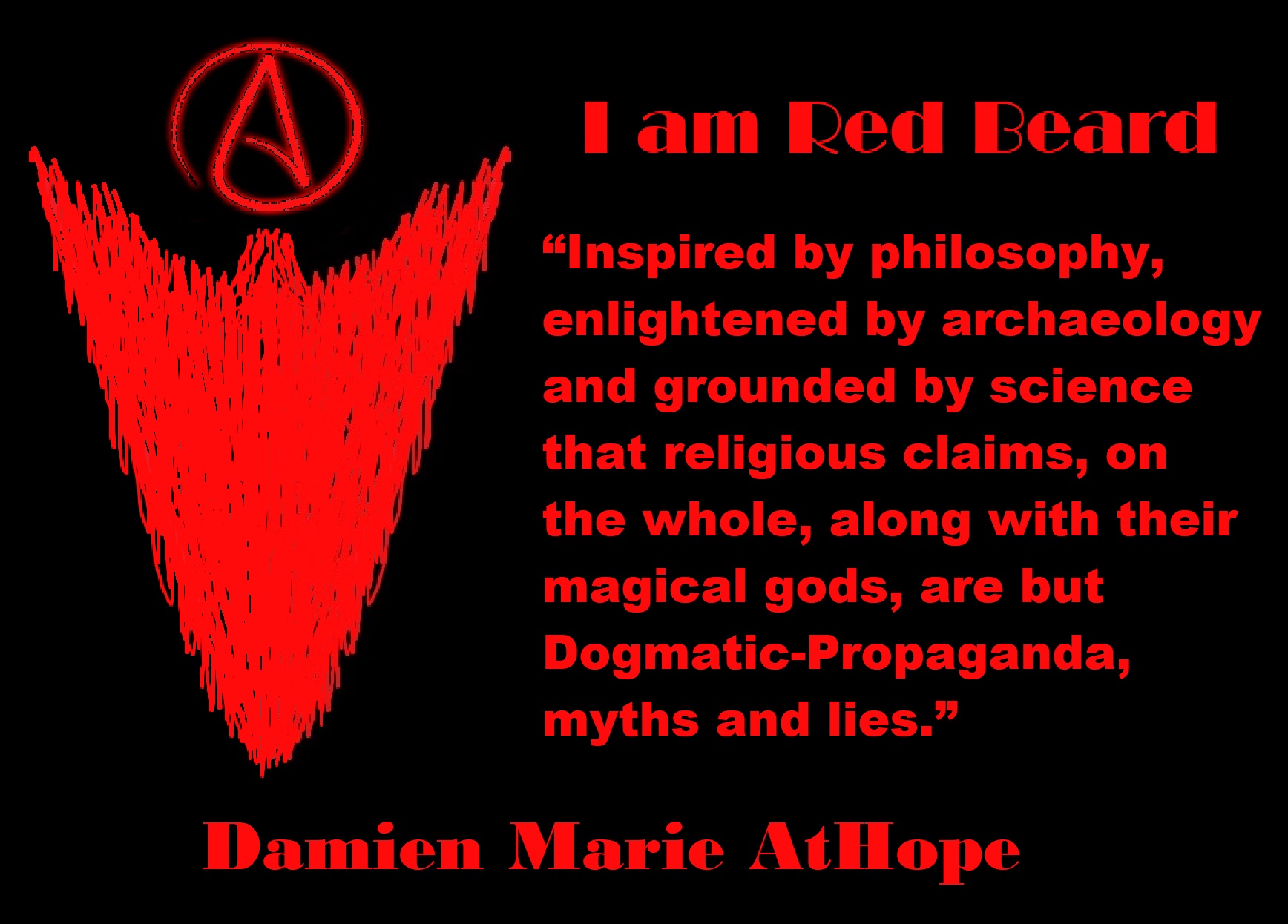
People don’t commonly teach religious history, even that of their own claimed religion. No, rather they teach a limited “pro their religion” history of their religion from a religious perspective favorable to the religion of choice.
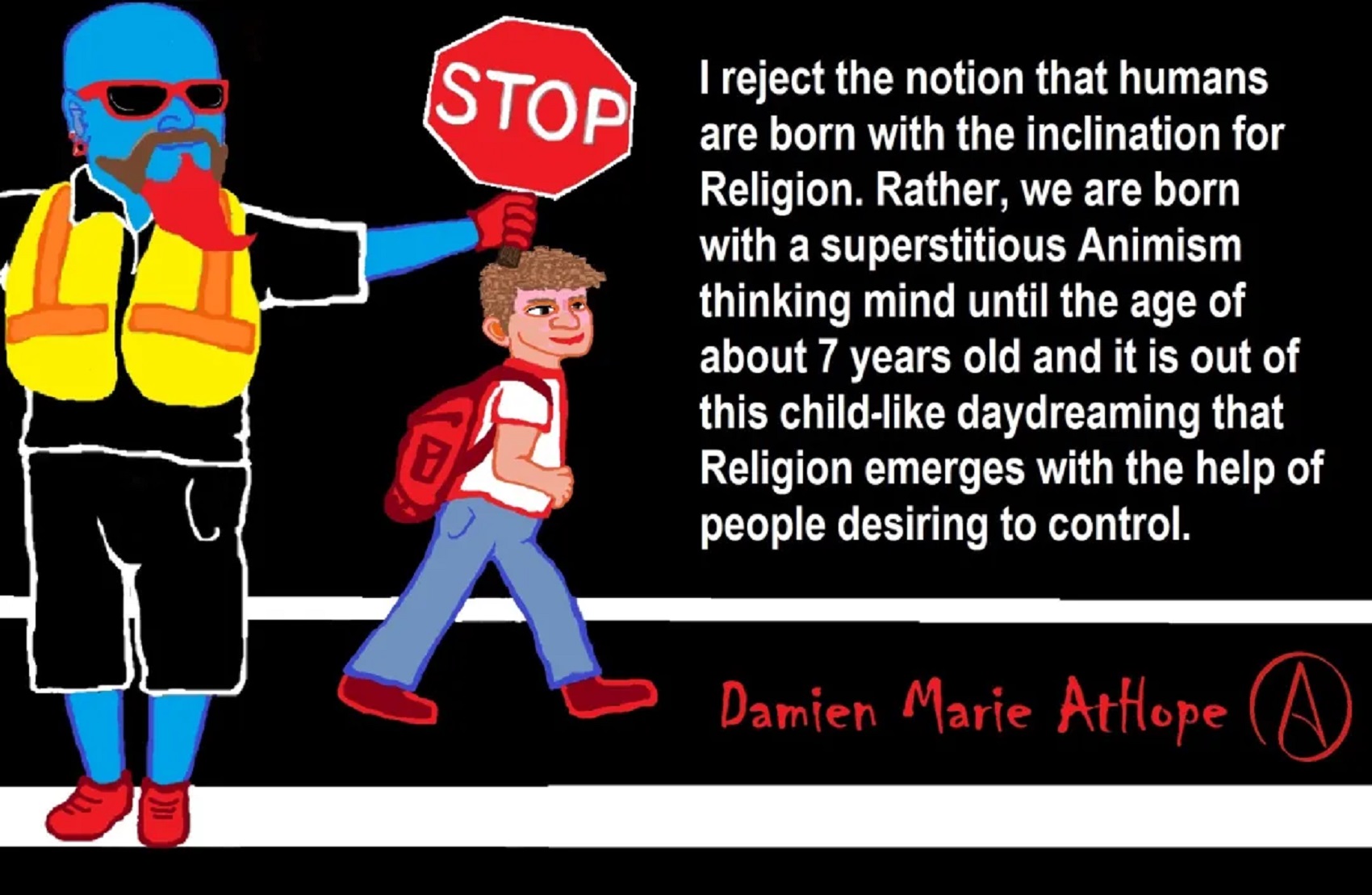
Do you truly think “Religious Belief” is only a matter of some personal choice?
Do you not see how coercive one’s world of choice is limited to the obvious hereditary belief, in most religious choices available to the child of religious parents or caregivers? Religion is more commonly like a family, culture, society, etc. available belief that limits the belief choices of the child and that is when “Religious Belief” is not only a matter of some personal choice and when it becomes hereditary faith, not because of the quality of its alleged facts or proposed truths but because everyone else important to the child believes similarly so they do as well simply mimicking authority beliefs handed to them. Because children are raised in religion rather than being presented all possible choices but rather one limited dogmatic brand of “Religious Belief” where children only have a choice of following the belief as instructed, and then personally claim the faith hereditary belief seen in the confirming to the belief they have held themselves all their lives. This is obvious in statements asked and answered by children claiming a faith they barely understand but they do understand that their family believes “this or that” faith, so they feel obligated to believe it too. While I do agree that “Religious Belief” should only be a matter of some personal choice, it rarely is… End Hereditary Religion!
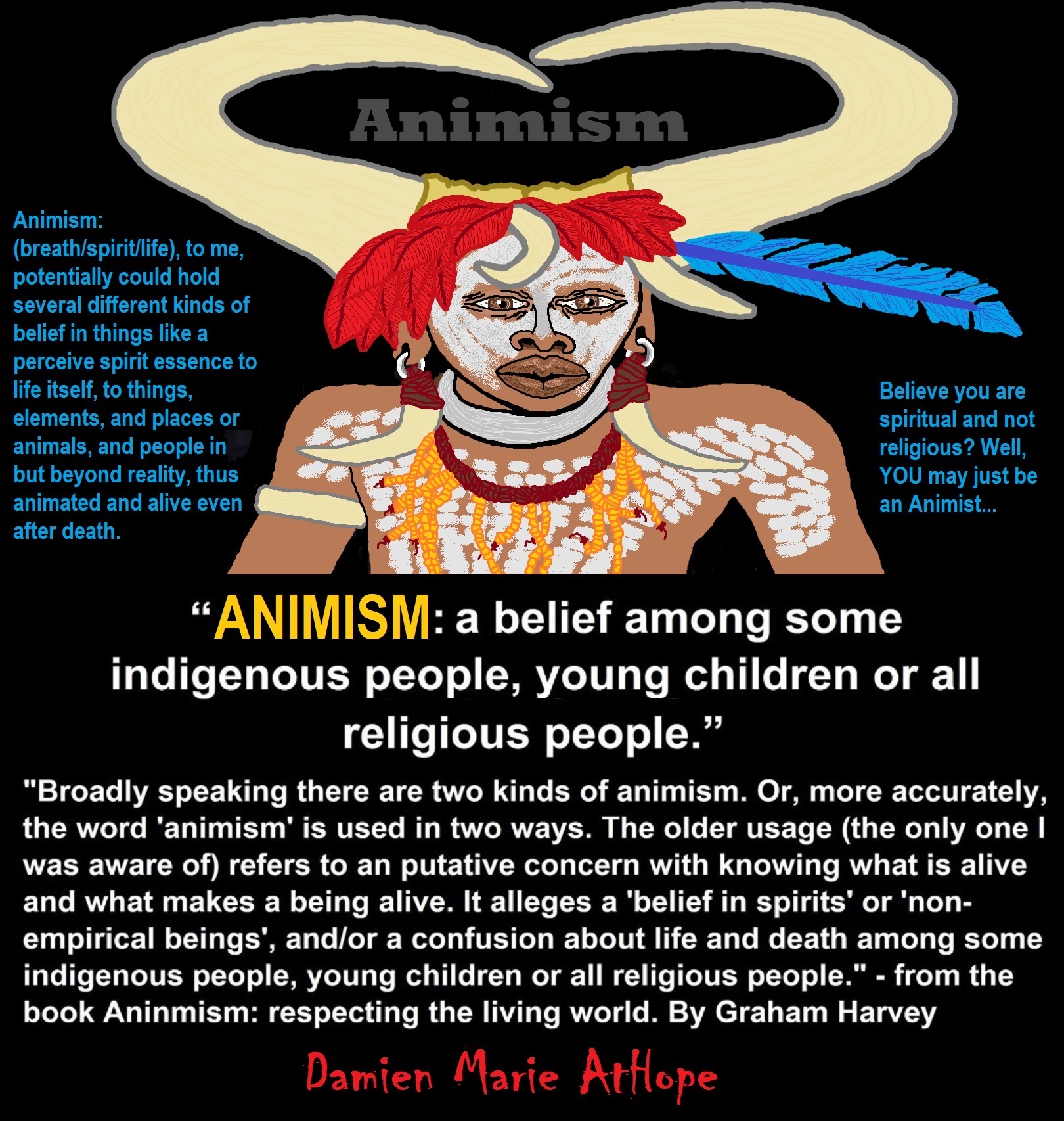
Animism: Respecting the Living World by Graham Harvey
“How have human cultures engaged with and thought about animals, plants, rocks, clouds, and other elements in their natural surroundings? Do animals and other natural objects have a spirit or soul? What is their relationship to humans? In this new study, Graham Harvey explores current and past animistic beliefs and practices of Native Americans, Maori, Aboriginal Australians, and eco-pagans. He considers the varieties of animism found in these cultures as well as their shared desire to live respectfully within larger natural communities. Drawing on his extensive casework, Harvey also considers the linguistic, performative, ecological, and activist implications of these different animisms.” ref
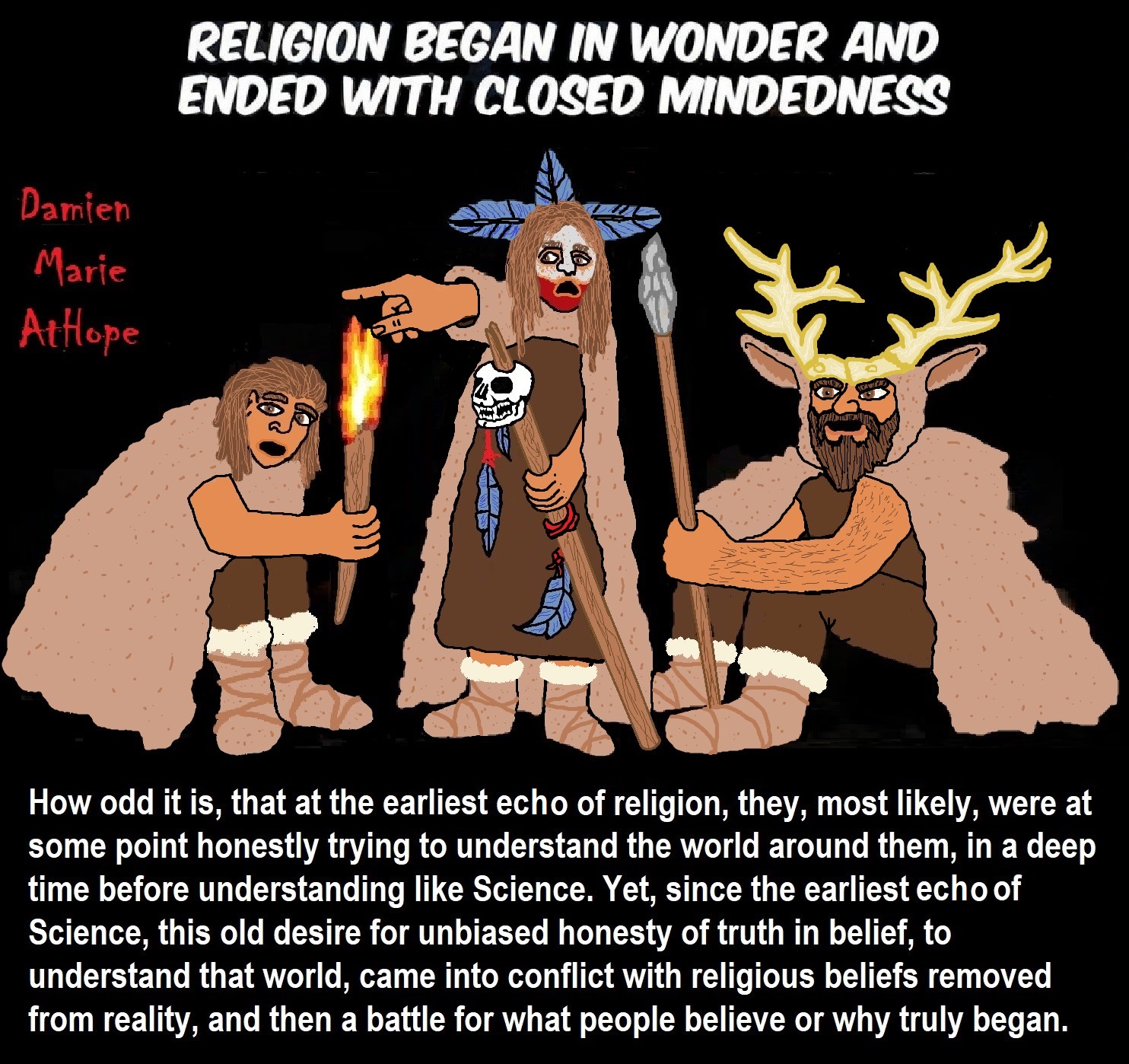
We are like believing machines we vacuum up ideas, like Velcro sticks to almost everything. We accumulate beliefs that we allow to negatively influence our lives, often without realizing it. Our willingness must be to alter skewed beliefs that impend our balance or reason, which allows us to achieve new positive thinking and accurate outcomes.
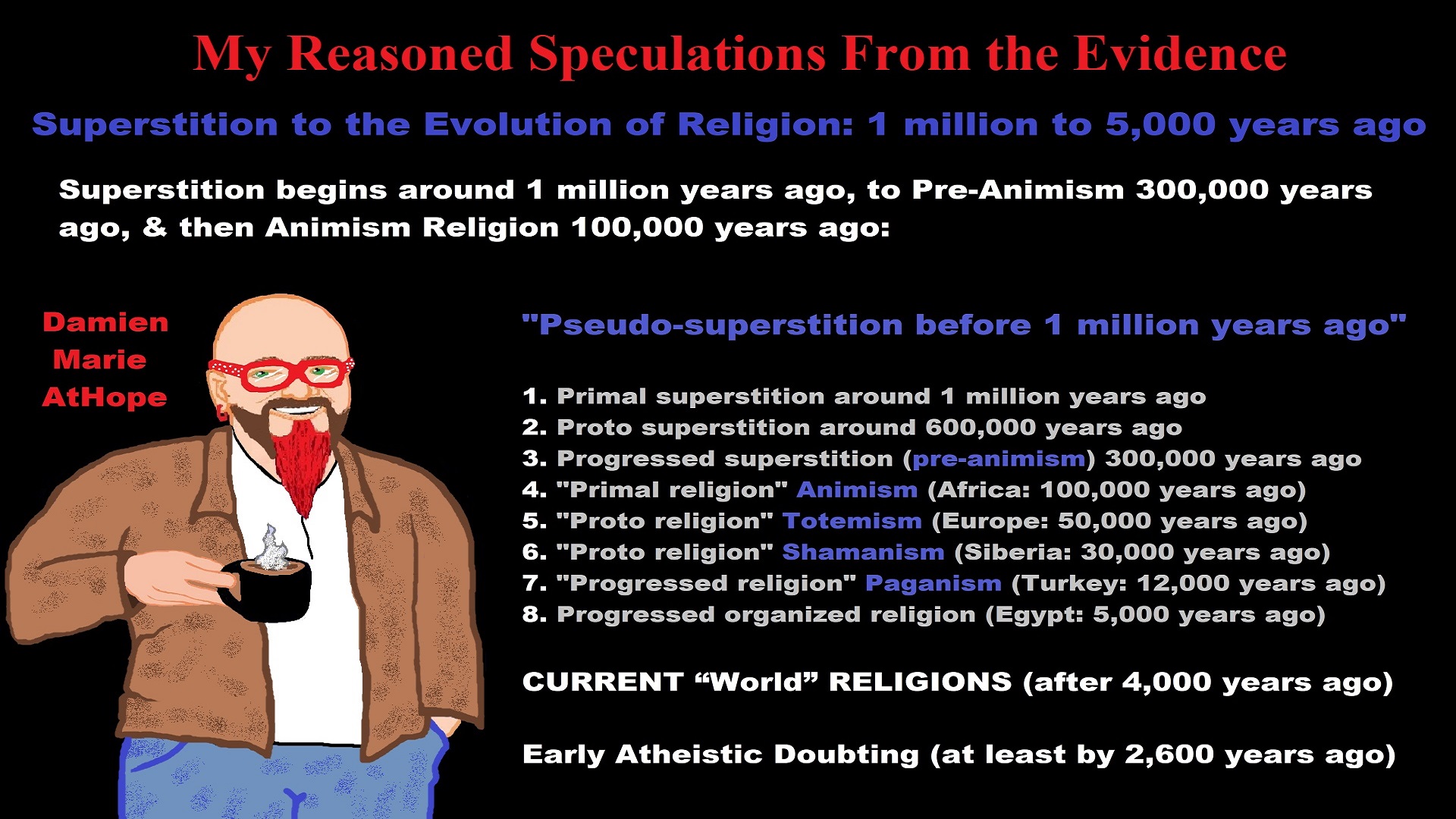
My thoughts on Religion Evolution with external links for more info:
- (Pre-Animism Africa mainly, but also Europe, and Asia at least 300,000 years ago), (Pre-Animism – Oxford Dictionaries)
- (Animism Africa around 100,000 years ago), (Animism – Britannica.com)
- (Totemism Europe around 50,000 years ago), (Totemism – Anthropology)
- (Shamanism Siberia around 30,000 years ago), (Shamanism – Britannica.com)
- (Paganism Turkey around 12,000 years ago), (Paganism – BBC Religion)
- (Progressed Organized Religion “Institutional Religion” Egypt around 5,000 years ago), (Ancient Egyptian Religion – Britannica.com)
- (CURRENT “World” RELIGIONS after 4,000 years ago) (Origin of Major Religions – Sacred Texts)
- (Early Atheistic Doubting at least by 2,600 years ago) (History of Atheism – Wikipedia)
“Religion is an Evolved Product” and Yes, Religion is Like Fear Given Wings…
Atheists talk about gods and religions for the same reason doctors talk about cancer, they are looking for a cure, or a firefighter talks about fires because they burn people and they care to stop them. We atheists too often feel a need to help the victims of mental slavery, held in the bondage that is the false beliefs of gods and the conspiracy theories of reality found in religions.
Understanding Religion Evolution:
- Pre-Animism (at least 300,000 years ago)
- Animism (Africa: 100,000 years ago)
- Totemism (Europe: 50,000 years ago)
- Shamanism (Siberia: 30,000 years ago)
- Paganism (Turkey: 12,000 years ago)
- Progressed organized religion (Egypt: 5,000 years ago), (Egypt, the First Dynasty 5,150 years ago)
- CURRENT “World” RELIGIONS (after 4,000 years ago)
- Early Atheistic Doubting (at least by 2,600 years ago)
“An Archaeological/Anthropological Understanding of Religion Evolution”
It seems ancient peoples had to survived amazing threats in a “dangerous universe (by superstition perceived as good and evil),” and human “immorality or imperfection of the soul” which was thought to affect the still living, leading to ancestor worship. This ancestor worship presumably led to the belief in supernatural beings, and then some of these were turned into the belief in gods. This feeble myth called gods were just a human conceived “made from nothing into something over and over, changing, again and again, taking on more as they evolve, all the while they are thought to be special,” but it is just supernatural animistic spirit-belief perceived as sacred.
Quick Evolution of Religion?
Pre-Animism (at least 300,000 years ago) pre-religion is a beginning that evolves into later Animism. So, Religion as we think of it, to me, all starts in a general way with Animism (Africa: 100,000 years ago) (theoretical belief in supernatural powers/spirits), then this is physically expressed in or with Totemism (Europe: 50,000 years ago) (theoretical belief in mythical relationship with powers/spirits through a totem item), which then enlists a full-time specific person to do this worship and believed interacting Shamanism (Siberia/Russia: 30,000 years ago) (theoretical belief in access and influence with spirits through ritual), and then there is the further employment of myths and gods added to all the above giving you Paganism (Turkey: 12,000 years ago) (often a lot more nature-based than most current top world religions, thus hinting to their close link to more ancient religious thinking it stems from). My hypothesis is expressed with an explanation of the building of a theatrical house (modern religions development). Progressed organized religion (Egypt: 5,000 years ago) with CURRENT “World” RELIGIONS (after 4,000 years ago).
Historically, in large city-state societies (such as Egypt or Iraq) starting around 5,000 years ago culminated to make religion something kind of new, a sociocultural-governmental-religious monarchy, where all or at least many of the people of such large city-state societies seem familiar with and committed to the existence of “religion” as the integrated life identity package of control dynamics with a fixed closed magical doctrine, but this juggernaut integrated religion identity package of Dogmatic-Propaganda certainly did not exist or if developed to an extent it was highly limited in most smaller prehistoric societies as they seem to lack most of the strong control dynamics with a fixed closed magical doctrine (magical beliefs could be at times be added or removed). Many people just want to see developed religious dynamics everywhere even if it is not. Instead, all that is found is largely fragments until the domestication of religion.
Religions, as we think of them today, are a new fad, even if they go back to around 6,000 years in the timeline of human existence, this amounts to almost nothing when seen in the long slow evolution of religion at least around 70,000 years ago with one of the oldest ritual worship. Stone Snake of South Africa: “first human worship” 70,000 years ago. This message of how religion and gods among them are clearly a man-made thing that was developed slowly as it was invented and then implemented peace by peace discrediting them all. Which seems to be a simple point some are just not grasping how devastating to any claims of truth when we can see the lie clearly in the archeological sites.
I wish people fought as hard for the actual values as they fight for the group/clan names political or otherwise they think support values. Every amount spent on war is theft to children in need of food or the homeless kept from shelter.
Here are several of my blog posts on history:
- To Find Truth You Must First Look
- (Magdalenian/Iberomaurusian) Connections to the First Paganists of the early Neolithic Near East Dating from around 17,000 to 12,000 Years Ago
- Natufians: an Ancient People at the Origins of Agriculture and Sedentary Life
- Possible Clan Leader/Special “MALE” Ancestor Totem Poles At Least 13,500 years ago?
- Jewish People with DNA at least 13,200 years old, Judaism, and the Origins of Some of its Ideas
- Baltic Reindeer Hunters: Swiderian, Lyngby, Ahrensburgian, and Krasnosillya cultures 12,020 to 11,020 years ago are evidence of powerful migratory waves during the last 13,000 years and a genetic link to Saami and the Finno-Ugric peoples.
- The Rise of Inequality: patriarchy and state hierarchy inequality
- Fertile Crescent 12,500 – 9,500 Years Ago: fertility and death cult belief system?
- 12,400 – 11,700 Years Ago – Kortik Tepe (Turkey) Pre/early-Agriculture Cultic Ritualism
- Ritualistic Bird Symbolism at Gobekli Tepe and its “Ancestor Cult”
- Male-Homosexual (female-like) / Trans-woman (female) Seated Figurine from Gobekli Tepe
- Could a 12,000-year-old Bull Geoglyph at Göbekli Tepe relate to older Bull and Female Art 25,000 years ago and Later Goddess and the Bull cults like Catal Huyuk?
- Sedentism and the Creation of goddesses around 12,000 years ago as well as male gods after 7,000 years ago.
- Alcohol, where Agriculture and Religion Become one? Such as Gobekli Tepe’s Ritualistic use of Grain as Food and Ritual Drink
- Neolithic Ritual Sites with T-Pillars and other Cultic Pillars
- Paganism: Goddesses around 12,000 years ago then Male Gods after 7,000 years ago
- First Patriarchy: Split of Women’s Status around 12,000 years ago & First Hierarchy: fall of Women’s Status around 5,000 years ago.
- Natufians: an Ancient People at the Origins of Agriculture and Sedentary Life
- J DNA and the Spread of Agricultural Religion (paganism)
- Paganism: an approximately 12,000-year-old belief system
- Paganism 12,000 years old: related to “Anarchism and Socialism” (Pre-Capitalism)
- Shaman burial in Israel 12,000 years ago and the Shamanism Phenomena
- Need to Mythicized: gods and goddesses
- 12,000 – 7,000 Years Ago – Paleo-Indian Culture (The Americas)
- 12,000 – 2,000 Years Ago – Indigenous-Scandinavians (Nordic)
- Norse did not wear helmets with horns?
- Pre-Pottery Neolithic Skull Cult around 11,500 to 8,400 Years Ago?
- 10,400 – 10,100 Years Ago, in Turkey the Nevail Cori Religious Settlement
- 9,000-6,500 Years Old Submerged Pre-Pottery/Pottery Neolithic Ritual Settlements off Israel’s Coast
- Catal Huyuk “first religious designed city” around 9,500 to 7,700 years ago (Turkey)
- Cultic Hunting at Catal Huyuk “first religious designed city”
- Special Items and Art as well as Special Elite Burials at Catal Huyuk
- New Rituals and Violence with the appearance of Pottery and People?
- Haplogroup N and its related Uralic Languages and Cultures
- Ainu people, Sámi people, Native Americans, the Ancient North Eurasians, and Paganistic-Shamanism with Totemism
- Ideas, Technology and People from Turkey, Europe, to China and Back again 9,000 to 5,000 years ago?
- First Pottery of Europe and the Related Cultures
- 9,000 years old Neolithic Artifacts Judean Desert and Hills Israel
- 9,000-7,000 years-old Sex and Death Rituals: Cult Sites in Israel, Jordan, and the Sinai
- 9,000-8500 year old Horned Female shaman Bad Dürrenberg Germany
- Neolithic Jewelry and the Spread of Farming in Europe Emerging out of West Turkey
- 8,600-year-old Tortoise Shells in Neolithic graves in central China have Early Writing and Shamanism
- Swing of the Mace: the rise of Elite, Forced Authority, and Inequality begin to Emerge 8,500 years ago?
- Migrations and Changing Europeans Beginning around 8,000 Years Ago
- My “Steppe-Anatolian-Kurgan hypothesis” 8,000/7,000 years ago
- Around 8,000-year-old Shared Idea of the Mistress of Animals, “Ritual” Motif
- Pre-Columbian Red-Paint (red ochre) Maritime Archaic Culture 8,000-3,000 years ago
- 7,522-6,522 years ago Linear Pottery culture which I think relates to Arcane Capitalism’s origins
- Arcane Capitalism: Primitive socialism, Primitive capital, Private ownership, Means of production, Market capitalism, Class discrimination, and Petite bourgeoisie (smaller capitalists)
- 7,500-4,750 years old Ritualistic Cucuteni-Trypillian culture of Moldova, Romania, and Ukraine
- Roots of a changing early society 7,200-6,700 years ago Jordan and Israel
- Agriculture religion (Paganism) with farming reached Britain between about 7,000 to 6,500 or so years ago and seemingly expressed in things like Western Europe’s Long Barrows
- My Thoughts on Possible Migrations of “R” DNA and Proto-Indo-European?
- “Millet” Spreading from China 7,022 years ago to Europe and related Language may have Spread with it leading to Proto-Indo-European
- Proto-Indo-European (PIE), ancestor of Indo-European languages: DNA, Society, Language, and Mythology
- The Dnieper–Donets culture and Asian varieties of Millet from China to the Black Sea region of Europe by 7,022 years ago
- Kurgan 6,000 years ago/dolmens 7,000 years ago: funeral, ritual, and other?
- 7,020 to 6,020-year-old Proto-Indo-European Homeland of Urheimat or proposed home of their Language and Religion
- Ancient Megaliths: Kurgan, Ziggurat, Pyramid, Menhir, Trilithon, Dolman, Kromlech, and Kromlech of Trilithons
- The Mytheme of Ancient North Eurasian Sacred-Dog belief and similar motifs are found in Indo-European, Native American, and Siberian comparative mythology
- Elite Power Accumulation: Ancient Trade, Tokens, Writing, Wealth, Merchants, and Priest-Kings
- Sacred Mounds, Mountains, Kurgans, and Pyramids may hold deep connections?
- Between 7,000-5,000 Years ago, rise of unequal hierarchy elite, leading to a “birth of the State” or worship of power, strong new sexism, oppression of non-elites, and the fall of Women’s equal status
- Paganism 7,000-5,000 years old: related to “Anarchism and Socialism” (Capitalism) (World War 0) Elite & their slaves
- Hell and Underworld mythologies starting maybe as far back as 7,000 to 5,000 years ago with the Proto-Indo-Europeans?
- The First Expression of the Male God around 7,000 years ago?
- White (light complexion skin) Bigotry and Sexism started 7,000 years ago?
- Around 7,000-year-old Shared Idea of the Divine Bird (Tutelary and/or Trickster spirit/deity), “Ritual” Motif
- Nekhbet an Ancient Egyptian Vulture Goddess and Tutelary Deity
- 6,720 to 4,920 years old Ritualistic Hongshan Culture of Inner Mongolia with 5,000-year-old Pyramid Mounds and Temples
- First proto-king in the Balkans, Varna culture around 6,500 years ago?
- 6,500–5,800 years ago in Israel Late Chalcolithic (Copper Age) Period in the Southern Levant Seems to Express Northern Levant Migrations, Cultural and Religious Transfer
- KING OF BEASTS: Master of Animals “Ritual” Motif, around 6,000 years old or older…
- Around 6000-year-old Shared Idea of the Solid Wheel & the Spoked Wheel-Shaped Ritual Motif
- “The Ghassulian Star,” a mysterious 6,000-year-old mural from Jordan; a Proto-Star of Ishtar, Star of Inanna or Star of Venus?
- Religious/Ritual Ideas, including goddesses and gods as well as ritual mounds or pyramids from Northeastern Asia at least 6,000 years old, seemingly filtering to Iran, Iraq, the Mediterranean, Europe, Egypt, and the Americas?
- Maykop (5,720–5,020 years ago) Caucasus region Bronze Age culture-related to Copper Age farmers from the south, influenced by the Ubaid period and Leyla-Tepe culture, as well as influencing the Kura-Araxes culture
- 5-600-year-old Tomb, Mummy, and First Bearded Male Figurine in a Grave
- Kura-Araxes Cultural 5,520 to 4,470 years old DNA traces to the Canaanites, Arabs, and Jews
- Minoan/Cretan (Keftiu) Civilization and Religion around 5,520 to 3,120 years ago
- Evolution Of Science at least by 5,500 years ago
- 5,500 Years old birth of the State, the rise of Hierarchy, and the fall of Women’s status
- “Jiroft culture” 5,100 – 4,200 years ago and the History of Iran
- Stonehenge: Paganistic Burial and Astrological Ritual Complex, England (5,100-3,600 years ago)
- Around 5,000-year-old Shared Idea of the “Tree of Life” Ritual Motif
- Complex rituals for elite, seen from China to Egypt, at least by 5,000 years ago
- Around 5,000 years ago: “Birth of the State” where Religion gets Military Power and Influence
- The Center of the World “Axis Mundi” and/or “Sacred Mountains” Mythology Could Relate to the Altai Mountains, Heart of the Steppe
- Progressed organized religion starts, an approximately 5,000-year-old belief system
- China’s Civilization between 5,000-3,000 years ago, was a time of war and class struggle, violent transition from free clans to a Slave or Elite society
- Origin of Logics is Naturalistic Observation at least by around 5,000 years ago.
- Paganism 5,000 years old: progressed organized religion and the state: related to “Anarchism and Socialism” (Kings and the Rise of the State)
- Ziggurats (multi-platform temples: 4,900 years old) to Pyramids (multi-platform tombs: 4,700 years old)
- Did a 4,520–4,420-year-old Volcano In Turkey Inspire the Bible God?
- Finland’s Horned Shaman and Pre-Horned-God at least 4,500 years ago?
- 4,000-year-Old Dolmens in Israel: A Connected Dolmen Religious Phenomenon?
- Creation myths: From chaos, Ex nihilo, Earth-diver, Emergence, World egg, and World parent
- Bronze Age “Ritual” connections of the Bell Beaker culture with the Corded Ware/Single Grave culture, which were related to the Yamnaya culture and Proto-Indo-European Languages/Religions
- Low Gods (Earth/ Tutelary deity), High Gods (Sky/Supreme deity), and Moralistic Gods (Deity enforcement/divine order)
- The exchange of people, ideas, and material-culture including, to me, the new god (Sky Father) and goddess (Earth Mother) religion between the Cucuteni-Trypillians and others which is then spread far and wide
- Koryaks: Indigenous People of the Russian Far East and Big Raven myths also found in Tlingit, Haida, Tsimshian, and other Indigenous People of North America
- 42 Principles Of Maat (Egyptian Goddess of the justice) around 4,400 years ago, 2000 Years Before Ten Commandments
- “Happy Easter” Well Happy Eostre/Ishter
- 4,320-3,820 years old “Shimao” (North China) site with Totemistic-Shamanistic Paganism and a Stepped Pyramid
- 4,250 to 3,400 Year old Stonehenge from Russia: Arkaim?
- 4,100-year-old beaker with medicinal & flowering plants in a grave of a woman in Scotland
- Early European Farmer ancestry, Kelif el Boroud people with the Cardial Ware culture, and the Bell Beaker culture Paganists too, spread into North Africa, then to the Canary Islands off West Africa
- Flood Accounts: Gilgamesh epic (4,100 years ago) Noah in Genesis (2,600 years ago)
- Paganism 4,000 years old: related to “Anarchism and Socialism” (First Moralistic gods, then the Origin time of Monotheism)
- When was the beginning: TIMELINE OF CURRENT RELIGIONS, which start around 4,000 years ago.
- Early Religions Thought to Express Proto-Monotheistic Systems around 4,000 years ago
- Kultepe? An archaeological site with a 4,000 years old women’s rights document.
- Single God Religions (Monotheism) = “Man-o-theism” started around 4,000 years ago with the Great Sky Spirit/God Tiān (天)?
- Confucianism’s Tiān (Shangdi god 4,000 years old): Supernaturalism, Pantheism or Theism?
- Yes, Your Male God is Ridiculous
- Mythology, a Lunar Deity is a Goddess or God of the Moon
- Sacred Land, Hills, and Mountains: Sami Mythology (Paganistic Shamanism)
- Horse Worship/Sacrifice: mythical union of Ruling Elite/Kingship and the Horse
- The Amorite/Amurru people’s God Amurru “Lord of the Steppe”, relates to the Origins of the Bible God?
- Bronze Age Exotic Trade Routes Spread Quite Far as well as Spread Religious Ideas with Them
- Sami and the Northern Indigenous Peoples Landscape, Language, and its Connection to Religion
- Prototype of Ancient Analemmatic Sundials around 3,900-3,150 years ago and a Possible Solar Connection to gods?
- Judaism is around 3,450 or 3,250 years old. (“Paleo-Hebrew” 3,000 years ago and Torah 2,500 years ago)
- The Weakening of Ancient Trade and the Strengthening of Religions around 3000 years ago?
- Are you aware that there are religions that worship women gods, explain now religion tears women down?
- Animistic, Totemistic, and Paganistic Superstition Origins of bible god and the bible’s Religion.
- Myths and Folklore: “Trickster gods and goddesses”
- Jews, Judaism, and the Origins of Some of its Ideas
- An Old Branch of Religion Still Giving Fruit: Sacred Trees
- Dating the BIBLE: naming names and telling times (written less than 3,000 years ago, provable to 2,200 years ago)
- Did a Volcano Inspire the bible god?
- Dené–Yeniseian language, Old Copper Complex, and Pre-Columbian Mound Builders?
- No “dinosaurs and humans didn’t exist together just because some think they are in the bible itself”
- Sacred Shit and Sacred Animals?
- Everyone Killed in the Bible Flood? “Nephilim” (giants)?
- Hey, Damien dude, I have a question for you regarding “the bible” Exodus.
- Archaeology Disproves the Bible
- Bible Battle, Just More, Bible Babble
- The Jericho Conquest lie?
- Canaanites and Israelites?
- Accurate Account on how did Christianity Began?
- Let’s talk about Christianity.
- So the 10 commandments isn’t anything to go by either right?
- Misinformed christian
- Debunking Jesus?
- Paulism vs Jesus
- Ok, you seem confused so let’s talk about Buddhism.
- Unacknowledged Buddhism: Gods, Savior, Demons, Rebirth, Heavens, Hells, and Terrorism
- His Foolishness The Dalai Lama
- Yin and Yang is sexist with an ORIGIN around 2,300 years ago?
- I Believe Archaeology, not Myths & Why Not, as the Religious Myths Already Violate Reason!
- Archaeological, Scientific, & Philosophic evidence shows the god myth is man-made nonsense.
- Aquatic Ape Theory/Hypothesis? As Always, Just Pseudoscience.
- Ancient Aliens Conspiracy Theorists are Pseudohistorians
- The Pseudohistoric and Pseudoscientific claims about “Bakoni Ruins” of South Africa
- Why do people think Religion is much more than supernaturalism and superstitionism?
- Religion is an Evolved Product
- Was the Value of Ancient Women Different?
- 1000 to 1100 CE, human sacrifice Cahokia Mounds a pre-Columbian Native American site
- Feminist atheists as far back as the 1800s?
- Promoting Religion as Real is Mentally Harmful to a Flourishing Humanity
- Screw All Religions and Their Toxic lies, they are all fraud
- Forget Religions’ Unfounded Myths, I Have Substantiated “Archaeology Facts.”
- Religion Dispersal throughout the World
- I Hate Religion Just as I Hate all Pseudoscience
- Exposing Scientology, Eckankar, Wicca and Other Nonsense?
- Main deity or religious belief systems
- Quit Trying to Invent Your God From the Scraps of Science.
- Archaeological, Scientific, & Philosophic evidence shows the god myth is man-made nonsense.
- Ancient Alien Conspiracy Theorists: Misunderstanding, Rhetoric, Misinformation, Fabrications, and Lies
- Misinformation, Distortion, and Pseudoscience in Talking with a Christian Creationist
- Judging the Lack of Goodness in Gods, Even the Norse God Odin
- Challenging the Belief in God-like Aliens and Gods in General
- A Challenge to Christian use of Torture Devices?
- Yes, Hinduism is a Religion
- Trump is One of the Most Reactionary Forces of Far-right Christian Extremism
- Was the Bull Head a Symbol of God? Yes!
- Primate Death Rituals
- Christian – “God and Christianity are objectively true”
- Australopithecus afarensis Death Ritual?
- You Claim Global Warming is a Hoax?
- Doubter of Science and Defamer of Atheists?
- I think that sounds like the Bible?
- History of the Antifa (“anti-fascist”) Movements
- Indianapolis Anti-Blasphemy Laws #Free Soheil Rally
- Damien, you repeat the golden rule in so many forms then you say religion is dogmatic?
- Science is a Trustable Methodology whereas Faith is not Trustable at all!
- Was I ever a believer, before I was an atheist?
- Atheists rise in reason
- Mistrust of science?
- Open to Talking About the Definition of ‘God’? But first, we address Faith.
- ‘United Monarchy’ full of splendor and power – Saul, David, and Solomon? Most likely not.
- Is there EXODUS ARCHAEOLOGY? The short answer is “no.”
- Lacking Proof of Bigfoots, Unicorns, and Gods is Just a Lack of Research?
- Religion and Politics: Faith Beliefs vs. Rational Thinking
- Hammer of Truth that lying pig RELIGION: challenged by an archaeologist
- “The Hammer of Truth” -ontology question- What do You Mean by That?
- Navigation of a bad argument: Ad Hominem vs. Attack
- Why is it Often Claimed that Gods have a Gender?
- Why are basically all monotheistic religions ones that have a male god?
- Shifting through the Claims in support of Faith
- Dear Mr. AtHope, The 20th Century is an Indictment of Secularism and a Failed Atheist Century
- An Understanding of the Worldwide Statistics and Dynamics of Terrorist Incidents and Suicide Attacks
- Intoxication and Evolution? Addressing and Assessing the “Stoned Ape” or “Drunken Monkey” Theories as Catalysts in Human Evolution
- Sacred Menstrual cloth? Inanna’s knot, Isis knot, and maybe Ma’at’s feather?
- Damien, why don’t the Hebrews accept the bible stories?
- Dealing with a Troll and Arguing Over Word Meaning
- Knowledge without Belief? Justified beliefs or disbeliefs worthy of Knowledge?
- Afrocentrism and African Religions
- Crecganford @crecganford offers history & stories of the people, places, gods, & culture
- Empiricism-Denier?
I am not an academic. I am a revolutionary that teaches in public, in places like social media, and in the streets. I am not a leader by some title given but from my commanding leadership style of simply to start teaching everywhere to everyone, all manner of positive education.
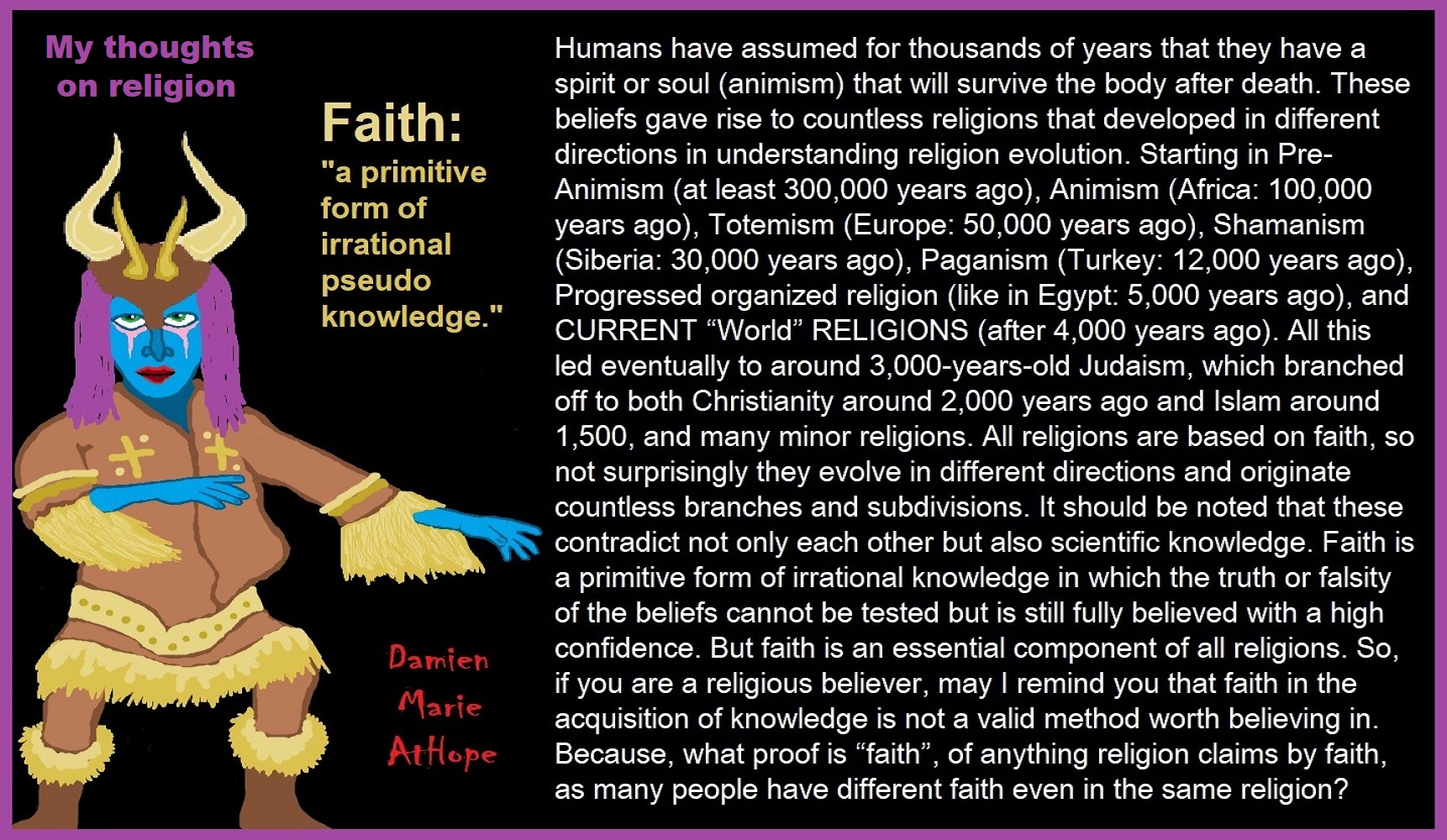
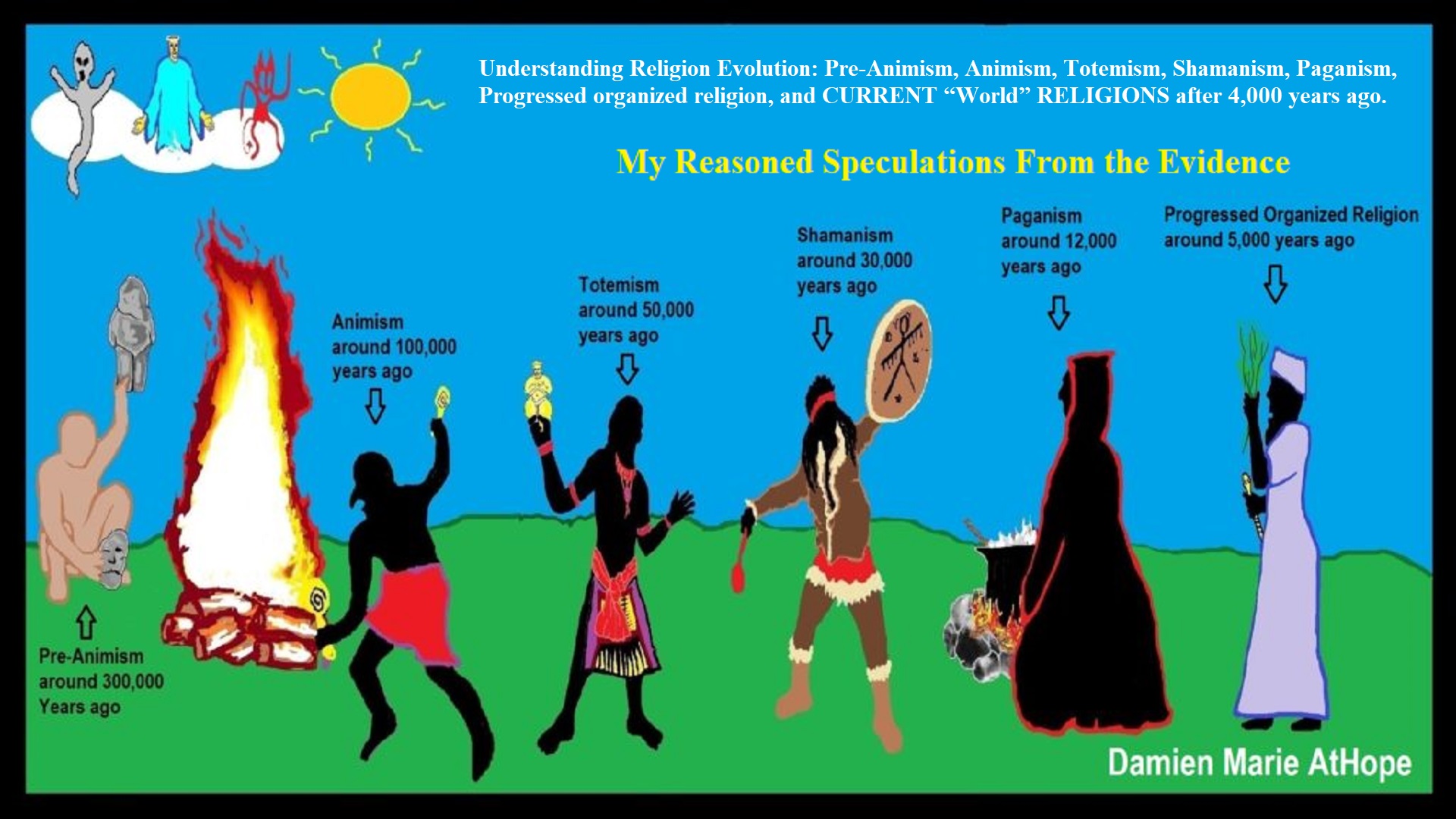
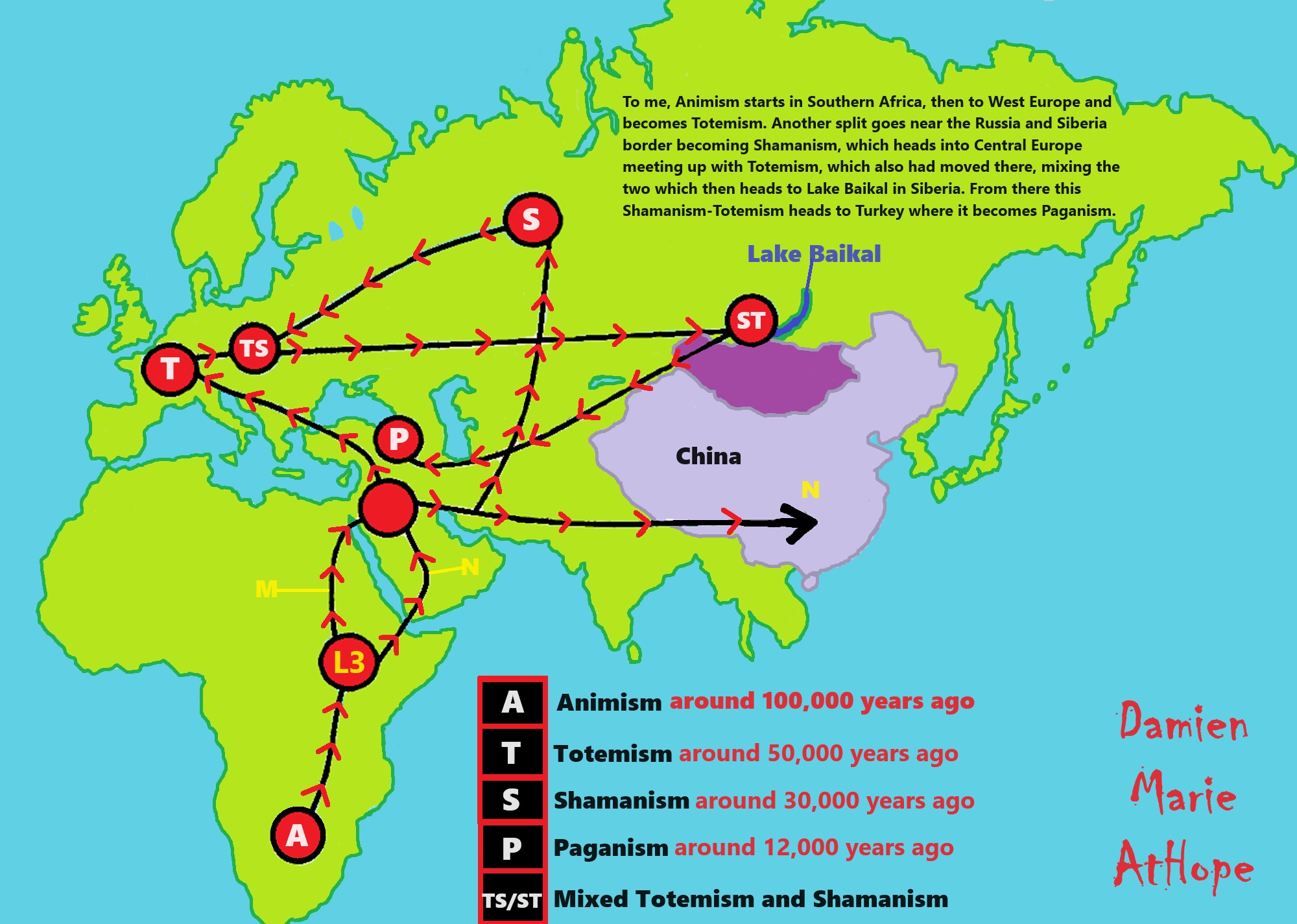
To me, Animism starts in Southern Africa, then to West Europe, and becomes Totemism. Another split goes near the Russia and Siberia border becoming Shamanism, which heads into Central Europe meeting up with Totemism, which also had moved there, mixing the two which then heads to Lake Baikal in Siberia. From there this Shamanism-Totemism heads to Turkey where it becomes Paganism.
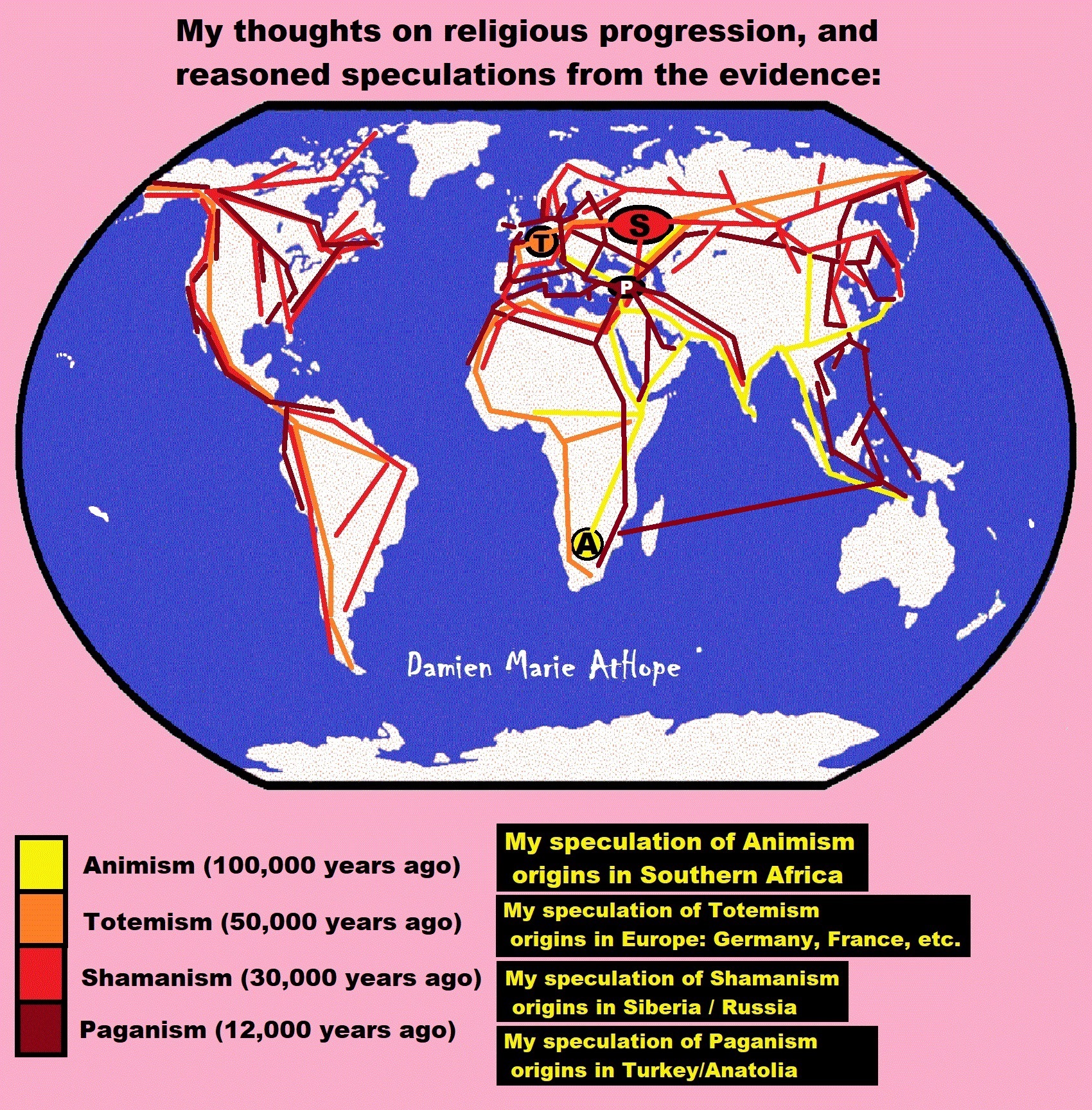
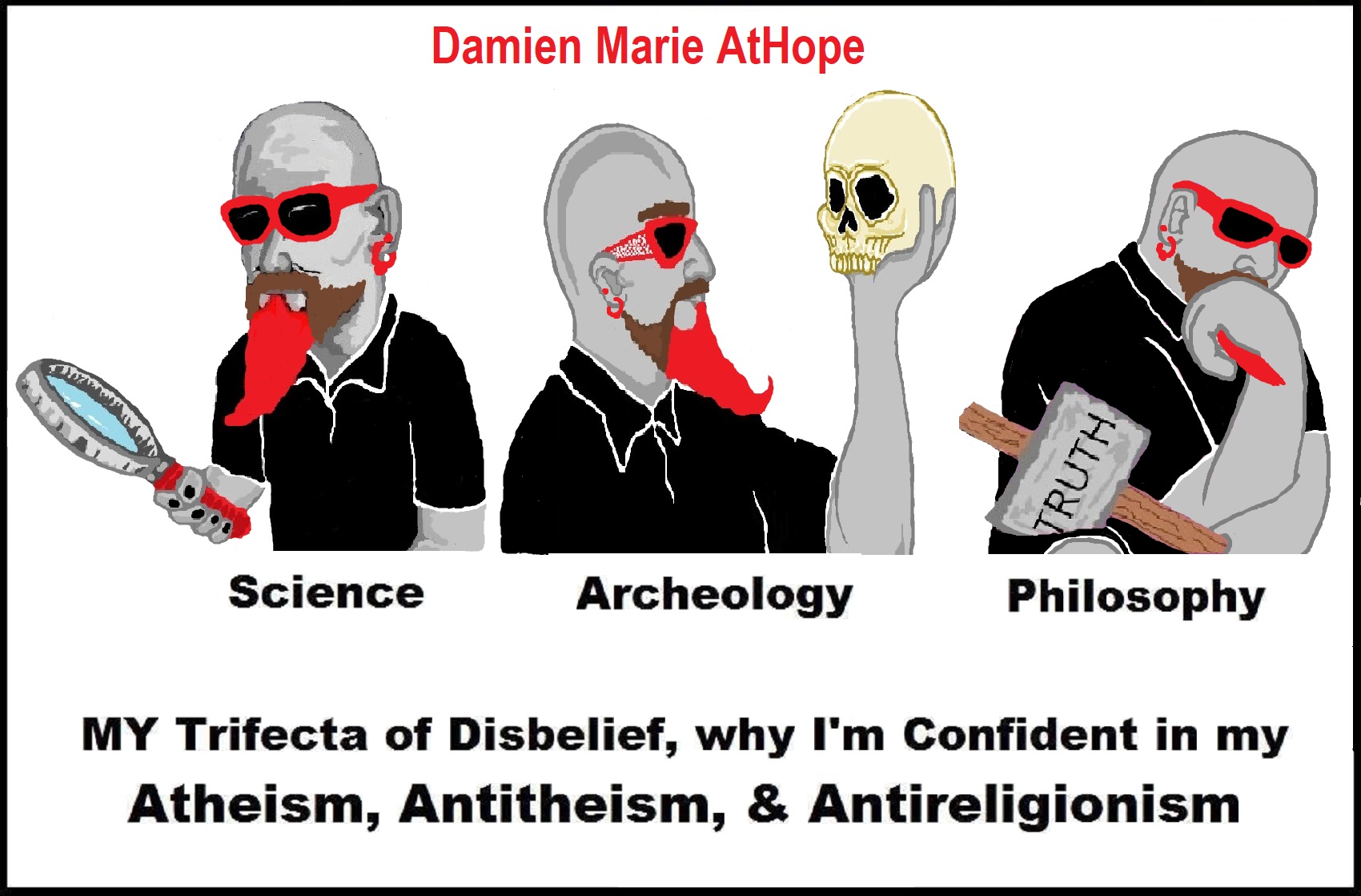
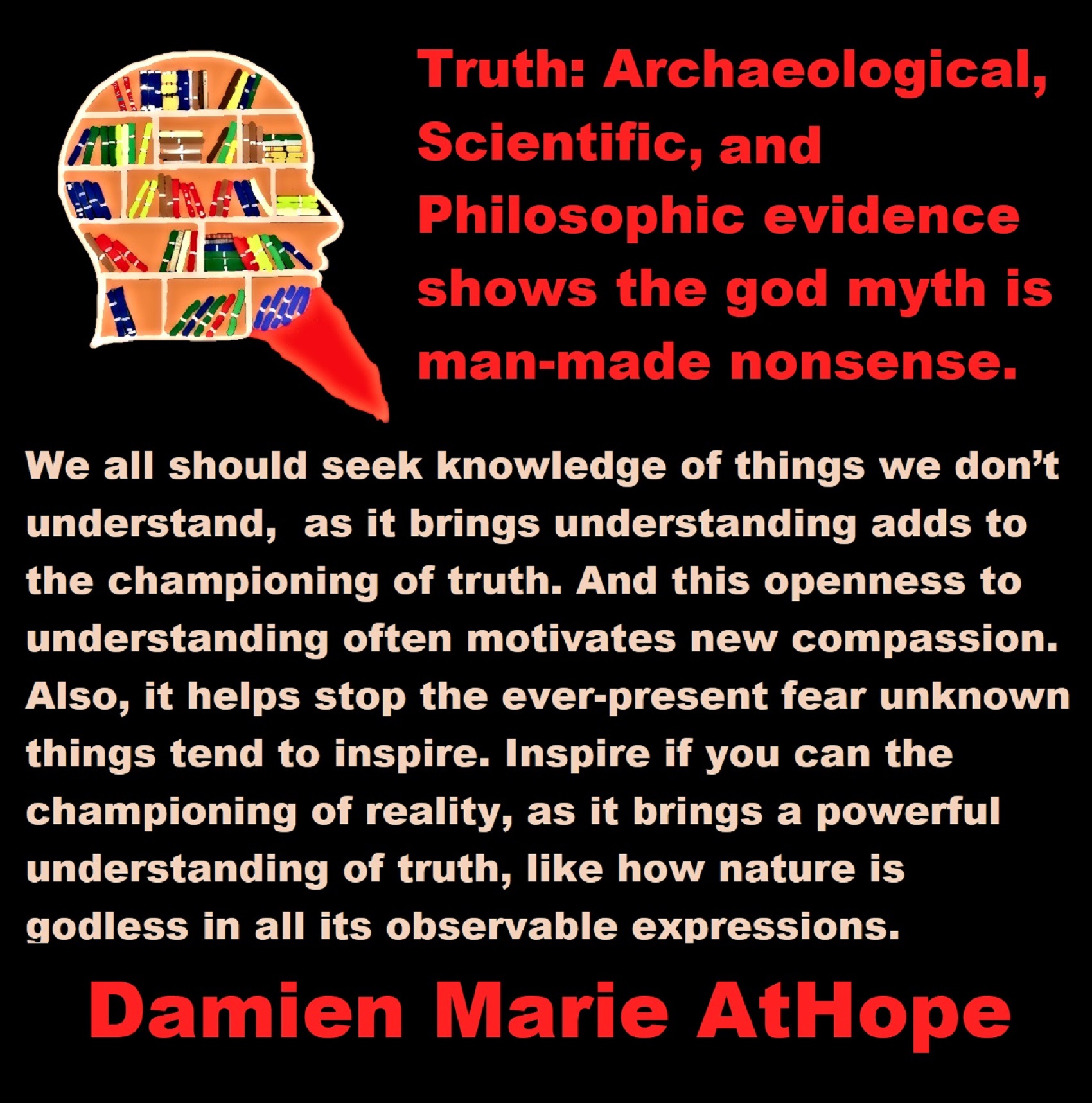
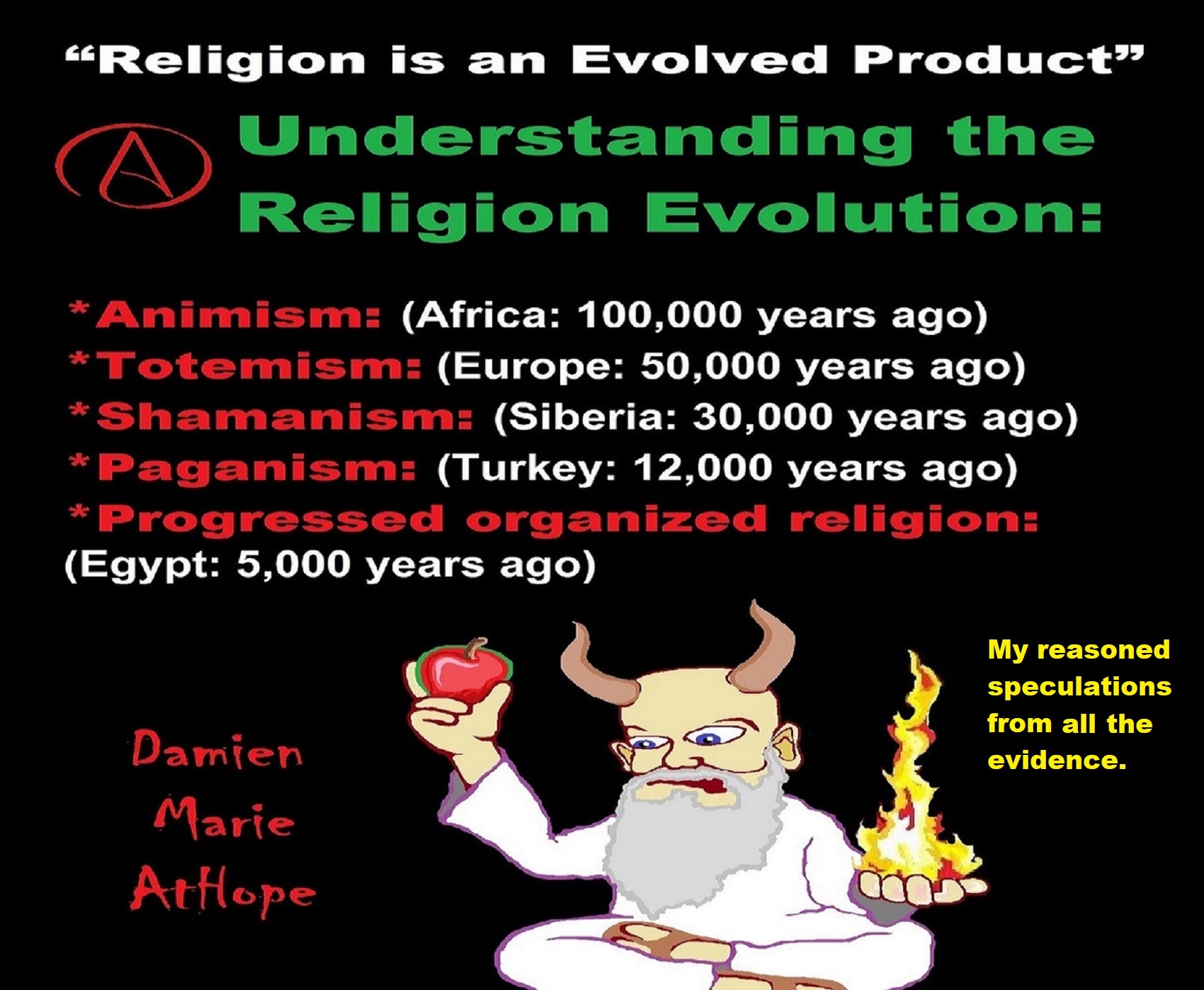
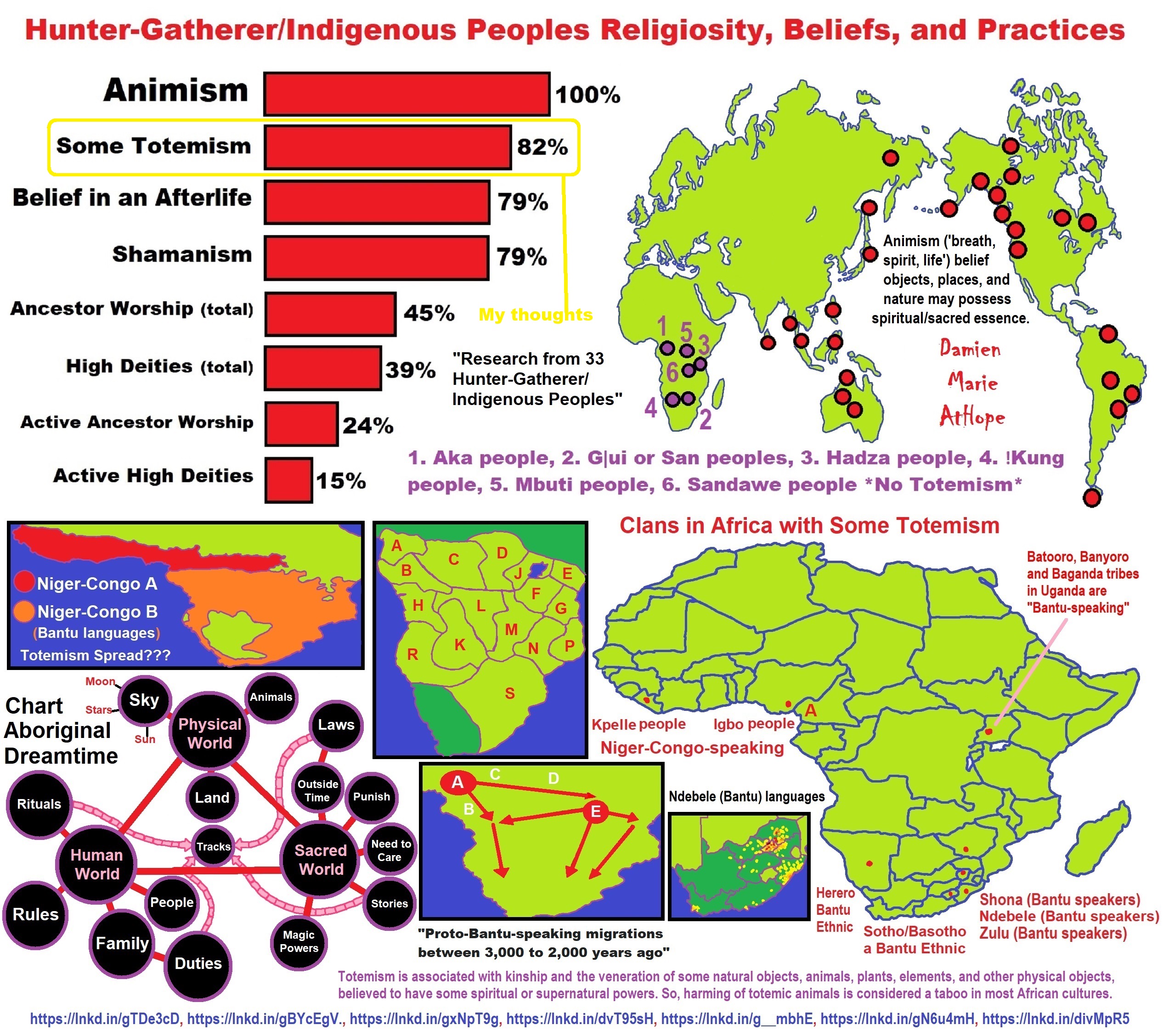
Not all “Religions” or “Religious Persuasions” have a god(s) but
All can be said to believe in some imaginary beings or imaginary things like spirits, afterlives, etc.
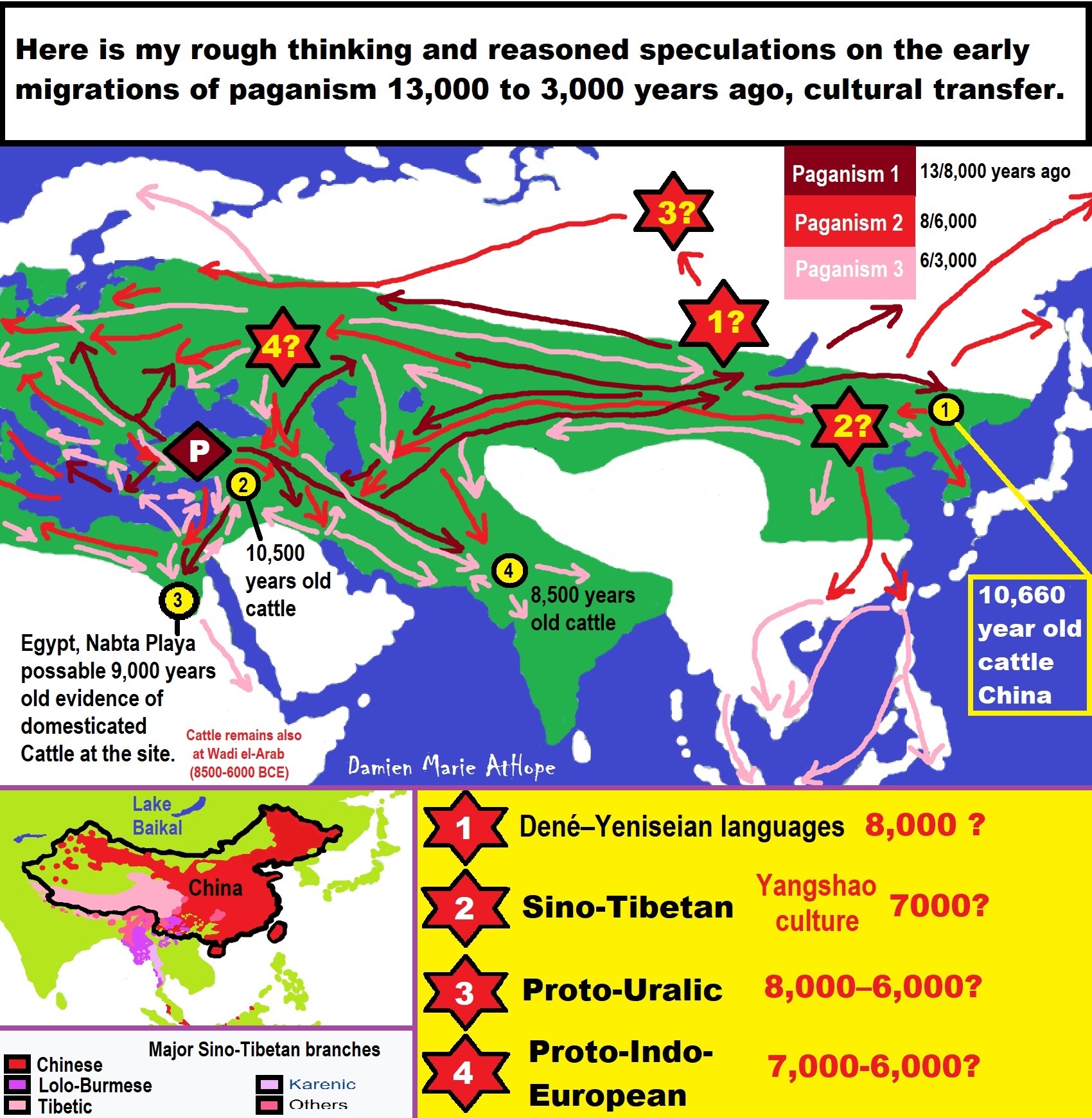
Paganism 12,000-4,000 years old
12,000-7,000 years old: related to (Pre-Capitalism)
7,000-5,000 years old: related to (Capitalism) (World War 0) Elite and their slaves!
5,000 years old: related to (Kings and the Rise of the State)
4,000 years old: related to (First Moralistic gods, then the Origin time of Monotheism)

Low Gods “Earth” or Tutelary deity and High Gods “Sky” or Supreme deity
“An Earth goddess is a deification of the Earth. Earth goddesses are often associated with the “chthonic” deities of the underworld. Ki and Ninhursag are Mesopotamian earth goddesses. In Greek mythology, the Earth is personified as Gaia, corresponding to Roman Terra, Indic Prithvi/Bhūmi, etc. traced to an “Earth Mother” complementary to the “Sky Father” in Proto-Indo-European religion. Egyptian mythology exceptionally has a sky goddess and an Earth god.” ref
“A mother goddess is a goddess who represents or is a personification of nature, motherhood, fertility, creation, destruction or who embodies the bounty of the Earth. When equated with the Earth or the natural world, such goddesses are sometimes referred to as Mother Earth or as the Earth Mother. In some religious traditions or movements, Heavenly Mother (also referred to as Mother in Heaven or Sky Mother) is the wife or feminine counterpart of the Sky father or God the Father.” ref
“Any masculine sky god is often also king of the gods, taking the position of patriarch within a pantheon. Such king gods are collectively categorized as “sky father” deities, with a polarity between sky and earth often being expressed by pairing a “sky father” god with an “earth mother” goddess (pairings of a sky mother with an earth father are less frequent). A main sky goddess is often the queen of the gods and may be an air/sky goddess in her own right, though she usually has other functions as well with “sky” not being her main. In antiquity, several sky goddesses in ancient Egypt, Mesopotamia, and the Near East were called Queen of Heaven. Neopagans often apply it with impunity to sky goddesses from other regions who were never associated with the term historically. The sky often has important religious significance. Many religions, both polytheistic and monotheistic, have deities associated with the sky.” ref
“In comparative mythology, sky father is a term for a recurring concept in polytheistic religions of a sky god who is addressed as a “father”, often the father of a pantheon and is often either a reigning or former King of the Gods. The concept of “sky father” may also be taken to include Sun gods with similar characteristics, such as Ra. The concept is complementary to an “earth mother“. “Sky Father” is a direct translation of the Vedic Dyaus Pita, etymologically descended from the same Proto-Indo-European deity name as the Greek Zeûs Pater and Roman Jupiter and Germanic Týr, Tir or Tiwaz, all of which are reflexes of the same Proto-Indo-European deity’s name, *Dyēus Ph₂tḗr. While there are numerous parallels adduced from outside of Indo-European mythology, there are exceptions (e.g. In Egyptian mythology, Nut is the sky mother and Geb is the earth father).” ref
Tutelary deity
“A tutelary (also tutelar) is a deity or spirit who is a guardian, patron, or protector of a particular place, geographic feature, person, lineage, nation, culture, or occupation. The etymology of “tutelary” expresses the concept of safety and thus of guardianship. In late Greek and Roman religion, one type of tutelary deity, the genius, functions as the personal deity or daimon of an individual from birth to death. Another form of personal tutelary spirit is the familiar spirit of European folklore.” ref
“A tutelary (also tutelar) in Korean shamanism, jangseung and sotdae were placed at the edge of villages to frighten off demons. They were also worshiped as deities. Seonangshin is the patron deity of the village in Korean tradition and was believed to embody the Seonangdang. In Philippine animism, Diwata or Lambana are deities or spirits that inhabit sacred places like mountains and mounds and serve as guardians. Such as: Maria Makiling is the deity who guards Mt. Makiling and Maria Cacao and Maria Sinukuan. In Shinto, the spirits, or kami, which give life to human bodies come from nature and return to it after death. Ancestors are therefore themselves tutelaries to be worshiped. And similarly, Native American beliefs such as Tonás, tutelary animal spirit among the Zapotec and Totems, familial or clan spirits among the Ojibwe, can be animals.” ref
“A tutelary (also tutelar) in Austronesian beliefs such as: Atua (gods and spirits of the Polynesian peoples such as the Māori or the Hawaiians), Hanitu (Bunun of Taiwan‘s term for spirit), Hyang (Kawi, Sundanese, Javanese, and Balinese Supreme Being, in ancient Java and Bali mythology and this spiritual entity, can be either divine or ancestral), Kaitiaki (New Zealand Māori term used for the concept of guardianship, for the sky, the sea, and the land), Kawas (mythology) (divided into 6 groups: gods, ancestors, souls of the living, spirits of living things, spirits of lifeless objects, and ghosts), Tiki (Māori mythology, Tiki is the first man created by either Tūmatauenga or Tāne and represents deified ancestors found in most Polynesian cultures). ” ref, ref, ref, ref, ref, ref, ref
Mesopotamian Tutelary Deities can be seen as ones related to City-States
“Historical city-states included Sumerian cities such as Uruk and Ur; Ancient Egyptian city-states, such as Thebes and Memphis; the Phoenician cities (such as Tyre and Sidon); the five Philistine city-states; the Berber city-states of the Garamantes; the city-states of ancient Greece (the poleis such as Athens, Sparta, Thebes, and Corinth); the Roman Republic (which grew from a city-state into a vast empire); the Italian city-states from the Middle Ages to the early modern period, such as Florence, Siena, Ferrara, Milan (which as they grew in power began to dominate neighboring cities) and Genoa and Venice, which became powerful thalassocracies; the Mayan and other cultures of pre-Columbian Mesoamerica (including cities such as Chichen Itza, Tikal, Copán and Monte Albán); the central Asian cities along the Silk Road; the city-states of the Swahili coast; Ragusa; states of the medieval Russian lands such as Novgorod and Pskov; and many others.” ref
“The Uruk period (ca. 4000 to 3100 BCE; also known as Protoliterate period) of Mesopotamia, named after the Sumerian city of Uruk, this period saw the emergence of urban life in Mesopotamia and the Sumerian civilization. City-States like Uruk and others had a patron tutelary City Deity along with a Priest-King.” ref
“Chinese folk religion, both past, and present, includes myriad tutelary deities. Exceptional individuals, highly cultivated sages, and prominent ancestors can be deified and honored after death. Lord Guan is the patron of military personnel and police, while Mazu is the patron of fishermen and sailors. Such as Tu Di Gong (Earth Deity) is the tutelary deity of a locality, and each individual locality has its own Earth Deity and Cheng Huang Gong (City God) is the guardian deity of an individual city, worshipped by local officials and locals since imperial times.” ref
“A tutelary (also tutelar) in Hinduism, personal tutelary deities are known as ishta-devata, while family tutelary deities are known as Kuladevata. Gramadevata are guardian deities of villages. Devas can also be seen as tutelary. Shiva is the patron of yogis and renunciants. City goddesses include: Mumbadevi (Mumbai), Sachchika (Osian); Kuladevis include: Ambika (Porwad), and Mahalakshmi. In NorthEast India Meitei mythology and religion (Sanamahism) of Manipur, there are various types of tutelary deities, among which Lam Lais are the most predominant ones. Tibetan Buddhism has Yidam as a tutelary deity. Dakini is the patron of those who seek knowledge.” ref
“A tutelary (also tutelar) The Greeks also thought deities guarded specific places: for instance, Athena was the patron goddess of the city of Athens. Socrates spoke of hearing the voice of his personal spirit or daimonion:
You have often heard me speak of an oracle or sign which comes to me … . This sign I have had ever since I was a child. The sign is a voice which comes to me and always forbids me to do something which I am going to do, but never commands me to do anything, and this is what stands in the way of my being a politician.” ref
“Tutelary deities who guard and preserve a place or a person are fundamental to ancient Roman religion. The tutelary deity of a man was his Genius, that of a woman her Juno. In the Imperial era, the Genius of the Emperor was a focus of Imperial cult. An emperor might also adopt a major deity as his personal patron or tutelary, as Augustus did Apollo. Precedents for claiming the personal protection of a deity were established in the Republican era, when for instance the Roman dictator Sulla advertised the goddess Victory as his tutelary by holding public games (ludi) in her honor.” ref
“Each town or city had one or more tutelary deities, whose protection was considered particularly vital in time of war and siege. Rome itself was protected by a goddess whose name was to be kept ritually secret on pain of death (for a supposed case, see Quintus Valerius Soranus). The Capitoline Triad of Juno, Jupiter, and Minerva were also tutelaries of Rome. The Italic towns had their own tutelary deities. Juno often had this function, as at the Latin town of Lanuvium and the Etruscan city of Veii, and was often housed in an especially grand temple on the arx (citadel) or other prominent or central location. The tutelary deity of Praeneste was Fortuna, whose oracle was renowned.” ref
“The Roman ritual of evocatio was premised on the belief that a town could be made vulnerable to military defeat if the power of its tutelary deity were diverted outside the city, perhaps by the offer of superior cult at Rome. The depiction of some goddesses such as the Magna Mater (Great Mother, or Cybele) as “tower-crowned” represents their capacity to preserve the city. A town in the provinces might adopt a deity from within the Roman religious sphere to serve as its guardian, or syncretize its own tutelary with such; for instance, a community within the civitas of the Remi in Gaul adopted Apollo as its tutelary, and at the capital of the Remi (present-day Rheims), the tutelary was Mars Camulus.” ref
Household deity (a kind of or related to a Tutelary deity)
“A household deity is a deity or spirit that protects the home, looking after the entire household or certain key members. It has been a common belief in paganism as well as in folklore across many parts of the world. Household deities fit into two types; firstly, a specific deity – typically a goddess – often referred to as a hearth goddess or domestic goddess who is associated with the home and hearth, such as the ancient Greek Hestia.” ref
“The second type of household deities are those that are not one singular deity, but a type, or species of animistic deity, who usually have lesser powers than major deities. This type was common in the religions of antiquity, such as the Lares of ancient Roman religion, the Gashin of Korean shamanism, and Cofgodas of Anglo-Saxon paganism. These survived Christianisation as fairy-like creatures existing in folklore, such as the Anglo-Scottish Brownie and Slavic Domovoy.” ref
“Household deities were usually worshipped not in temples but in the home, where they would be represented by small idols (such as the teraphim of the Bible, often translated as “household gods” in Genesis 31:19 for example), amulets, paintings, or reliefs. They could also be found on domestic objects, such as cosmetic articles in the case of Tawaret. The more prosperous houses might have a small shrine to the household god(s); the lararium served this purpose in the case of the Romans. The gods would be treated as members of the family and invited to join in meals, or be given offerings of food and drink.” ref
“In many religions, both ancient and modern, a god would preside over the home. Certain species, or types, of household deities, existed. An example of this was the Roman Lares. Many European cultures retained house spirits into the modern period. Some examples of these include:
- Brownie (Scotland and England) or Hob (England) / Kobold (Germany) / Goblin / Hobgoblin
- Domovoy (Slavic)
- Nisse (Norwegian or Danish) / Tomte (Swedish) / Tonttu (Finnish)
- Húsvættir (Norse)” ref
“Although the cosmic status of household deities was not as lofty as that of the Twelve Olympians or the Aesir, they were also jealous of their dignity and also had to be appeased with shrines and offerings, however humble. Because of their immediacy they had arguably more influence on the day-to-day affairs of men than the remote gods did. Vestiges of their worship persisted long after Christianity and other major religions extirpated nearly every trace of the major pagan pantheons. Elements of the practice can be seen even today, with Christian accretions, where statues to various saints (such as St. Francis) protect gardens and grottos. Even the gargoyles found on older churches, could be viewed as guardians partitioning a sacred space.” ref
“For centuries, Christianity fought a mop-up war against these lingering minor pagan deities, but they proved tenacious. For example, Martin Luther‘s Tischreden have numerous – quite serious – references to dealing with kobolds. Eventually, rationalism and the Industrial Revolution threatened to erase most of these minor deities, until the advent of romantic nationalism rehabilitated them and embellished them into objects of literary curiosity in the 19th century. Since the 20th century this literature has been mined for characters for role-playing games, video games, and other fantasy personae, not infrequently invested with invented traits and hierarchies somewhat different from their mythological and folkloric roots.” ref
“In contradistinction to both Herbert Spencer and Edward Burnett Tylor, who defended theories of animistic origins of ancestor worship, Émile Durkheim saw its origin in totemism. In reality, this distinction is somewhat academic, since totemism may be regarded as a particularized manifestation of animism, and something of a synthesis of the two positions was attempted by Sigmund Freud. In Freud’s Totem and Taboo, both totem and taboo are outward expressions or manifestations of the same psychological tendency, a concept which is complementary to, or which rather reconciles, the apparent conflict. Freud preferred to emphasize the psychoanalytic implications of the reification of metaphysical forces, but with particular emphasis on its familial nature. This emphasis underscores, rather than weakens, the ancestral component.” ref
“William Edward Hearn, a noted classicist, and jurist, traced the origin of domestic deities from the earliest stages as an expression of animism, a belief system thought to have existed also in the neolithic, and the forerunner of Indo-European religion. In his analysis of the Indo-European household, in Chapter II “The House Spirit”, Section 1, he states:
The belief which guided the conduct of our forefathers was … the spirit rule of dead ancestors.” ref
“In Section 2 he proceeds to elaborate:
It is thus certain that the worship of deceased ancestors is a vera causa, and not a mere hypothesis. …
In the other European nations, the Slavs, the Teutons, and the Kelts, the House Spirit appears with no less distinctness. … [T]he existence of that worship does not admit of doubt. … The House Spirits had a multitude of other names which it is needless here to enumerate, but all of which are more or less expressive of their friendly relations with man. … In [England] … [h]e is the Brownie. … In Scotland this same Brownie is well known. He is usually described as attached to particular families, with whom he has been known to reside for centuries, threshing the corn, cleaning the house, and performing similar household tasks. His favorite gratification was milk and honey.” ref
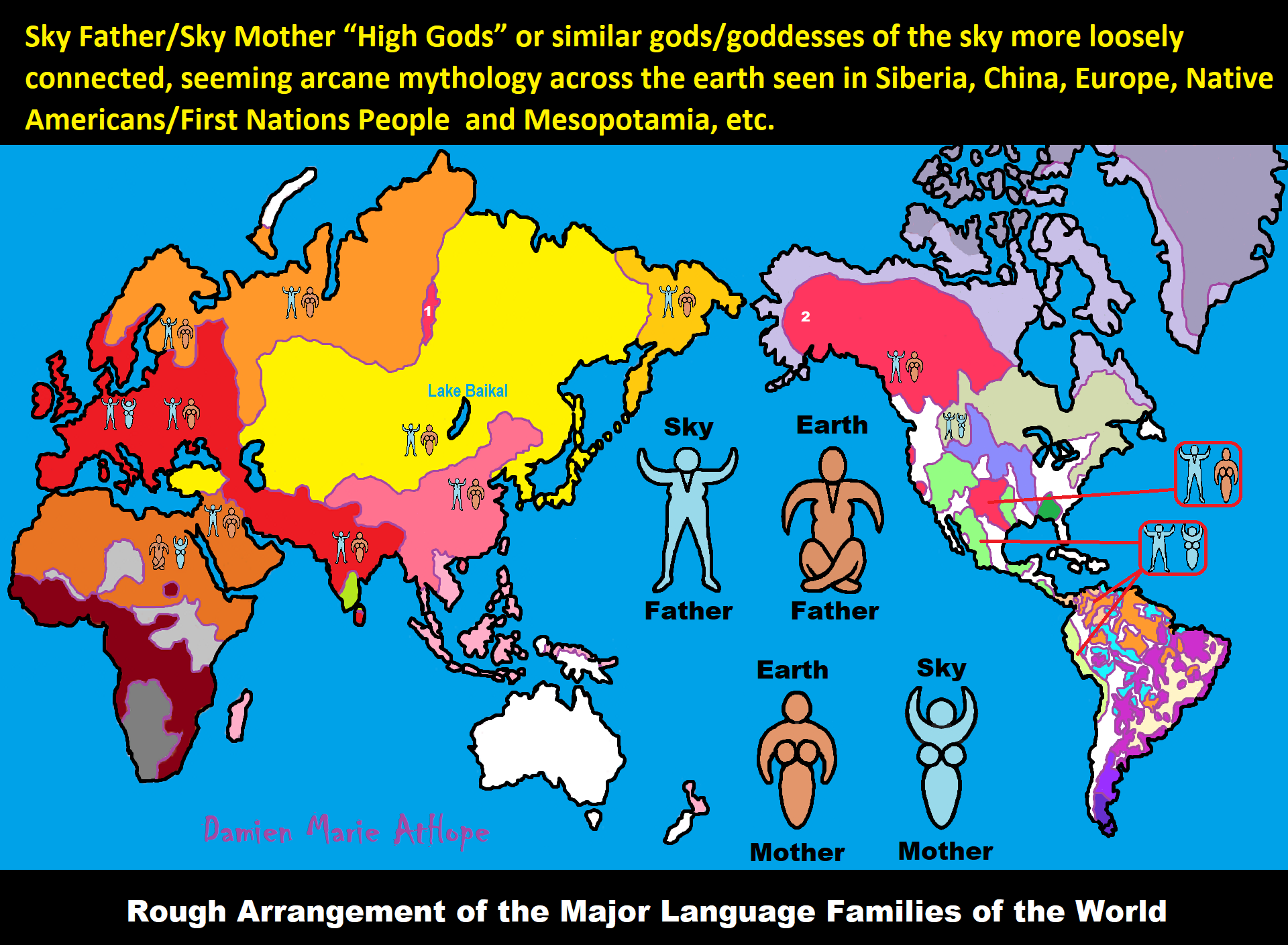
ref, ref, ref, ref, ref, ref, ref, ref, ref, ref, ref, ref, ref, ref, ref, ref, ref
“These ideas are my speculations from the evidence.”
I am still researching the “god‘s origins” all over the world. So you know, it is very complicated but I am smart and willing to look, DEEP, if necessary, which going very deep does seem to be needed here, when trying to actually understand the evolution of gods and goddesses. I am sure of a few things and less sure of others, but even in stuff I am not fully grasping I still am slowly figuring it out, to explain it to others. But as I research more I am understanding things a little better, though I am still working on understanding it all or something close and thus always figuring out more.
Sky Father/Sky God?
“Egyptian: (Nut) Sky Mother and (Geb) Earth Father” (Egypt is different but similar)
Turkic/Mongolic: (Tengri/Tenger Etseg) Sky Father and (Eje/Gazar Eej) Earth Mother *Transeurasian*
Hawaiian: (Wākea) Sky Father and (Papahānaumoku) Earth Mother *Austronesian*
New Zealand/ Māori: (Ranginui) Sky Father and (Papatūānuku) Earth Mother *Austronesian*
Proto-Indo-European: (Dyḗus/Dyḗus ph₂tḗr) Sky Father and (Dʰéǵʰōm/Pleth₂wih₁) Earth Mother
Indo-Aryan: (Dyaus Pita) Sky Father and (Prithvi Mata) Earth Mother *Indo-European*
Italic: (Jupiter) Sky Father and (Juno) Sky Mother *Indo-European*
Etruscan: (Tinia) Sky Father and (Uni) Sky Mother *Tyrsenian/Italy Pre–Indo-European*
Hellenic/Greek: (Zeus) Sky Father and (Hera) Sky Mother who started as an “Earth Goddess” *Indo-European*
Nordic: (Dagr) Sky Father and (Nótt) Sky Mother *Indo-European*
Slavic: (Perun) Sky Father and (Mokosh) Earth Mother *Indo-European*
Illyrian: (Deipaturos) Sky Father and (Messapic Damatura’s “earth-mother” maybe) Earth Mother *Indo-European*
Albanian: (Zojz) Sky Father and (?) *Indo-European*
Baltic: (Perkūnas) Sky Father and (Saulė) Sky Mother *Indo-European*
Germanic: (Týr) Sky Father and (?) *Indo-European*
Colombian-Muisca: (Bochica) Sky Father and (Huythaca) Sky Mother *Chibchan*
Aztec: (Quetzalcoatl) Sky Father and (Xochiquetzal) Sky Mother *Uto-Aztecan*
Incan: (Viracocha) Sky Father and (Mama Runtucaya) Sky Mother *Quechuan*
China: (Tian/Shangdi) Sky Father and (Dì) Earth Mother *Sino-Tibetan*
Sumerian, Assyrian and Babylonian: (An/Anu) Sky Father and (Ki) Earth Mother
Finnish: (Ukko) Sky Father and (Akka) Earth Mother *Finno-Ugric*
Sami: (Horagalles) Sky Father and (Ravdna) Earth Mother *Finno-Ugric*
Puebloan-Zuni: (Ápoyan Ta’chu) Sky Father and (Áwitelin Tsíta) Earth Mother
Puebloan-Hopi: (Tawa) Sky Father and (Kokyangwuti/Spider Woman/Grandmother) Earth Mother *Uto-Aztecan*
Puebloan-Navajo: (Tsohanoai) Sky Father and (Estsanatlehi) Earth Mother *Na-Dene*
ref, ref, ref, ref, ref, ref, ref, ref, ref, ref, ref, ref, ref, ref, ref, ref, ref, ref, ref, ref, ref, ref, ref, ref, ref, ref, ref
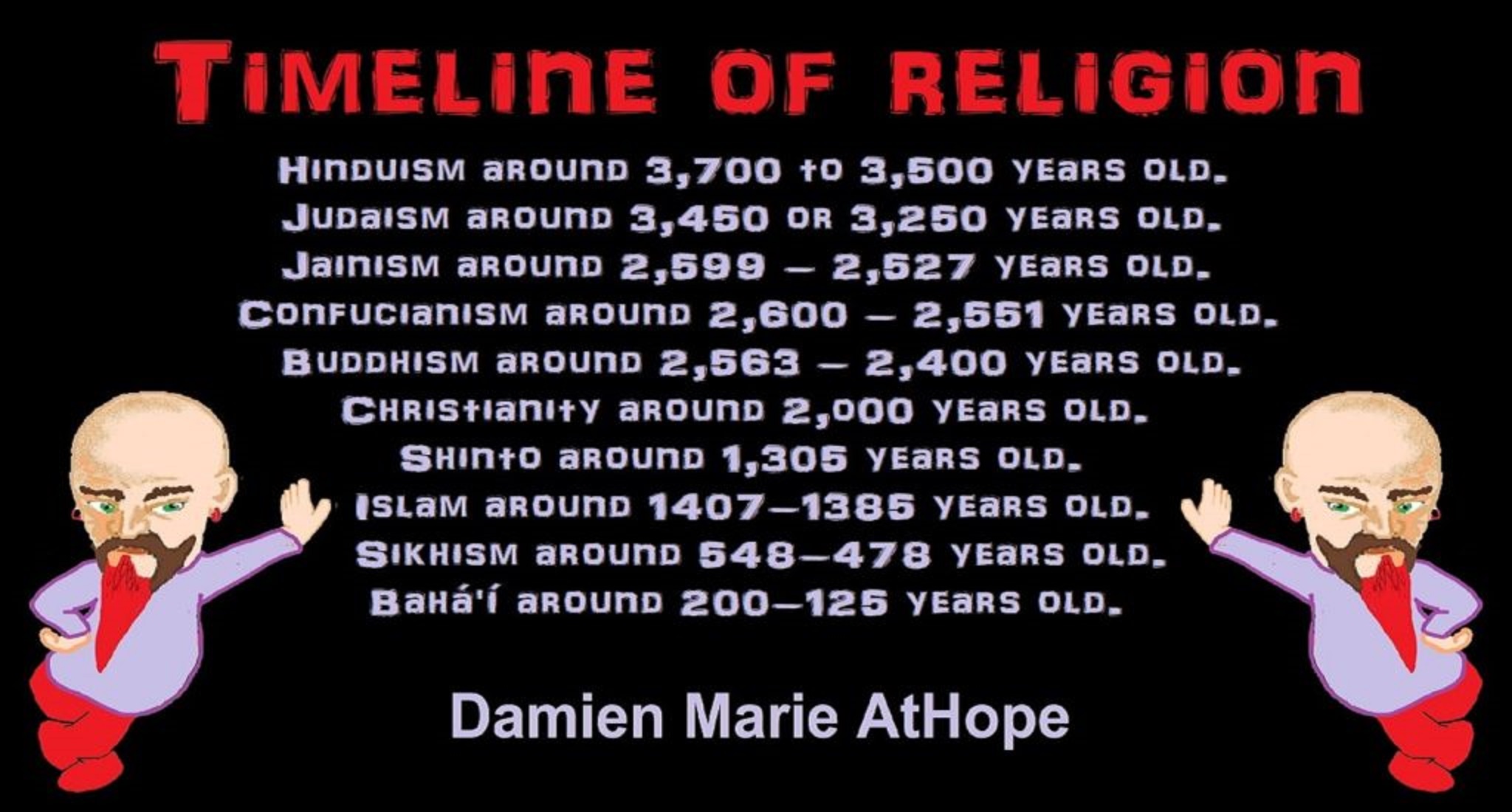
Hinduism around 3,700 to 3,500 years old. ref
Judaism around 3,450 or 3,250 years old. (The first writing in the bible was “Paleo-Hebrew” dated to around 3,000 years ago Khirbet Qeiyafa is the site of an ancient fortress city overlooking the Elah Valley. And many believe the religious Jewish texts were completed around 2,500) ref, ref
Judaism is around 3,450 or 3,250 years old. (“Paleo-Hebrew” 3,000 years ago and Torah 2,500 years ago)
“Judaism is an Abrahamic, its roots as an organized religion in the Middle East during the Bronze Age. Some scholars argue that modern Judaism evolved from Yahwism, the religion of ancient Israel and Judah, by the late 6th century BCE, and is thus considered to be one of the oldest monotheistic religions.” ref
“Yahwism is the name given by modern scholars to the religion of ancient Israel, essentially polytheistic, with a plethora of gods and goddesses. Heading the pantheon was Yahweh, the national god of the Israelite kingdoms of Israel and Judah, with his consort, the goddess Asherah; below them were second-tier gods and goddesses such as Baal, Shamash, Yarikh, Mot, and Astarte, all of whom had their own priests and prophets and numbered royalty among their devotees, and a third and fourth tier of minor divine beings, including the mal’ak, the messengers of the higher gods, who in later times became the angels of Judaism, Christianity and Islam. Yahweh, however, was not the ‘original’ god of Israel “Isra-El”; it is El, the head of the Canaanite pantheon, whose name forms the basis of the name “Israel”, and none of the Old Testament patriarchs, the tribes of Israel, the Judges, or the earliest monarchs, have a Yahwistic theophoric name (i.e., one incorporating the name of Yahweh).” ref
“El is a Northwest Semitic word meaning “god” or “deity“, or referring (as a proper name) to any one of multiple major ancient Near Eastern deities. A rarer form, ‘ila, represents the predicate form in Old Akkadian and in Amorite. The word is derived from the Proto-Semitic *ʔil-, meaning “god”. Specific deities known as ‘El or ‘Il include the supreme god of the ancient Canaanite religion and the supreme god of East Semitic speakers in Mesopotamia’s Early Dynastic Period. ʼĒl is listed at the head of many pantheons. In some Canaanite and Ugaritic sources, ʼĒl played a role as father of the gods, of creation, or both. For example, in the Ugaritic texts, ʾil mlk is understood to mean “ʼĒl the King” but ʾil hd as “the god Hadad“. The Semitic root ʾlh (Arabic ʾilāh, Aramaic ʾAlāh, ʾElāh, Hebrew ʾelōah) may be ʾl with a parasitic h, and ʾl may be an abbreviated form of ʾlh. In Ugaritic the plural form meaning “gods” is ʾilhm, equivalent to Hebrew ʾelōhîm “powers”. In the Hebrew texts this word is interpreted as being semantically singular for “god” by biblical commentators. However the documentary hypothesis for the Old Testament (corresponds to the Jewish Torah) developed originally in the 1870s, identifies these that different authors – the Jahwist, Elohist, Deuteronomist, and the Priestly source – were responsible for editing stories from a polytheistic religion into those of a monotheistic religion. Inconsistencies that arise between monotheism and polytheism in the texts are reflective of this hypothesis.” ref
Jainism around 2,599 – 2,527 years old. ref
Confucianism around 2,600 – 2,551 years old. ref
Buddhism around 2,563/2,480 – 2,483/2,400 years old. ref
Christianity around 2,o00 years old. ref
Shinto around 1,305 years old. ref
Islam around 1407–1385 years old. ref
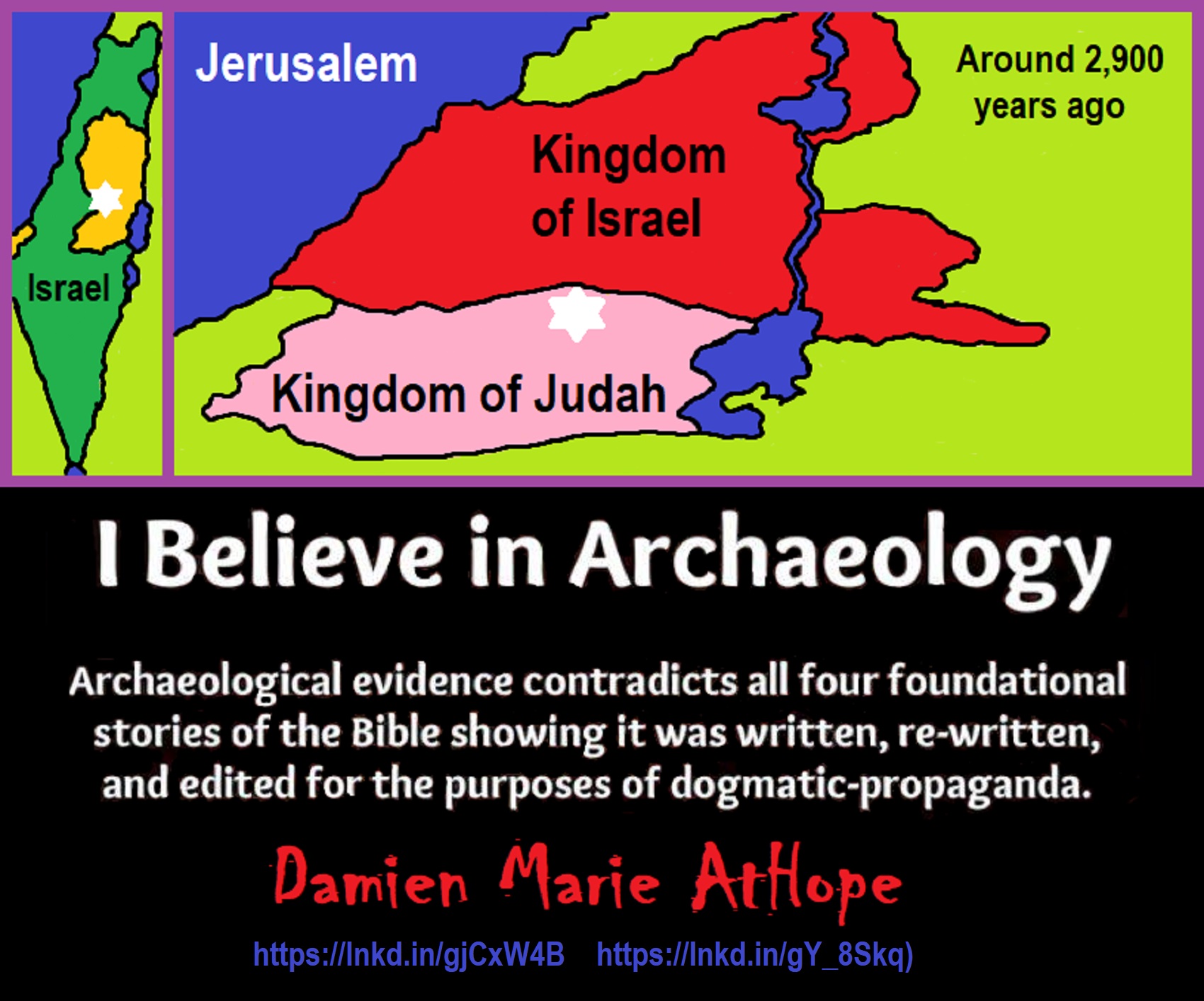
Knowledge to Ponder:
Stars/Astrology:
- Possibly, around 30,000 years ago (in simpler form) to 6,000 years ago, Stars/Astrology are connected to Ancestors, Spirit Animals, and Deities.
- The star also seems to be a possible proto-star for Star of Ishtar, Star of Inanna, or Star of Venus.
- Around 7,000 to 6,000 years ago, Star Constellations/Astrology have connections to the “Kurgan phenomenon” of below-ground “mound” stone/wood burial structures and “Dolmen phenomenon” of above-ground stone burial structures.
- Around 6,500–5,800 years ago, The Northern Levant migrations into Jordon and Israel in the Southern Levant brought new cultural and religious transfer from Turkey and Iran.
- “The Ghassulian Star,” a mysterious 6,000-year-old mural from Jordan may have connections to the European paganstic kurgan/dolmens phenomenon.
“Astrology is a range of divinatory practices, recognized as pseudoscientific since the 18th century, that claim to discern information about human affairs and terrestrial events by studying the apparent positions of celestial objects. Different cultures have employed forms of astrology since at least the 2nd millennium BCE, these practices having originated in calendrical systems used to predict seasonal shifts and to interpret celestial cycles as signs of divine communications. Most, if not all, cultures have attached importance to what they observed in the sky, and some—such as the Hindus, Chinese, and the Maya—developed elaborate systems for predicting terrestrial events from celestial observations. Western astrology, one of the oldest astrological systems still in use, can trace its roots to 19th–17th century BCE Mesopotamia, from where it spread to Ancient Greece, Rome, the Islamicate world and eventually Central and Western Europe. Contemporary Western astrology is often associated with systems of horoscopes that purport to explain aspects of a person’s personality and predict significant events in their lives based on the positions of celestial objects; the majority of professional astrologers rely on such systems.” ref
Around 5,500 years ago, Science evolves, The first evidence of science was 5,500 years ago and was demonstrated by a body of empirical, theoretical, and practical knowledge about the natural world. ref
Around 5,000 years ago, Origin of Logics is a Naturalistic Observation (principles of valid reasoning, inference, & demonstration) ref
Around 4,150 to 4,000 years ago: The earliest surviving versions of the Sumerian Epic of Gilgamesh, which was originally titled “He who Saw the Deep” (Sha naqba īmuru) or “Surpassing All Other Kings” (Shūtur eli sharrī) were written. ref
Hinduism:
- 3,700 years ago or so, the oldest of the Hindu Vedas (scriptures), the Rig Veda was composed.
- 3,500 years ago or so, the Vedic Age began in India after the collapse of the Indus Valley Civilization.
Judaism:
- around 3,000 years ago, the first writing in the bible was “Paleo-Hebrew”
- around 2,500 years ago, many believe the religious Jewish texts were completed
Myths: The bible inspired religion is not just one religion or one myth but a grouping of several religions and myths
- Around 3,450 or 3,250 years ago, according to legend, is the traditionally accepted period in which the Israelite lawgiver, Moses, provided the Ten Commandments.
- Around 2,500 to 2,400 years ago, a collection of ancient religious writings by the Israelites based primarily upon the Hebrew Bible, Tanakh, or Old Testament is the first part of Christianity’s bible.
- Around 2,400 years ago, the most accepted hypothesis is that the canon was formed in stages, first the Pentateuch (Torah).
- Around 2,140 to 2,116 years ago, the Prophets was written during the Hasmonean dynasty, and finally the remaining books.
- Christians traditionally divide the Old Testament into four sections:
- The first five books or Pentateuch (Torah).
- The proposed history books telling the history of the Israelites from their conquest of Canaan to their defeat and exile in Babylon.
- The poetic and proposed “Wisdom books” dealing, in various forms, with questions of good and evil in the world.
- The books of the biblical prophets, warning of the consequences of turning away from God:
- Henotheism:
- Exodus 20:23 “You shall not make other gods besides Me (not saying there are no other gods just not to worship them); gods of silver or gods of gold, you shall not make for yourselves.”
- Polytheism:
- Judges 10:6 “Then the sons of Israel again did evil in the sight of the LORD, served the Baals and the Ashtaroth, the gods of Aram, the gods of Sidon, the gods of Moab, the gods of the sons of Ammon, and the gods of the Philistines; thus they forsook the LORD and did not serve Him.”
- 1 Corinthians 8:5 “For even if there are so-called gods whether in heaven or on earth, as indeed there are many gods and many lords.”
- Monotheism:
- Isaiah 43:10 “You are my witnesses,” declares the LORD, “and my servant whom I have chosen, so that you may know and believe me and understand that I am he. Before me no god was formed, nor will there be one after me.
Around 2,570 to 2,270 Years Ago, there is a confirmation of atheistic doubting as well as atheistic thinking, mainly by Greek philosophers. However, doubting gods is likely as old as the invention of gods and should destroy the thinking that belief in god(s) is the “default belief”. The Greek word is apistos (a “not” and pistos “faithful,”), thus not faithful or faithless because one is unpersuaded and unconvinced by a god(s) claim. Short Definition: unbelieving, unbeliever, or unbelief.
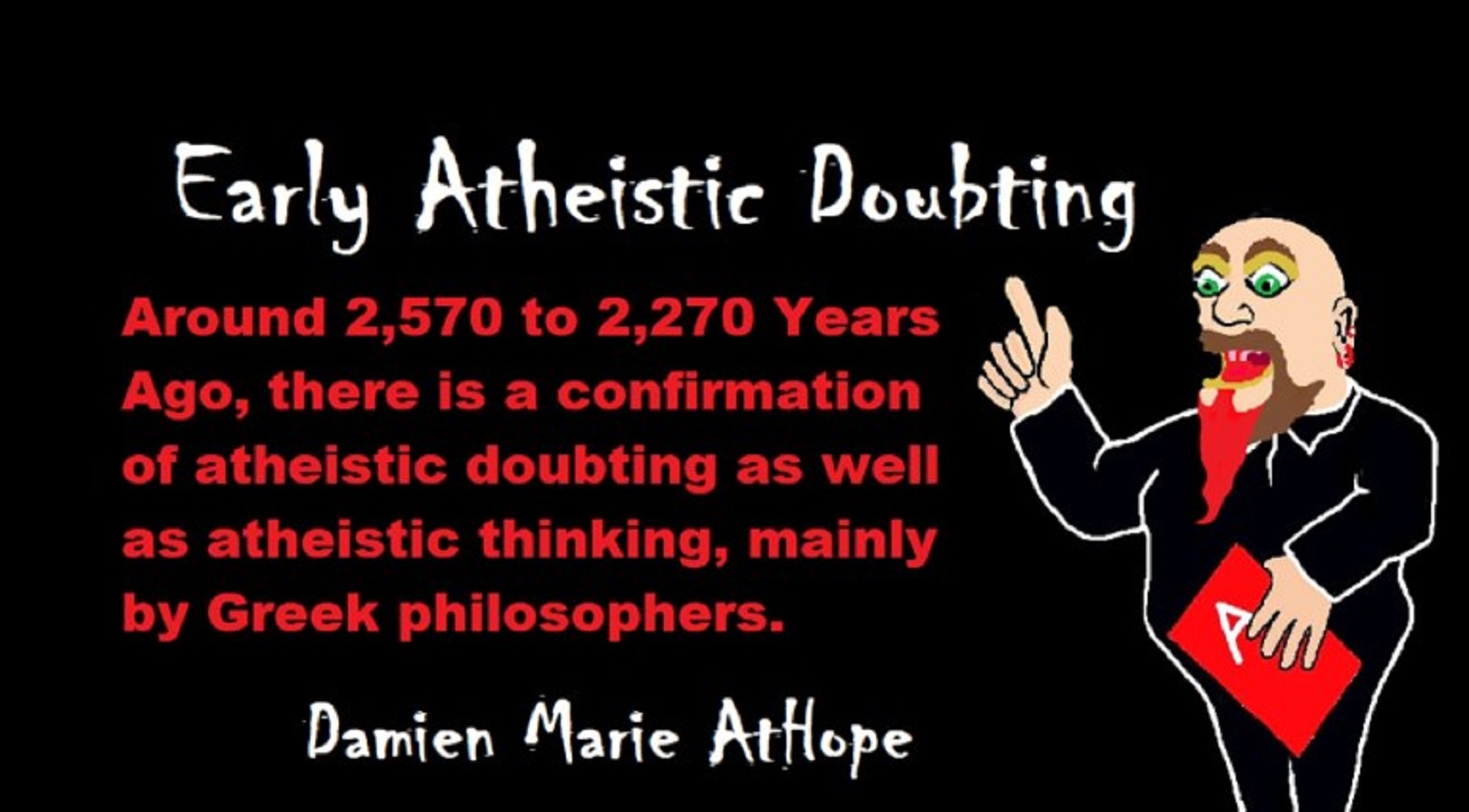
Expressions of Atheistic Thinking:
- Around 2,600 years ago, Ajita Kesakambali, ancient Indian philosopher, who is the first known proponent of Indian materialism. ref
- Around 2,535 to 2,475 years ago, Heraclitus, Greek pre-Socratic philosopher, a native of the Greek city Ephesus, Ionia, on the coast of Anatolia, also known as Asia Minor or modern Turkey. ref
- Around 2,500 to 2,400 years ago, according to The Story of Civilization book series certain African pygmy tribes have no identifiable gods, spirits, or religious beliefs or rituals, and even what burials accrue are without ceremony. ref
- Around 2,490 to 2,430 years ago, Empedocles, Greek pre-Socratic philosopher and a citizen of Agrigentum, a Greek city in Sicily. ref
- Around 2,460 to 2,370 years ago, Democritus, Greek pre-Socratic philosopher considered to be the “father of modern science” possibly had some disbelief amounting to atheism. ref
- Around 2,399 years ago or so, Socrates, a famous Greek philosopher was tried for sinfulness by teaching doubt of state gods. ref
- Around 2,341 to 2,270 years ago, Epicurus, a Greek philosopher known for composing atheistic critics and famously stated, “Is God willing to prevent evil, but not able? Then he is not omnipotent. Is he able, but not willing? Then he is malevolent. Is he both able and willing? Then whence cometh evil? Is he neither able nor willing? Then why call him god?” ref
This last expression by Epicurus, seems to be an expression of Axiological Atheism. To understand and utilize value or actually possess “Value Conscious/Consciousness” to both give a strong moral “axiological” argument (the problem of evil) as well as use it to fortify humanism and positive ethical persuasion of human helping and care responsibilities. Because value-blindness gives rise to sociopathic/psychopathic evil.
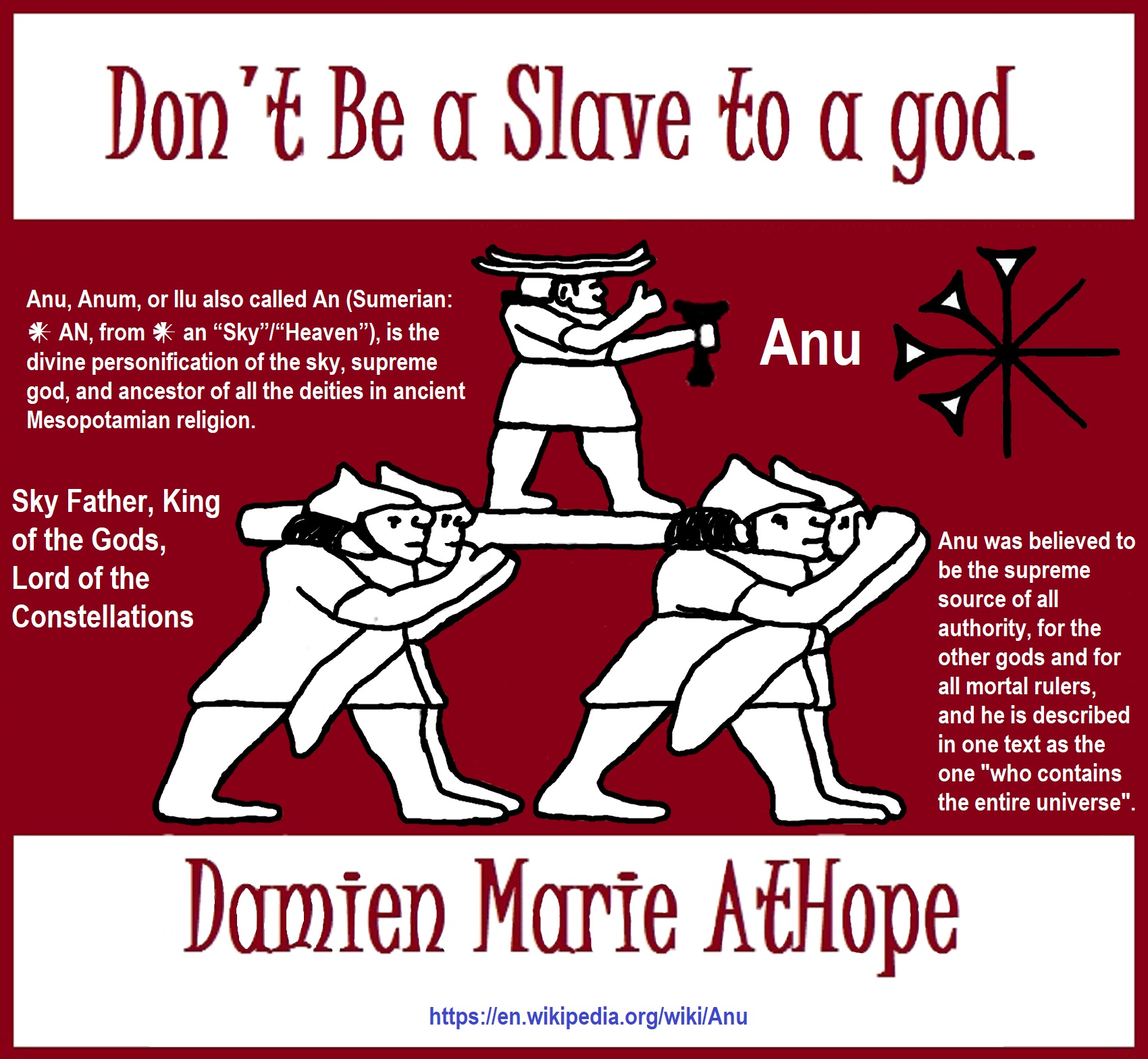
“Theists, there has to be a god, as something can not come from nothing.”
Well, thus something (unknown) happened and then there was something. This does not tell us what the something that may have been involved with something coming from nothing. A supposed first cause, thus something (unknown) happened and then there was something is not an open invitation to claim it as known, neither is it justified to call or label such an unknown as anything, especially an unsubstantiated magical thinking belief born of mythology and religious storytelling.
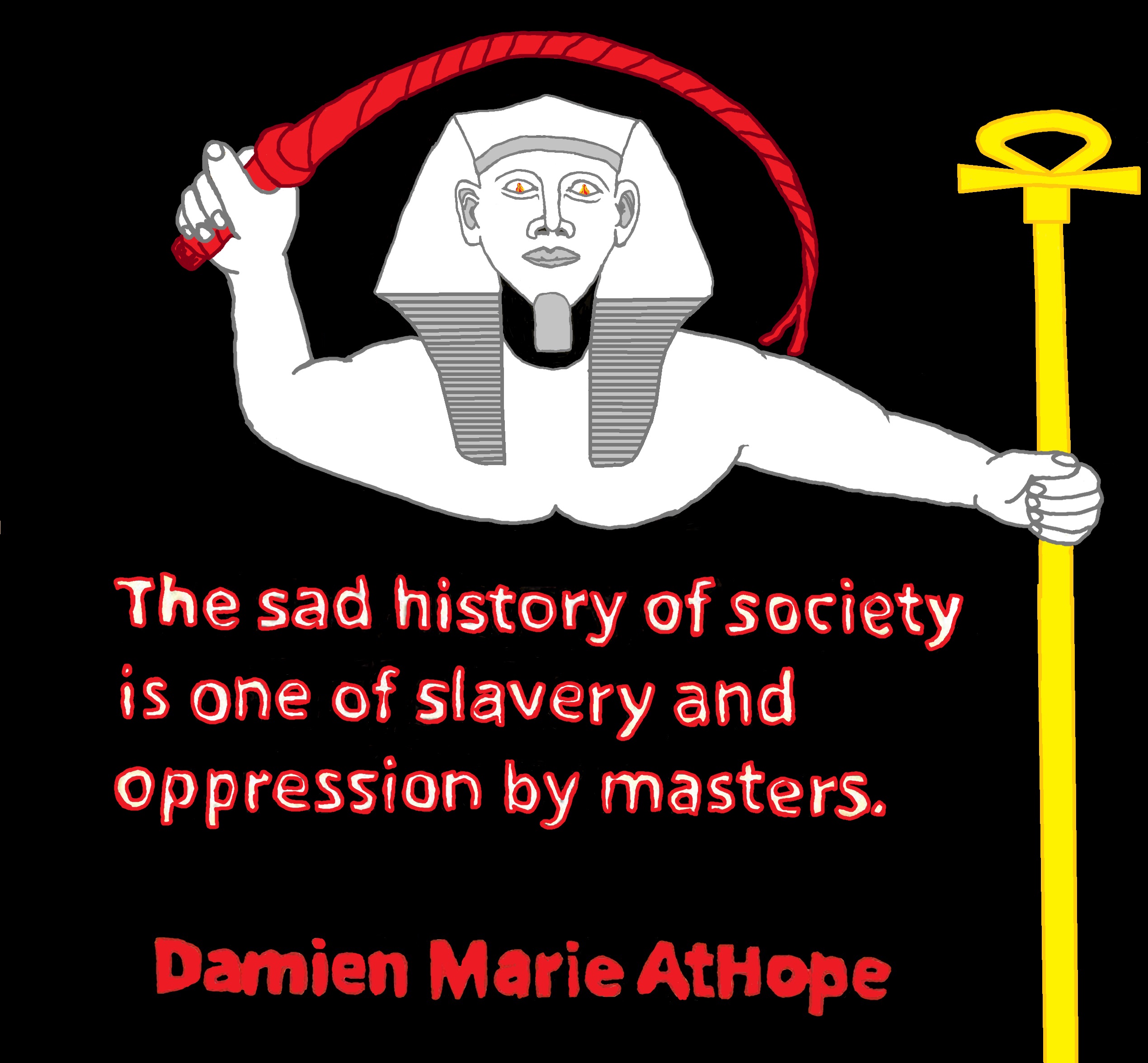
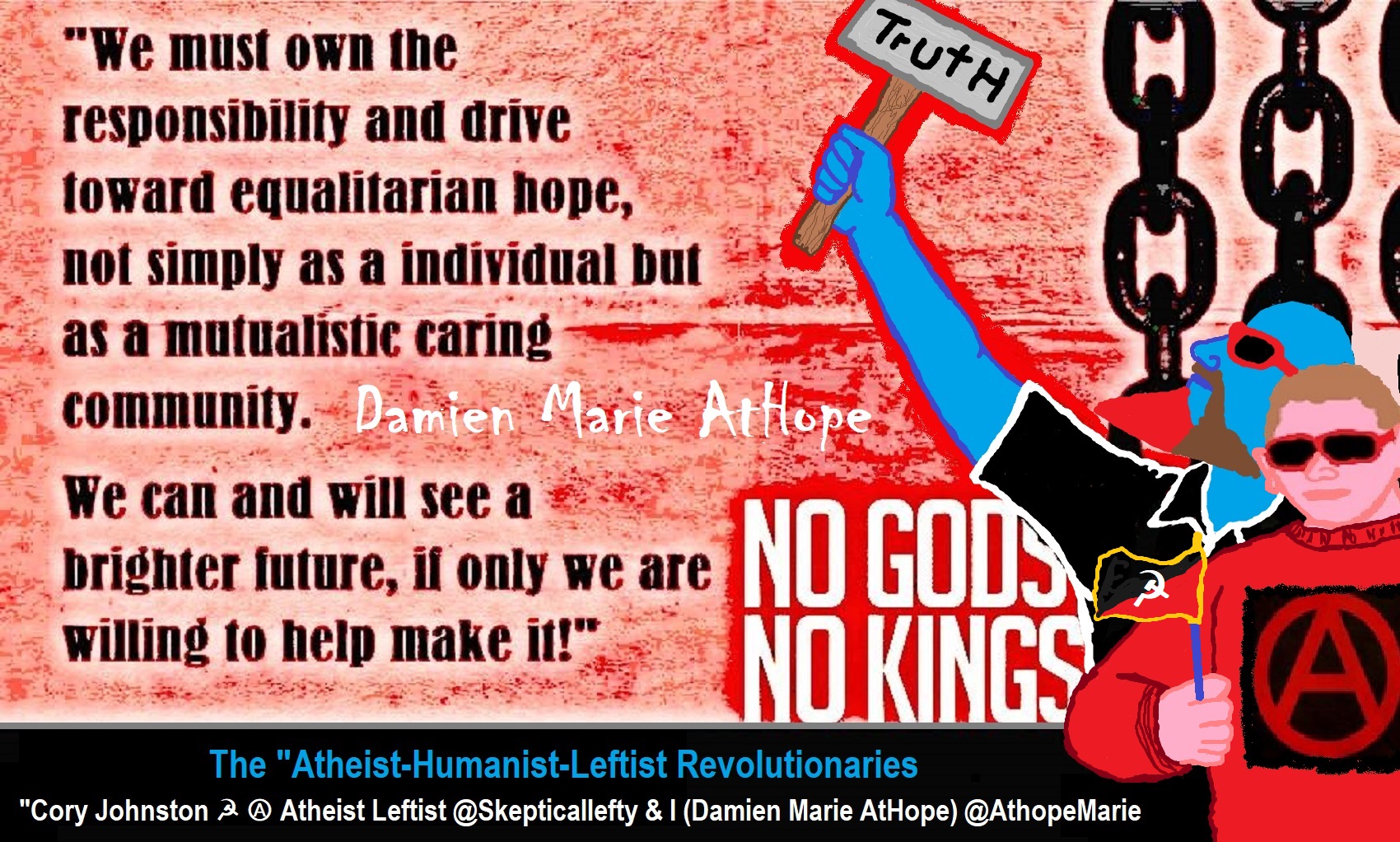
While hallucinogens are associated with shamanism, it is alcohol that is associated with paganism.
The Atheist-Humanist-Leftist Revolutionaries Shows in the prehistory series:
Show two: Pre-animism 300,000 years old and animism 100,000 years old: related to “Anarchism and Socialism”
Show tree: Totemism 50,000 years old: related to “Anarchism and Socialism”
Show four: Shamanism 30,000 years old: related to “Anarchism and Socialism”
Show five: Paganism 12,000 years old: related to “Anarchism and Socialism”
Show six: Emergence of hierarchy, sexism, slavery, and the new male god dominance: Paganism 7,000-5,000 years old: related to “Anarchism and Socialism” (Capitalism) (World War 0) Elite and their slaves!
Prehistory: related to “Anarchism and Socialism” the division of labor, power, rights, and recourses: VIDEO
Pre-animism 300,000 years old and animism 100,000 years old: related to “Anarchism and Socialism”: VIDEO
Totemism 50,000 years old: related to “Anarchism and Socialism”: VIDEO
Shamanism 30,000 years old: related to “Anarchism and Socialism”: VIDEO
Paganism 12,000 years old: related to “Anarchism and Socialism” (Pre-Capitalism): VIDEO
Paganism 7,000-5,000 years old: related to “Anarchism and Socialism” (Capitalism) (World War 0) Elite and their slaves: VIEDO
Paganism 5,000 years old: progressed organized religion and the state: related to “Anarchism and Socialism” (Kings and the Rise of the State): VIEDO
Paganism 4,000 years old: related to “Anarchism and Socialism” (First Moralistic gods, then the Origin time of Monotheism): VIEDO
I do not hate simply because I challenge and expose myths or lies any more than others being thought of as loving simply because of the protection and hiding from challenge their favored myths or lies.
The truth is best championed in the sunlight of challenge.
An archaeologist once said to me “Damien religion and culture are very different”
My response, So are you saying that was always that way, such as would you say Native Americans’ cultures are separate from their religions? And do you think it always was the way you believe?
I had said that religion was a cultural product. That is still how I see it and there are other archaeologists that think close to me as well. Gods too are the myths of cultures that did not understand science or the world around them, seeing magic/supernatural everywhere.
I personally think there is a goddess and not enough evidence to support a male god at Çatalhöyük but if there was both a male and female god and goddess then I know the kind of gods they were like Proto-Indo-European mythology.
This series idea was addressed in, Anarchist Teaching as Free Public Education or Free Education in the Public: VIDEO
Our 12 video series: Organized Oppression: Mesopotamian State Force and the Politics of power (9,000-4,000 years ago), is adapted from: The Complete and Concise History of the Sumerians and Early Bronze Age Mesopotamia (7000-2000 BC): https://www.youtube.com/watch?v=szFjxmY7jQA by “History with Cy“
Show #1: Mesopotamian State Force and the Politics of Power (Samarra, Halaf, Ubaid)
Show #2: Mesopotamian State Force and the Politics of Power
Show #3: Mesopotamian State Force and the Politics of Power (Uruk and the First Cities)
Show #4: Mesopotamian State Force and the Politics of Power (First Kings)
Show #5: Mesopotamian State Force and the Politics of Power (Early Dynastic Period)
Show #6: Mesopotamian State Force and the Politics of Power
Show #7: Mesopotamian State Force and the Politics of Power (Sargon and Akkadian Rule)
Show #9: Mesopotamian State Force and the Politics of Power (Gudea of Lagash and Utu-hegal)
Show #12: Mesopotamian State Force and the Politics of Power (Aftermath and Legacy of Sumer)
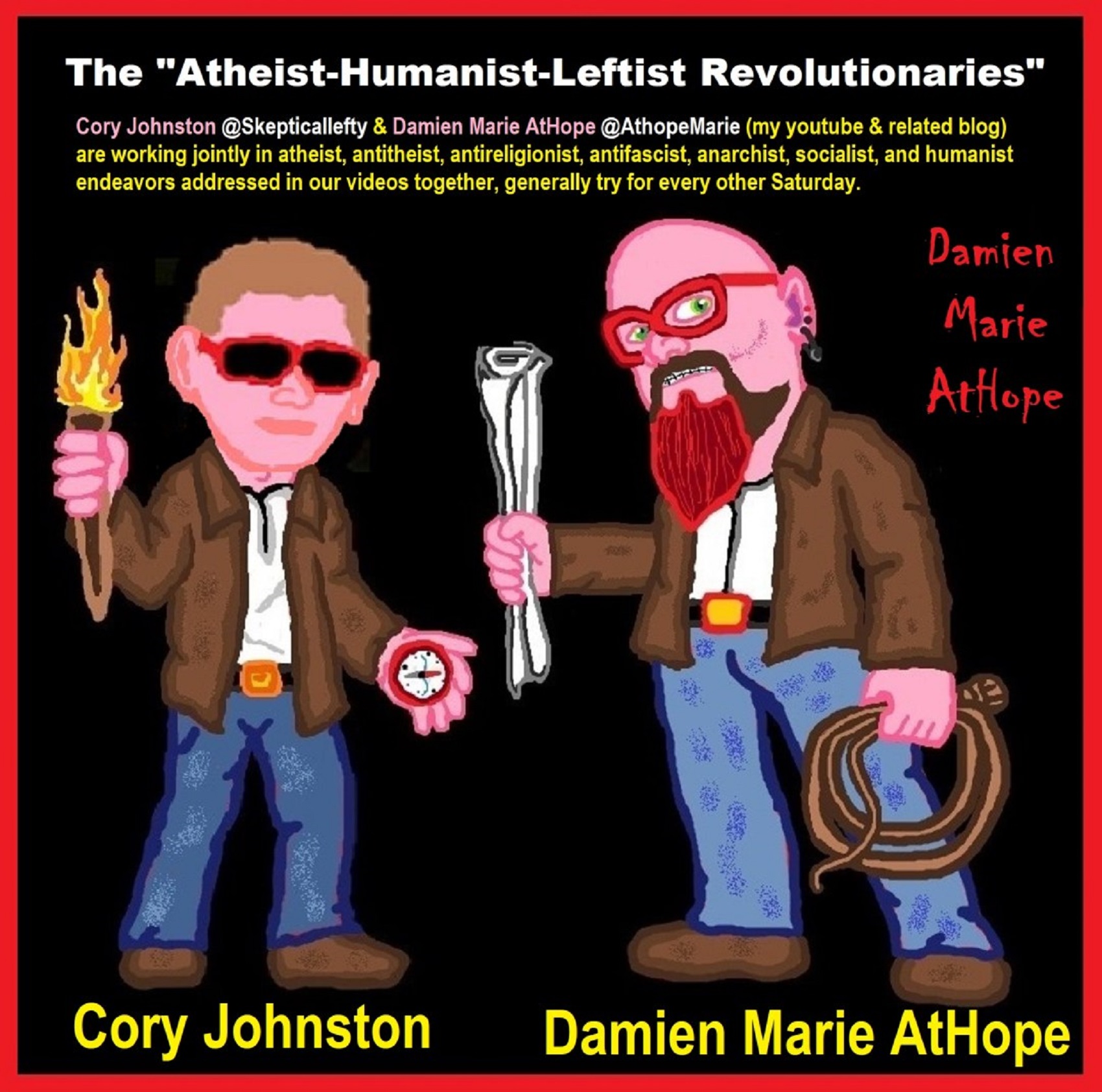
The “Atheist-Humanist-Leftist Revolutionaries”
Cory Johnston ☭ Ⓐ Atheist Leftist @Skepticallefty & I (Damien Marie AtHope) @AthopeMarie (my YouTube & related blog) are working jointly in atheist, antitheist, antireligionist, antifascist, anarchist, socialist, and humanist endeavors in our videos together, generally, every other Saturday.
Why Does Power Bring Responsibility?
Think, how often is it the powerless that start wars, oppress others, or commit genocide? So, I guess the question is to us all, to ask, how can power not carry responsibility in a humanity concept? I know I see the deep ethical responsibility that if there is power their must be a humanistic responsibility of ethical and empathic stewardship of that power. Will I be brave enough to be kind? Will I possess enough courage to be compassionate? Will my valor reach its height of empathy? I as everyone, earns our justified respect by our actions, that are good, ethical, just, protecting, and kind. Do I have enough self-respect to put my love for humanity’s flushing, over being brought down by some of its bad actors? May we all be the ones doing good actions in the world, to help human flourishing.
I create the world I want to live in, striving for flourishing. Which is not a place but a positive potential involvement and promotion; a life of humanist goal precision. To master oneself, also means mastering positive prosocial behaviors needed for human flourishing. I may have lost a god myth as an atheist, but I am happy to tell you, my friend, it is exactly because of that, leaving the mental terrorizer, god belief, that I truly regained my connected ethical as well as kind humanity.
Cory and I will talk about prehistory and theism, addressing the relevance to atheism, anarchism, and socialism.
At the same time as the rise of the male god, 7,000 years ago, there was also the very time there was the rise of violence, war, and clans to kingdoms, then empires, then states. It is all connected back to 7,000 years ago, and it moved across the world.
Cory Johnston: https://damienmarieathope.com/2021/04/cory-johnston-mind-of-a-skeptical-leftist/?v=32aec8db952d
The Mind of a Skeptical Leftist (YouTube)
Cory Johnston: Mind of a Skeptical Leftist @Skepticallefty
The Mind of a Skeptical Leftist By Cory Johnston: “Promoting critical thinking, social justice, and left-wing politics by covering current events and talking to a variety of people. Cory Johnston has been thoughtfully talking to people and attempting to promote critical thinking, social justice, and left-wing politics.” http://anchor.fm/skepticalleft
Cory needs our support. We rise by helping each other.
Cory Johnston ☭ Ⓐ @Skepticallefty Evidence-based atheist leftist (he/him) Producer, host, and co-host of 4 podcasts @skeptarchy @skpoliticspod and @AthopeMarie
Damien Marie AtHope (“At Hope”) Axiological Atheist, Anti-theist, Anti-religionist, Secular Humanist. Rationalist, Writer, Artist, Poet, Philosopher, Advocate, Activist, Psychology, and Armchair Archaeology/Anthropology/Historian.
Damien is interested in: Freedom, Liberty, Justice, Equality, Ethics, Humanism, Science, Atheism, Antiteism, Antireligionism, Ignosticism, Left-Libertarianism, Anarchism, Socialism, Mutualism, Axiology, Metaphysics, LGBTQI, Philosophy, Advocacy, Activism, Mental Health, Psychology, Archaeology, Social Work, Sexual Rights, Marriage Rights, Woman’s Rights, Gender Rights, Child Rights, Secular Rights, Race Equality, Ageism/Disability Equality, Etc. And a far-leftist, “Anarcho-Humanist.”
I am not a good fit in the atheist movement that is mostly pro-capitalist, I am anti-capitalist. Mostly pro-skeptic, I am a rationalist not valuing skepticism. Mostly pro-agnostic, I am anti-agnostic. Mostly limited to anti-Abrahamic religions, I am an anti-religionist.
To me, the “male god” seems to have either emerged or become prominent around 7,000 years ago, whereas the now favored monotheism “male god” is more like 4,000 years ago or so. To me, the “female goddess” seems to have either emerged or become prominent around 11,000-10,000 years ago or so, losing the majority of its once prominence around 2,000 years ago due largely to the now favored monotheism “male god” that grow in prominence after 4,000 years ago or so.
My Thought on the Evolution of Gods?
Animal protector deities from old totems/spirit animal beliefs come first to me, 13,000/12,000 years ago, then women as deities 11,000/10,000 years ago, then male gods around 7,000/8,000 years ago. Moralistic gods around 5,000/4,000 years ago, and monotheistic gods around 4,000/3,000 years ago.
To me, animal gods were likely first related to totemism animals around 13,000 to 12,000 years ago or older. Female as goddesses was next to me, 11,000 to 10,000 years ago or so with the emergence of agriculture. Then male gods come about 8,000 to 7,000 years ago with clan wars. Many monotheism-themed religions started in henotheism, emerging out of polytheism/paganism.

Damien Marie AtHope (Said as “At” “Hope”)/(Autodidact Polymath but not good at math):
Axiological Atheist, Anti-theist, Anti-religionist, Secular Humanist, Rationalist, Writer, Artist, Jeweler, Poet, “autodidact” Philosopher, schooled in Psychology, and “autodidact” Armchair Archaeology/Anthropology/Pre-Historian (Knowledgeable in the range of: 1 million to 5,000/4,000 years ago). I am an anarchist socialist politically. Reasons for or Types of Atheism
My Website, My Blog, & Short-writing or Quotes, My YouTube, Twitter: @AthopeMarie, and My Email: damien.marie.athope@gmail.com
